Imam Initiative Project on EVAW(IMAMS Role in Elimination of Violence Against Women) 2014 |
Project # 1
Background information:
- NECDO since 2008 is involved with the Imams in three directions:
- The first direction is Role of Imams in the elimination of violence against women, women rights under the support of WISE (ASMA society)
- Second direction is the role of Imams in peace, reconciliation which is extended to 15 provinces of the country more than 1000 Imams are involved in this initiative
- Third direction is building the capacity of the Imams and providing them trainings on human rights, gender, and education to be advocates in their communities in the provinces and the capital. Through “Kramah Network of Advocacy & Human Rights”
- NECDO focus area is Capacity Building, Empowerment, Education, Income generations, and advocacy & Networking since its establishment. The involvement of Imams in the mentioned three directions led NECDO towards solid achievements by positive impact on the change of behavior in the communities where they are active. However, more work is needed in order to reach to the remote provinces in the North East where the child marriage is common and we have to train Imams in those areas to work hard and give awareness to the people on the bad impact of such marriage on the health of the women and the coming generations. In the Western part of the country there is domestic violence against women, increase in the number of women who burn themselves and committing suicide, more imam involvement is required for this in north west the problem of sexual abuse and sexual harassment is dilemma which needs to be addressed from the stages of the mosques and we need more imams to enroll in our network in east and south there is still the issue of honor killing and the exchange marriages which causes obstacles on the way of the progress of women in the social life. Over all, in Afghanistan domestic violence rate is astonishingly increased and honor killing. We need to work more hard through our localized method and Afghanised system of work for developed society based on Gender Equality, respect to women rights, social justice and peace for all.
Current phase activities up date:
Based on the activity plan for the Imam Initiative Project on EVAW Ms. Nargis stanekzai was hired for the project supervisor position on first of April after a formal test and interview was conducted for three candidates. She was give an orientation of the project by the PC (program coordinator) and was given the tasks to do networking with the concerned ministries of MORA, MOWA and Shura of Ulama give them orientation on the project and get their support for the activities. (It has been the law for NGOs to keep into consideration the concerned government institution regarding any activity they do). A formal letter was developed for the mentioned ministries and Ms. Nargis was introduced, copies of the proposal and agreement of the project was also attached based on the requirement of the mentioned institutions. The ministry of religious affairs was asked to introduce 40 Imams from the famous grand mosques in the city from different districts and the ministry of women’s affair and the shura of Ulama provided with a support letter to the project after they heard about it from the manager.
1. Pre workshop Activities:
Based on the rules for NGOs, we have to work with the sector ministry and give orientation on the project to the ministry staff as well as introducing the any activity in a project through a formal letter, so conducting workshop at once is not an easy job there were steps to be taken until Imams workshop was conducted. At first, official letters were sent to Department of Masajids for introducing 100 Imams for the workshop, ministry of women Affairs and Shura of Ulema for supporting the activity.
The department of Masajids of the (MORA) introduced 100 Imams from different districts of Kabul and promised that will also help us in informing the Imams for the workshop. The ministry of women provided us with the letter of support, so each department was contacted many times.
Second training manual were developed in which we focused five core rights of women; right to education, right of inheritance, right of marriage, right of ownership and right of political and social participation, and a chapter was added for identification and how to handle the existing sorts of violence against women in Afghanistan.
40 women who are going to the mosques were selected from different mosques in Kabul, in order to get trained on the issues of women rights and will work in the mosques with other women on the issues of elimination of violence against women and they will communicate the women issues with the imams time to time.
Summary of the Trainings Flow:
The Imams first group workshop was held for two days for group of 35 well known imams took place on
- Training # 1: On 3rd and 4th of May 2014.
- Training # 2: On 2nd and 3rd of August 2014
- Training # 3: On 29th and 30th of November 2014
- There was a training held for women on 5th and 6th of August for 40 women who are commuting to Masjids.
The workshop conducted successfully. The workshops started at 9:00 and ended at 3:00pm each day. Imams had discussion, group work, individual work, etc. and finally exchanged their views with each other. These Imams will guide ordinary people through their Khutbas about women rights and elimination of violence against women.
Methodology:
The training was conducted in a participatory method in which all the participants could share their view on the topics of the training and issues. The methods chosen for the training were ball game, presentation, brainstorming, discussion, group work, individual work, review, questions and answers and evaluation.
Materials and Presentations
Imams were provided with the following materials:
Notebook, pen, stationary kit, registration form, evaluation paper, and training manual on Five Rights of Women,
Presentations were about:
- Methods of Dawah on EVAW
- The consequences of leaving Dawah on EVAW
- what is the need of Dawah on EVAW
- What is the role of women in Dawah and teachings of Islam
- Women’s five core rights in Islam
- Roles of women in social life
The materials that were used during the workshop were: flipcharts, flashcards, markers, ball, LCD, and laptop.
Details
The opening of the workshop was done by Dr. Kakar. He started with praying and welcoming the Imams to the workshop. Dr. Kakar pointed to the Imams and said” it is a matter of pleasure and proud that we have you all here today.
Dr. Kakar clearly introduced the project and said that it has two parts one part for imams and second for sisters. So Dr. Kakar introduced the project and its goals and objectives to the Ulemas. As well as this program is the continouation of the last program this was implemented in Ningarhar.
He added that in this program we train 40 Imams who are well known among the people are trained and at the same time we train 20 youth as monitors. Then Dr. Kakar suggested them to allocate 5 or 10 min of their khutbas to women rights according to Islam.
Dr. Kakar talked about the preparation of the booklet on five rights of women according Quran and Hadith for people to read and get advantage from it. Dr. Kakar continued to his explanation and added that we have also provided one manual regarding Daei and Methods for the promotion of our society through different ways and devices.
Dr. Kakar then mentioned them regarding networking meetings that will be held once in each month that the program until continuous. In these meetings Imams will get together to talk and shares and exchanges view about women problems and will take out solution for these challenges. Then Dr. Kakar told them to feel free, and we will work in brotherhood environment for the betterment of our society.
Dr. Kakar added that” we Ulema who have knowledge are responsible toward this nation and Allah (SWT) to woke up people from the sleeping and rescue this nation from the problems. So this was ours and our funder aims to work together and involve generation in the society responsibilities until we could do something for this suffered nation.
He continued to the process of the work was done for this project. He said that first we started our work by networking with religious department and ministry of women affairs and handed official letters that finally these workshops we could finally conducted. His Excellency said that there is serious need in our society to educate women because these are women who raise children and treat them. If we want to have healthy society we have to teach them.
He increased that the second work we achieve was booklet for teaching common people of our society trough reading those who attend the Friday prayers. As it is clear for everybody that one voice doesn’t make any differences but when it becomes united with 10 other voices then it will have positive affects over people. So when people read this booklet given to them will cause to eliminate violence against women.
Conclusion
The Imams and women workshops were successfully conducted. All the activities and presentation were presented to them, the imams showed their commitment to work for women cause from their respective mosques. During each activity photos were taken.
The Imams made the following reflections:
- Most of the information were new and a few of them were repeated
- The presented information were valuable and worthy
- The information will 100%, 70%, and 50% help us in Dawah for EVAW
- The time for the workshop was less so I learned 80% from it
- It learned me and make me capable to conduct such workshop in Masjid
- This gathering will be effective if it continue in future
- The presented information should be practice and Ulemas should be respected and given honor
- Such programs should be held once in each month
- Such programs should be conducted in each province
- The workshop should be held for longer period of time
- More preparation should be done for the future programs
- Fazal Ghani Kakar explained the issues very clearly I only suggest such programs should be increased in future.
Women participants provided the following responds and reflection about the workshop:
- The workshop was very effective, we could learn lots of things and issues from it
- I suggest that more people should be invited for the workshop or get the advantage of the workshop.
- All parts of the workshop were interested
- Conducting such workshop should be increased
- The workshop was organized perfectly
- Such workshop should be more organized specially for illiterate women
- I can transfer the issue I learnt to my family, friends, classmates, relatives and other people.
- The programs should be spread to far places of the country
- The mentioned issues are practical and applicable
- The interesting part were, group work, women rights presentation part, right of selecting spouse, women right inheritance, narrations about of Mohammad (SW) and Daei.
- We would like to always be invited to such workshops
- The workshop was very effective for the improvement of new generation
- There were social, calm and friendly atmosphere during the workshop
- I learnt in the workshop that Dawah is the duty of every individual, women rights
- I recognize my responsibility toward my religion
- If Islamic teachings are
- I felt responsible toward my society
Direct Impact:
Beside many direct impact of the project the following 2 are the most significant impact of the activities successfully conducted during the year 2014 by NECDO in Kabul province:
- NECDO now has a stronger network of Imams who are well-known to work as advocates for Women Rights from Islamic Perspective and focus their Khutbas and Friday speeches on the core issues of domestic violence and violent traditions.
- Women are now working as preachers of the women rights in the mosques and spreading the knowledge they have gotten in the training to other women in their neighborhood
Afghan Women Voting outreach Program
AWVOP 2014 |
Project # 2
Achievements:
- Provision of 64 workshops for 1600 women activists & Imams in 8 provinces and through the trainees we reached 21600 women & 28, 000 men
- 3 Pashto & 3 Dari religious messages for all over Afghanistan
- Conducting 16 campaigns in 8 provinces for 3200 individuals
- Through monthly massages in Dari & Pashto by famous Imams and women activists we reached to
Thanks to SDC who made us able to be part of this successful process
Summary:
The Afghan elections on April 5 was marked the first democratic transfer of power in Afghanistan’s history. The 2014 elections would also be a milestone for Afghan women around seven million Afghan women were registered to vote, there were three female vice-presidential candidates and a greater percentage of provincial council candidates than ever before are women, which were remarkable. It is also clear that Afghan women still struggle for their basic rights because of insecurity, corruptions, man domination and culture & customary life style. From the other side, low literacy rates, and poor economic condition & confined social life. Afghan women voting out reach increase was a significant achievement in Afghan history with a strong massage “ Afghan Women’s movement is irreversible”
Despite extensive planning and preparation related to election security, the situation in Afghanistan remained volatile. In a country where attacks on candidates are common and the Taliban had issued a warning to Afghans not to participate in the elections, each woman who steps forward as a candidate or a voter would put her safety at risk. Yet millions of women & men took the risk and utilize their voting power. NECDO is proud to be part of this successful process and with financial support of SDC. NECDO part of its moral obligation tries hard to ensure that the hard fought gains that have been won are not rolled back, nor forsaken for political expediency. The future success of Afghanistan will require that the voices of Afghan women be heard, because the future stability and development of Afghanistan will be a direct result of the role they play. They are of immense consequence if women remain as secondary or inactive members it would be half body paralyzed and inactive.
Through implemented project “Afghan Women Voting Outreach Program” NECDO successfully conduct a wide range of awareness raising workshops in 8 provinces for 800 Imams & 800 women activists. Through support of the Imams we farther trained 280,000 individuals in 8 provinces, and by support of women trainees we could mange to farther train 21600 women. Through the Radio nation wide programs at peek hours we could provide wide range of awareness rising for public from Islamic perspective on women’s political participation at least to 3400,000 individuals. Through campaigns in the last two Fridays close to election we conducted physically campaigns in 8 provinces for 3200 individuals about importance of voting out reach by women & men. The Nation wide Radio Campaign for 20 minutes on the last week of campaigns we sent the strong massage of voting outreach was provided awareness for at least 3400,000 individuals nation wide.
We remained committed members of AIEC in 8 provinces where we attended their coordination meetings, distributing their awareness packages and promoting voting out reach through NECDO’s Network of Imams in 15 provinces with more than 1000 Imams. We cordially thank SDC for their financial support and we are also thankful to MoWA & MoRA for provision of all kind of help in implementation of the project. Last but not the least we are thankful from AIEC for their trust and looking forward for a better future for every Afghan women, youths, men, children and aged people from all walks of life and every category of life.
2. Project Background:
Women’s political participation in Afghanistan is similar to one step forward and two step back situation. The achievements with regards to women’s political participation in the last twelve years are significant but the peace negotiation with the Taliban without women’s involvement in the process, is the same as the increase in political conservatism such as the press statement by the Afghan Ulema Council in March of 2012, the election laws on 2010, the stand of parliamentarians against the EVAW Law, and silence of the Afghan government as one of the signatories of to CEDAW are major concerns at present.
Approval of the Afghan constitution in 2004 was a great step forward towards women’s political participation, and a constitutional guarantee that one fourth of the sets in the Parliament will be allocated to female MPs. This legal protection has opened the doors for women to meaningfully participate in elections and to choose their representatives and the right candidates. A research conducted by AREU on women’s participation in the past elections, shows how Afghan women experienced this journey and what a great impact it had on their personal & social lives. The parliamentarian and provincial council elections in 2005, 2009, & 2010 showed that women are able to equally participate like men and run as candidates. This was an encouragement for women to believe in their own capability, which gave them hope for it paving the way for their political participation.
Outreach to female voters is not a new phenomenon in Afghanistan; but they faced with great challenges from cultural and social life perspectives. In main cities, outreach to women has been greater, but in remote areas, majority of women are unaware of elections and their rights such as voting. These challenges included insecurity, economic, social, cultural, and religious constraints, besides lack of awareness about their rights and what impact their vote can make.
3. Project justification:
NECDO as a brick in this society for reconstruction and development understood the importance of 2014 presidential and provincial elections as a gate way to a better future for Afghanistan, especially for women who feared that their achievements of past years will be compromised, as the gradual withdrawal of the International community is underway, as well as the fear that Taliban may be given a role to play in the political set up. Therefore, it’s very important that women as half of the society contribute in the process and through casting their votes, bringing the right people in the office. In the last decade, women movements had major achievements and they should not step back now, rather should ask themselves the question of how they could impact this time.
Gender Equality & Human Rights are the cross cutting issues in NECDO’s program strategy. The proposed project is designed based on our past experience in the field of promoting women’s right and women’s political participation. Throughout the AWVO project we planned to mobilize 800 Imams and 800 women activists in 8 provinces (Kabul, Ningarhar, Wardak, Parwan, Balkh, Herat, Takhar & Badakhshan) of Afghanistan, and use them as important entry points to pave way for women’s participation in the 2014 presidential & provincial election.
The aim was to bring a change in the communities’ behavior through the use of campaign, and community gatherings in order to risen the awareness in the community. The geographic focus for this project was eight provinces, where they would represent the entire Afghanistan. Our expectation was to reach 800 Imams & 800 women activists and by signing MoU between the participants & NECDO we would have reach to 96,000 individuals
We also coordinate with the local Radio, community mosques, and public centers for public awareness in the 8 provinces. We planned to reach out to at least 800,000 women & men. In the last month of the project, we organized 2 Friday’s campaigns by Imams and women trainees and broadcasted their gathering through local radio channels. We also worked to organize gatherings in schools and public spaces for more public awareness.
4. Project description:
Based on the past experience, working in coordination with MoWA, MoHE, MoRA, AIHRC and having more than 1000 Imams in 15 provinces as human resources, NECDO was determined to play its role for the 2014 election by empowering Imams, take advantage of their influence on the community for public awareness, and side by side we planned to empower a group of women social workers to encourage other women to take part in the 2014 election. The proposed project focused on women political participations by mobilizing the communities importance and influential figures such as Imams, men & women Shuras, community leaders and grass roots in very Afghan & localized ways. Mobilizing Imams and utilizing Imam’s power to change community attitude is one of the most successful experience that we have since 2007. We also focused on the importance of community leader’s role in mobilizing communities through communication with their audience. Based on the selected goal & objectives of the AWVOP:
Goal of the Project: Women’s turnout in the upcoming 2014 presidential election increased
Objectives:
- To increase women’s participation by 30% in the targeted areas for the upcoming presidential election, and to educate them on the importance of casting their vote.
- To raise awareness among imams and other community influential figures to pave way for women’s participation in the 2014 presidential election through trainings, campaign and Friday khutbas.
4.2 Expected Outcomes:
The proposed project was designed in line with adoptability of norms in Afghan culture community, where men domination is very strong. We used localized methodology by involvement of the community’s important figures. We with not much financial support or time duration, we were able to reach bigger numbers of audiences directly to 1600 and indirectly more than 96,000 individuals
Using local Radio and mosques will be another strong, free, and trustworthy way to unite the community. This will reach to at least 800,000 individuals just like that.
Organizing Final 2 Friday’s as campaigns for mobilizing community will be another heavy push forward for community to feel ownership of the election and taking part in it and at least 800,000 people will get awareness for the next day of election
5. Details of the project (1st January – 15th April 2014)
- Project staff recruitments: The preparations for the implementation of the project began with hiring qualified staff of trainees and administration. According to NECDO HR Policy announced the vacancies for the post of project manager, project trainers. Fortunately, we were able to hire 4 trainers. We faced problem with receiving a qualified person for the project manager position. We were reluctant to give 70% of this task responsibility to Mr. Fazal Ghani Kakar, program coordinator of NECDO and hire Ms. Husnia Tooba as assistant Manager who was selected based on a written test and an interview contracted by the top management of NECDO. The issue we had with female trainers were that no one agreed to go without Mahram due to very tense security and the harsh winter conditions. NECDO was obliged to take the burden of Mahram for the female trainers as well.
Trainer’s positions were announced through the e-mail group. The written test was conducted on 26th of December 2013, 2 Male Mr. Mohd Naim Qaderi and Mr. Ghulam Mohd Mahmood and 2 female Ms. Jamila Safi and Ms. Pashton Humaira were short listed in the interviews. Mr. Qaderi and Mr. Mahmood were selected as male trainers and Ms. Safi and Ms. Humaira as female trainers. The orientation for the selection was based on the good marks they earned in their written tests and also their experience in teaching and trainings for the last 5 years. Ms. Jamila Safi remained teacher and trainer for 15 years. Ms. Humaira worked as trainer and teacher for 7 years. Mr. Qaderi, in addition to being a qualified writer, remained trainer for 4 years. Mr. Mahmood was a teacher and trainer for almost 17 years. Based on their good experience and high marks on their tests, they were selected for the above-mentioned positions.
- Development of Manual on WPP: NECDO’s key managers hired a consultant (Mr. Hayat Mahmoodi) to compile the already existed material on the issue of women political participation from Islamic perspective and Afghan cultural norms and a comparative study of successful Democracy in Islamic countries, with a special focus on women’s political participation. The specific part of the training manual was on the importance of vote by each and every individual for brining the right person in the main office. Based on the need of different provinces we had to translate the manual in Pashto as well. The manual on the issue of Women`s Right to Voting in accordance to the perspective of Islam, the topics addressed in the manual were focused on women`s Right in social and political participations, the Elite women, Advantages of women political and social participations just in the first chapter. In the second chapter, it focused on the tolerance and cooperation on national and international levels, and the picture that the prophet gave from a real human society. The third chapter mentioned about women`s position in politics in times of prophet, the equal position that Islam has given to men and women in social and political affairs, and women`s role in the spread of ethics in the beginning of Islam. The fourth chapter focused on women`s responsibilities in spreading the virtues, understanding the rights and responsibilities of women. The manual after extensive review was given for printing where by starts the first trainings we got manuals on hand as hand book for trainees to utilize it for more community awareness raising
- TOT for the project staff: The project orientation (goal & objectives of the project and project work plan) was explained in a ToT session with the new project staff in a full day meeting, where Ms. Afghani herself was facilitating the ToT session, in coordination with Mr. Fazal Ghani Kakar NECDO PC, Mr. Abdul Hakim Naseri master trainer NECDO. Ms. Afghani gave orientation on the project objective and activities proposed in a detailed session.
During the TOT the topics of the manual were explained to the trainers, by Mr. Kakar the topics were as below:
- Ulama’s (Imams) and their responsibilities for the belter mat of the society.
- Political participation of women from Islamic perspective.
- Elite women in history of Islam.
- Women`s political position in times of prophet and now.
- Qualities of a successful leader.
- Election in country national law.
- Electing leader from times of prophet till now.
The second day was specified to work on methodologies both Mr. Nassery and Kakar worked with the trainers on participatory methodology explaining them theoretically and practically to the trainers. They also finalized the project work plan, and we decided to start the trainings from Kabul.
5.4. The logistics were simultaneously doing all arrangements: of purchasing stationary, printing of manuals, banners for trainings and any other relevant tasks, each participant was considered a pack of one pen (ball point), one plastic bag, one copy of manual, some flash card, copies of pre – post test, Evaluation, commitment sheet and some white paper. The trainers were in 2 teams each team was purchased a bag to carry all their training materials of flip charts, markers, white board, flash cards, charts, pens, tapes, banners and other required items as camera and administrative papers in.
5.5. Networking with MoRA & MoWA, AIEC, AIHRC, and civil society Organizations: the project manager and project assistant both worked together to get formal support letter from MoRA where beside NECDO Imam’s network we had to have some representative from MoRA, we also had MoWA, through a formal support letter from ministries to its directorate to support NECDO’s activities. We got a signed MoU between AIEC with NECDO for support of the project activities as well as we contacted AIHRC to be aware of our activities. At the same time NECDO team contacted Imams network and also we contacted civil society organizations to support of the activities. At the same time the project manager and assistant were negotiating with MOWA and MORA to provide NECDO support letters to their provincial development, we faced hardship in getting letter, the issue was resolved after meeting was held with the ministries in Kabul and orientations were given to them on the activities and objectives of the (AWVOP) project. It`s after time consuming to make the ministries understand the goal, objectives, and activities of a project. The provincial directors also needed orientation on the goal, objectives, and aims of the project which were explained in detail by NECDO to them after their understanding and satisfaction (each PD) they agreed to be hold the trainings in their directorates, we began simultaneously our communication through a formal letter from NECDO with (IEC) Independent Election Commission for signing the MOU. Our meeting at first was successful, the commission promised to be preparing MOU with NECDO within 5 days, but, letter it got delayed for about 3 weeks, however, our continuous follow up resulted to sign the MOU, in which the IEC had mistakenly mentioned only seven provinces which was later corrected by email and our communication with them, right after signing the MOU, IEC sent their emails to the 8 provinces provincial offices to cooperate with NECDO (although their provincial representation were not so active only they attended the trainings in workshops of Badakhshan and Maidan Wardak provinces
6. Networking Meetings on Provincial levels:
NECDO team before starting their workshops in every provinces, the project manager in coordination with related ministries and commissions, civil society, Imams network & women groups arranged a pre workshop networking meeting where requested to invite active women from the long distance area as well, in order to make women aware of their voting power in far sighted areas. In connection with inviting women from farsighted areas the issue of transportation for male came up and finally it was decided that the nearby paritcipants should be given Afs.500/participants and those going from farsighted locations should be given double Afs.1000 (500 for participants & 500 for Mahram). In total we had only 174 women were coming from far districts and we had 1426 participants (female & male) from centers.
List of Networking Meetings:
| No | Date | No. Of participants | Location | Province |
| 1 | 3/1/2014 | 34 | NECDO office | Kabul |
| 2 | 4/1/2014 | 36 | Hafasa Madrasa | Kabul |
| 3 | 4/1/2014 | 36 | Department of Hajj | Balkh |
| 4 | 8/1/2014 | 34 | Aisha Dorani | Kabul |
| 5 | 26/1/2014 | 35 | Department of Hajj | Takhar |
| 6 | 27/1/2014 | 36 | Department of Women | Badakhshan |
| 7 | 13/2/2014 | 34 | Department of Hajj | Maidan Wardak |
| 8 | 16/2/2014 | 34 | Department of Hajj | Ningarhar |
| 9 | 16/2/2014 | 35 | Department of Women | Parwan |
| 10 | 13/3/2014 | 36 | Department of Hajj | Herat |
7. Capacity Building Workshops:
We Conducting 64 workshops in 8 provinces for 1600 Imams and women social workers based on the work plan time line the project started its workshops from 2nd, January onwards the initial workshop started from Kabul where Ms. Afghani conducted the first workshop in order to have practical work for trainers of the project. Based on the developed training manual we provided 2 full days of training for 800 Imams & 800 women social workers in 8 provinces by a mobile team of trainers.
The trainees were selected from different districts not only center and farther they were supposed to work for sharing the information with others. The trainees were selected through the networking with MoRA, MoWA, AIHRC, AIEC and other civil society and NECDO’s connections. Before workshop in every province we had to organize a face to face networking meetings with women & men from different walks of life for paving the way to have those women from far sighted districts.
The team was divided into one male and one female in each province; the Activities were successfully accomplished as described in the chart bellows. The trainings were arranged 2 days for 25 participants, applying the modern methodology of training
Below is the list of 64 workshops conducted in 8 provinces:
| Province | Date Implementation | Activity | No. Of participants | Sex | Facilitators | |
| Start | End | |||||
| Kabul | 1st – 16th January 2014 | Four 2 days workshops | 100 | Women(Female) | Jamila SafiMahmoud | |
| Four 2 days workshops | 100 | Imams(Male) | Jamila SafiMahmoud | |||
| Balkh | 1st – 16th January 2014 | Four 2 days workshops | 100 | Women(Female) | QaderiHumaira | |
| Four 2 days workshops | 100 | Imams(Male) | HumairaQaderi | |||
| Takhar | 18th January -2nd Feb 2014 | Four 2 days workshops | 100 | Women(Female) | MahmoodJamila Safi | |
| Four 2 days workshops | 100 | Imams(Male) | Jamila SafiMahmoud | |||
| Badakhshan | 18th January -2nd Feb 2014 | Four 2 days workshops | 100 | HumairaQaderi | ||
| Four 2 days workshops | 100 | HumairaQaderi | ||||
| Ningarhar | 4th Feb – 19th Feb 2014 | Four 2 days workshops | 100 | MahmoudJamila Safi | ||
| Four 2 days workshops | 100 | Jamila SafiMahmoud | ||||
| Parwan | 4th Feb – 19th Feb 2014 | Four 2 days workshops | 100 | QaderiHumaira | ||
| Four 2 days workshops | 100 | HumairaQaderi | ||||
| Maidan wardak | 22nd Feb – 11th March 2014 | Four 2 days workshops | 100 | Jamila SafiMahmood | ||
| Four 2 days workshops | 100 | MahmoudJamila Safi | ||||
| Herat | 22nd Feb – 11th March 2014 | Four 2 days workshops | 100 | HumairaQaderi | ||
| Four 2 days workshops | 100 | QaderiHumaira | ||||
| Totals | 64 Workshop | 1600 | 800 Male800 Female | 4 trainers | ||
The Kabul workshop was stared by facilitation of Ms. Afghani on, where the trainers also took part. The workshops were for two full days in NECDO Office where in every workshop we had 25 – 30 participants. In total we covered 120 women from Kabul province. At the same time we conducted 4 workshops for Imams in Kabul province in Golden Star hotel. In the provinces the Imams trainings conducted in DoRA and women trainings conducted in DoWA considering the security issues as well accesablity participants. The provincial workshops conducted by a team of female & male trainers. The first day of the workshop the following activities were inducted:
- Recitation of few vases / conducting pre test
- Introduction to the objective of the workshop
- Introduction among the participant
- Fears and expectations along the roles and regulation of the workshop
- The first day topics introduced to the participants
- The first session was on case study of good & bad leadership (case study of Maroof & Jamila)
- Tea break,
- Continuation of the topics
- Signing the commitment sheet (MOU)
- Evaluation of the Day.
The second day activities were arranged in accordance to the
- Recap of first day activities and lessons.
- Women position in political in times of prophet.
- Elections from time of prophet to date in Islam.
- National law on election.
- Imams and their responsibilities in the upcoming election
- Post test
- Evaluation
- Distribution of IEC posters, stickers and Brochures….
- Selecting contact person
6.1 Terms and condition of the trainings: We had to sign MoU with every individual participant who had to attend the workshop for two full days and at the same time they have to share the information with another community members. For Imam the condition was each Imam had to share the information with at least another 100 Imams and community members and every woman had to share the information with at least 25 other women.
6.2. Methodology of the training
The trainings were conducted in accordance to the modern training methodology, participation of all participants was assured through their methods to take all participant out of silence and absorb their attention to words enlightening their minds on the goal and objectives of the workshop Brain storming as an effective method was applied by the trainers. Discussion and group work methods were applied for sharing the awareness topics of the manual, case study was another method to improve their analytical abilities in the process of election, demonstration and role plays were applied to empower women and enhance the Imams on women participation and increasing their member in the election, presentation and lecture were also utilized during the trainings in order to transfer more information to the participants in short time, using white board, flip charts and flash cards was to stringiness the information in minds of the participant and to cause a change in the behavior of the individuals, in particular the participants who are negative and passive about the concept of women`s participation in the upcoming elections.
6.3. Representations (contact people)
At the end of each workshop we appointed one person on election base to be our contact person, doing follow up with the trainees, reporting to NECDO from the progresses in their villages and districts in the province as well as campaigning for women`s participation in the elections and spreading the knowledge they have gotten during the trainings about women`s right in social and political participation in the light of Islam, Law and international norms at least with 10 more persons by each trainee.
6.4. Banners:
Banners as a tool of better propagation of the main objective of the project were designed in three pieces. One piece bigger in size had the title of the project in three languages Pashto, Dari and English with logos of both NECDO and SDC. The second banner had a quotation from the Quran in which women`s right in the election of a leader and ruler is clearly ratified, this banner was a quotation of one of the famous scholars who is of vast respect among the people proving the women`s participation in social and political affairs, this banner was also developed in Pashto and Dari in order to be understood by speakers of both language, the banner had the logos of NECDO and SDC. These banners were made in three copies for a separate banner was designed and printed for the campaign that announced the campaign by NECDO and SDC. During the training the hall was decorated by all the tree banners in front of the hall and two sides.
6.5. Photography and Recording
The trainings in all the 8 provinces were photographed and the campaigns were recorded in clips. In some of the provinces some of the women due to security reasons or culture excused to take part in the group photos, we were also considering and respecting their concerns.
6.6. Monitoring & Evaluation of the workshops: General views of the participants:
- People are disappointed from the government and they are wiling a change.
- Government failed to motivate people.
- We look forward to clear and clear elections.
- We would like to have a stable, elected and transparent government.
- Women should vote and be part of the political process.
- More workshops on such issues are needed.
- People need right leadership who really bridge people and government.
- We are supporting women`s political participation and particularly this election.
- Women are viewed as: mothers, sisters, wives and future leaders as they start their experience as leaders by leading families. Through this, there’s a high chance for them to also lead and be part of communities.
- The upcoming government must work on the educational, political, economical and security betterment of the country in particular on women`s core issues of rights and eliminations of all sorts of violence against them.
- Imams have a certain responsibility to address the issues related to women rights in their Khutba in view of teaching of Islam.
Imams view on working for the increase of women voters on percentage described in the chart below:
| No | Description | Percentage |
| 1 | Addressing and propagation on women`s participation increase in upcoming election | 45% |
| 2 | Working on individual level with people to improve women`s part in the election | 20% |
| 3 | Analytical discussion on community level about election and women`s voting in view of Islam | 16% |
| 4 | Using media and publication for encouraging women to take part in election | 15% |
| 5 | Answering questions of the people and communities on women`s part in elections | 10% |
6.7. Finding of pre test results which show level of knowledge of participants on the topic:
Based on the discussions, pre-post tests and evaluations we had the following findings:
- Pre – training characteristics of the trainees.
- No Awareness from law: 95% of the participants had no idea from law in participator the election law, which was focused on by the trainers during the sessions and their was much improvement in their knowledge of the law later on.
- No punctuality: On the first day of the training we found that these people did not know the value of time, the trainings focused on the enlightening of the trainees in particular the women to understand the value of time and utilize it for their advantage.
- Less patience and tolerance in the first day
- The other charactering each other and were getting angry by a small gesture or a word of their friend, we tried to work hard despite the short time to make them understand the values of tolerance and patience.
- Partial knowledge and information about women political participation
- Almost 85% of the participants had very limited information from their surroundings and the system in particular the election
- Our focus was to change this through our training sessions and discussion.
- 50% of male participants were against women political participation
- On the first day of the training after we distributed the pre-test papers and collected back, we found that 50% of the Imams were against women political participation. Based on the quotations from Quran and Sunnah we changed mentality of these and proved that women`s political participation, such us election, is proved by Quran as Allah says to his prophet if women are doing (Bayaat) = Select you with your leadership do agree.
- Male interpretations about women political participation was mixed with cultural norms
- Totalitarianism: Almost 15 to 20% of the participants in particularly imams were emphasizing on their own viewpoint and were considering their views valid. This character, was changed after we brought very clear cut quotations, that even prophet was listening to view points of his campaigns and was changing his view point for the view point of others.
Post test findings:
- (Baayat) with them, also we borough very strong practical examples from Bayaat Agaba-Awal and Sanni (First and second Bayaat) in which women joined the social political accord with the prophet in Makkah and Misaq-e-Madina accord women had a clear presence.
- Among the participants particularly in Imams there were same people who wrongly interpreted women`s political participation. They gave priority to cultural norms then the real reaching of Islam. They were using the proverbs “for women is home or grave” others were saying “Is there man starvation that women inters political” a trainee in Takhar said “if women go out of house, mischief will occurs”. After we presented the session on women political participation and its advantages, and we provided with solid reasons and valid quotations from Quran and Sunnah such mentalities were changed. In his post test the man is writing that “ I was ashamed that if any one come to know name of my wife, going for election was far away from my insight. During the two days of workshops I feel proud that my wife name is Khadija and Khadija was name of Holy Mohammad’s wife. We Muslims and no Muslims know her well and we have many good leasson from her life. If I do not allow her to take part in selection of a good leader their will be two curse on me: 1. Allah will be angry at me, 2. Provision of chance for a bad leader. It means my this world and that world will be doomed.
- The network of NECDO’s Imam remained very helpful to change the mentality of Imams coming to workshop introduced by MoRA. The Imams who were pressuring our trainer to accept their mentality our trainers with support of Imams network members could changed the mentality with strong reasoning in a very polite and logical ways, it was another good practical way that those Imams having logical argument with politeness and patience, made the hard liner Imams to re think of their behavior and style. Therefore, in post test opionion
- Disagreement with photography: 18% of the Imams were not agreeing with the photography, they did not want to take pictures or be photographed. We worked on the issue and by the end of the workshop; there were same smoothers in the position of these Imams.
- In women portion, it was also sometimes a problem, but this reason was security only.
- These was much gap between those went to Madrasa and those who got modern knowledge. We found that only classical studies mate the Madrasa learners for from understanding and analyzing the current affairs well, we also focused during our sessions that Imams should improve their modern knowledge and get aware of the development in the world and in particular the new order.
- Most of the participants were for the first time attending such workshop and were less familiar with modern methodologies, the workshop had good impact on their mind and cloud be a good beginning for a change in their ways of thinking and understanding
- In the Imams training session, we found that they have the potential and need little of work to change and improve. The Imams are two characters, soft and hard, valid reason and strong quotation from Quran and Sunnah make them soft and get prepared to change soon.
6.8. Monitoring & Evaluation:
The participants in general had the following views about the effectiveness of the workshops conducted in all the 8 provinces. We conducted written evaluation from all the trainees at the end of workshops and we also consider their pre test & post test papers. Based on the review of Evaluation forms, pre test and post test we get the below chart as result:
Over all view of the participants are in below lines:
- The workshops were good, informative, we now understand from Islamic perspective that women have the right to elect and to be elected.
- The topics and discussions were relevant and well analyzed.
- The participants were given chance to share their views, we liked the methodology applied in these workshops.
- In this project the involvement of Imams was a thoughtful decision and concept, because they are neutral people and their voices are more effective, all people in the communities respect them.
- The political participation of women was an interesting subject of the workshops, in particular to us the Imams, we really needed such information that are cannot find during our studies in Madrasa.
- We as women did not know about the elite Muslim women in their position in the political system in Islam, this workshop has infect been a turning point for us, we will now think differently about our position in the society.
- In this workshop we the Imams understood the real meanings for election, law, democracy and peoples, in the past we lad different understanding and different ideas.
- We in result of the information we got from these workshops will work hard to encourage women be part of this important event, electing a right leader for the future of country our children and their safety.
- Security is our concern, but we will use our mosques as please from wore the message of peace to be given to the nation and even ask the IEC to have some of their poling site inside the mosque.
- The manual gave us the knowledge of years in 2 days; it is effective we will share it with many people as possible.
- Women are half of human community, therefore, they have rights in political participation and it make the political process just and complete.
- Women political participation gives them protection and rights preservation
- In result of (WPP) the society gets stabilized.
- WPP provides women an opportunity to develop and improve in skills.
- Equality and justice will prevail with in the society
- The voice of the deprived class will be heard well.
- Social justice will be fulfilled
- The Sunnah of the prophet will be obeyed.
- The employment opportunities will go higher for women, which will have good impact of family economy.
- The culture of tolerance and patience will develop and get stronger.
- WPP will help with the restoration of peace and development of the country in general.
6.9 Literacy scale of participants
We also kept in mind the level of literacy of the target benefices in order to manage better level of provision of service and below chart shows the catagories of the level of literacy of participants
7. Radio Spots.
Based on a formal contract with Radio Salam Watandar (SW) three rounds of radio spots were recorded each round in 2 languages of Pashto and Dari.
The first spot was recorded with the length of 3.5 minutes in Dari and 3.5 minutes in Pashto total of which comes to 7 minutes 4 Imams Mr. Mohd Ihsan Saiqal and Mr. Mohd Sarwar Tawhidi were invited to record the Dari spots emphasizing on the right of women to take part in the coming elections and have her right as an electoral and candidate based on her position in political participation in Islam. In the same time Mr. Azizurrahman Sediqi and Mr. Salahuddin Hashimi two other famous scholars and Imam spoke Pashto and based on strong quotations from Quran and traditions of the prophet encouraged the people to vote in the coming elections both male and female who have completed the legal age to vote.
These spots were broadcasted in peak hours nationwide in 34 provinces. 10 times in Dari 10 times in Pashto a reputation of 10 times each which in total become 40 times peak hours broadcasting on national level which spread through 34 province in the country.
One male and one female scholar recorded the second round; this spot was also in two languages Dari and Pashto for 3.5 minutes each total of which came to 7 minutes. This spot called on women and men nationwide to vote it is their right in law, Islam and international convention. Women and men have equal rights to vote and can be a vote or voted for. This spot was also broad casted 10 times the reputation in total 20 times on national level peak hours in the morning and evening.
The SW Radio gives us 25% discount and we use the discount for repetition of the spots
The third round was the campaign a spot of 20 minutes was developed out of it SW with a massage by two scholars in both national language which was broadcasted here times nationwide in 34 provinces and with a repetition of 3 more times during peak hours, on the 31st March 1st 2nd of April before the hours of silence.
Time table of radio Salam Watandar:
The feedback recorded by SW showed a vast welcome by the public to the spots on elections in particolored women`s participation in the elections of 2014.
(Index # 1Broadcasting Certificate)
8. Monitoring of Project Manager from the field activities:
The project manager conduct from the workshops which conducted by trainers in all the 8 provinces and major questions he had to consider in his monitoring were the following points:
List of dates of Monitoring by Project Manager:
| No | Date | Location | Province |
| 1 | 1/1/ 2014 | NECDO office | Kabul |
| 2 | 4/1/2014 | Hafasa MadrasaKabul star hotel | Kabul |
| 3 | 5/1/20149/1/2014 | Department of HajjDoWA | Balkh |
| 4 | 10/1/2014 | Aisha Dorani | Kabul |
| 5 | 27/1/20141/2/2014 | Department of HajjDoWA | Takhar |
| 6 | 2/2/20147/2/2014 | Department of WomenDoRA | Badakhshan |
| 7 | 26/3/2014 | Department of HajjDoWA | Maidan Wardak |
| 8 | 22/2/201425/2/2014 | Department of HajjDoWA | Ningarhar |
| 9 | 18/2/2014 | Department of WomenDoRA | Parwan |
| 10 | 17/3/201421/3/2014 | Department of HajjDoWA | Herat |
During the monitoring the following points were observed:
- Did the trainers move in line with Project objectives?
- Increasing women participation in upcoming.
- Provision of training to 100 women and 100 Imam.
- Utilization of the manual emphasizing on role of women in election in view paint of Islam and law.
- Did Networking take place with the PD of MoWA and MoRA and IEC?
The project and program coordinator had done the networking with MoWA and MoRA, both ministries, issued official letters to the concerned provincial department to assist with the introduction of participants to the planned 2day trainings and cooperate with NECDO team in securing the training venues. In some of the provinces we had representatives from IEC such as Takhar, Maidan Wardak, Ningrhar but in rest we had not. In every workshop we had representatives from MoWA & MoRA
- Did the PD of MORA & MOWA provide letter of approval? After the completion of the activity in the province a letter was issued from each department (MoRA and MoWA) approving the successful conduction of the trainings in the province.
- What activity was observed?
Observed the training session of both male and female sections, the male session was conducted in Gulden Star Hotel in Kabul and females were trained in NECDO training hall. I observed the session by all male and female trainers. (The group activities, presentations and discussions) How were the training arranged?
The training were arranged in group of 25-27 participants from the trainees introduced by the concerned MoWA and MoRA departments as well as from Imams network, civil society, lists of participants were sent prior to the training dates by MoRA and MoWA communication was done with participants by NECDO team for confirmation. Trainings were conducted in participator manner in accordance to the timetable.
There were three banners hung in the training halls of both male and female sections. Banner 1 showed the title of the project and logos of SDC and NECDO. The 2 other banners a bit smaller in size were having some messages regarding the election and women’s role in 2014 election. Were the trainees provided with refreshment and food? The trainees were provided with one tea break around 10:00 am with cake and cookies, followed by lunch and them a tea break at 12:15 pm with some sweets.
- What methodology was used during the trainings?
- Presentation, 2- group work, 3- Q+A and discussions, were used by the trainers, the trainings were conducted in good sphere, participants in both training particularly women were taking active part in discussions.
- What materials were provided to the trainees in the workshops?
Each trainee was provided with,
- A pen (ballpoint)
- A not book
- Plastic bag (file)
- A copy of the manual
- Some white paper
- Some flash cards
- Did pre-test & posttest & MoU take place?
Pre-test & posttest were conducted based on the timetable after the introduction on the first day of the training. As well as a posttest was conducted after the conclusion on the second day of every training, also each participant signed the MoU with NECDO to work with 100 more people and share the information with them.
- What was participants’ feedback?
Checking the papers of evaluation, most of the participants, (90 %) showed their satisfaction with the training method, theme and materials. (60%) of the participants asked for more extensive trainings on the issue. 95 % wrote they have come to know about the election and it’s important for women. The Imams showed their support to the program and promised to work from there alters on the increase of women in election during 2014. And we also controlled to have MoU’s of the participants with our trainers
Over all findings of Monitoring by project manager:
Based on the plan the monitoring conducted from the 8 provinces and major findings were as below:
- The trainers were dealing professionally with adult methodology of training (participatory methods)
- The knowledge of trainers on the topic was good
- The trainers were using the hand book topics for the trainings
- The participation was high among the trainees
- Women were showing more interest on the topic
- Imams were less cooperative coming from the MoRA but the Imams from NECDO network played very important role in convincing the new Imams on the board
The challenges monitored in general it was very bad weather condition in Balkh, Badakhshan & Takhar provinces. Due to the security issue and pressure from DoRA & DoWA we had to conduct the trainings inside the DoRA &DoWA building and they had less facilities. We had to provide fuel for heating, gas kit for heating of the hall. Even some of the halls had no chairs, and cotions for the participants.
9. Campaigning:
Right after the compilation of the workshops the campaigns were arranged in the following provinces. Where the two last Fridays 21st & 28th March we organized, through the networking and the representatives we had in each workshops and in Harat one of our trainers, in Badakhshan was Ms. Muhiba Zarani, in Takhar Qazi Delaram, and in Ningrhar Mr. Mahmoodi, and
The campaings were gathering of 150-200 individual (male group & female group) and the gathering started with speeches by famous scholars and community leaders. During the gathering
| No | Province | Date | No. Participant |
| 1 | Kabul | 21-03-201428-03-2014 | 200 Women300 Men |
| 2 | Balkh | 21-03-201428-03-2014 | 200 Women200 Men |
| 3 | Badakhshan | 21-03-201428-03-2014 | 180 Women170 Men |
| 4 | Parwan | 21-03-201428-03-2014 | 300 Women160 men |
| 5 | Maidan Wardak | 21-03-201428-03-2014 | 100 Women200 men |
| 6 | Ningarhar | 21-03-201428-03-2014 | 500 Women100 Men |
| 7 | Herat | 21-03-201428-03-2014 | 200 men200 women |
| 8 | Takhar | 21-03-201428-03-2014 | 100 Women200 men |
10. Comparative study of expected out comes and achievements on the ground:
Afghanistan cannot afford to ignore its women, to slip back into the past, and neglect half of its population. Most importantly, Afghanistan cannot afford to lose the gains of the past decade for to do so would mean it would lose its place in the global community and its regional sphere of influence. Afghans turned out in strong numbers for the presidential and provincial council elections on April 5, with an estimated seven million people casting their votes for the candidates of their choice. The presidential election is Afghanistan’s first ever-democratic transition of power, with current President Hamid Karzai, the dominant political figure of the past 12 years, unable to run again. However, much more is at stake than a power shift from Karzai to whoever succeeds him; the country’s stability after the pending withdrawal of U.S. and NATO forces at the end of 2014, civil liberties, and women’s rights all hang in the balance.
As such, Afghan women took their civic duty seriously according to the Independent Election Commission of Afghanistan, 35 percent of the 16 million eligible voters in 2014 were women. However, with votes still being counted and preliminary results that might lead to a run-off scheduled to be announced, there are now indications that the percentage of Afghan women voters might be much higher.
In 2009, due to security threats and rampant election fraud, only 4.6 million votes were cast from a voting population of 15 million, with women constituting 38 percent of registered voters. In 2004, when the country was filled with optimism and the Taliban threat was minimal, women represented 42 percent of the eligible voting population, and then totaling 12 million registered voters. This election season also featured pictures of female candidates alongside male contenders. That fact alone speaks volumes about the country’s transition from the oppressive rule of the Taliban more than 13 years ago, when women were considered non-citizens and were forbidden to participate in public life.
In 2014, 323 female politicians openly campaigned for seats in the provincial councils, elevating the status of Afghan women in a traditionally patriarchal society. Although there was no female candidate for president, there were three women vying for the position of vice president. Dr. Habiba Sarabi is the most prominent, having once served as Afghanistan’s first female governor in Bamiyan province. Her current bid to become Afghanistan’s first female vice president has been part of an effort to get out the women’s vote as candidates realized they needed them to win.
The top three presidential candidates were vocal proponents of Afghan women’s rights during the campaign season, courting the women’s vote. Top contender Ashraf Ghani Ahmadzai broke tradition by including his wife, Rula, a Lebanese-American Christian, to speak at an International Women’s Day rally, as did his running mate, Uzbek warlord Rashid Dostum, whose wife, Zubaida, also participated.
Because of security problems, most female candidates limited their campaign outings to Kabul. The Taliban had openly threatened to disrupt the election process, saying that they would kill candidates as well as their supporters. The Taliban claimed that the election would be another ploy by the United States to continue its stranglehold of Afghanistan.
A statement posted on the Taliban’s website ordered its fighters to target election workers, election sites, and security escorts given to candidates. Since early February, the Taliban killed nearly two dozen election workers, and the Afghan National Police reported that 24 people were killed and 43 civilians wounded during attacks on Election Day.
Despite claims of fraud and not enough paper ballots due to the high turnout, the presidential and provincial elections went better than expected and should be seen as a victory for the Afghan people More importantly, the elections will determine to what degree the gains of the past decade in women’s rights will be safeguarded during the transition and by the new government. Afghan women worry that those gains could easily be reversed if extremists come back into power, or if Western support dwindles. Those concerns have added urgency to this campaign season for women who are fighting to make their leadership more acceptable in a still deeply conservative society.
11. Achievements of the project (Direct and indirect beneficiaries):
The initial plan was like each Imam has to share the information to 100 individual especially during Friday Khutbas. The women trainees from high schools and CBCs should also take responsibility to share the information with at least 20 other individuals. In order to ensure that the Imams and women trainees keep their promises we appoint a team leader in each workshop and they were voluntarily taken responsibility to go and monitor the trainees about the work they do for information sharing with other community members and to send us report on what he or she observes. At the end of project we have the data that 800 Imam who received trainings with us, they could serve around 350 individuals. We expected 80,000 individual and now our reports shows that 280,000 individual were received awareness by 800 trained Imams in 8 provinces. In every women workshop we had around 5-10 women for whom we had not lunch & transportation cost but they attended the workshops in full and but we have not included their names in our list. There were 224 women extra in our workshops.
We had the expectation that the 800 women trainees will farther shared the information with at least 20 women n total we expected to reach 16000 women. Based on the current data in hand and reports from team leaders the trainees could serve 28000 women.
We planed the have on monthly basis radio massages by Imams & women activists to promote women voting out reach and we planed to have it in 8 provinces of Afghanistan but with a very good deal of SALAM WATANDAR Radio station we broadcasted to 34 provinces in peak hours. The SW Radio give us discount of 25%, based on SW Radio reports they have around 10 millions of listeners and we expect that at least 4 million received our massages.
In the last month of we planed to organize national wide campaign the Imams Friday khutbas be broad casted through local Radio and other media channels. In this way we expect to reach to large number of people by involvement of local Radio stations, mosques, community centers, high schools and universities. The recording of the campaign had to broadcasted to 8 provinces and we expected 800,000 people would have to be benefited. According, the data in hand we have reached to at least 4 millions by Radio and 3200 individuals by physical campaigns in 8 provinces.
After the training sessions the trainers will also go for monitoring of at least 10 locations in each province to see the impact of their trainings and the trainings by the trainees according to a follow up work plan and even in coordination with FIFA the trainers will be going to some polling sights to observe women participation in the targeted areas.
According to Mr. Amar khail head of secretariat office of IEC “ We observed and we received very good feed backs from our field offices about NECDO’s working on AWVOP even more successful than any other implanters even better than The Asia Foundation”
12. Factual Stories:
- Saiqal an influential Imam in Kabul said “If we confine women to their homes and deprive them from their rights it is in fact a slap on face of religion, women can go every where to masques, they can participates in social and political life.” This was supported by other participants in the workshop, today our nation is passing from time tested moment for making our future stabilized and if half of nation does not take part than we may have 50% of future not 100% future”
- In Balkh Mr. Hayatullah one of the famous Imams said, “silence in safeguarding the rights of women is a sin, we are should defend the rights of women, their right to education, rights of inheritance, right of marriage and right to ownership as well as special and political participation is preserved in Islam, we Imams should aware our communities and fulfill our responsibility in front of God Almighty to express the rights of women to them.”
- One of the Imams in Balkh was very extremist and he had hard line stand on women political participation and was denying it in full, our discussions and quotations from Quran and women`s right to participate in social and political life made him silent and an the second day of the training he excused in front of others for the misunderstanding he had so for in the past.
- In Ningarhar on of the Imams who was extremist said, “ Women who get out of home are bad.” He come under the hard criticism of other Imams and the debate become very hard and hash, finally the majority made him take his words in the future, because one of the Imams who got very angry with him said, our waives are also going outside house, they go to market, to hospital, to school so they are not bad, it’s the trust and respect which shapes relation of men & women inside house and outside house.”
- In Parwan, one of the Imams shared his views he said “In the past we were very negative about women, even he said one Khatib in Juma was saying that the word (Zan) women is take from Bezar – which beat, but now we are the advocates for women rights we are working hard to convince the communities in our Khutbas to give women their rights. They are not only half of our society but they are sharing 70% of daily work with us (men)”
13. Challenges:
In general there were no big challenge are obstacles to halt the project, however there are always challenges in Afghanistan for implementers of projects and programs in particular working with Imams and women in the provinces is not as easy task here are some of the challenges, we share.
- The ministry of Haj and Religions Affairs was creating red tapes to delay the issuance of support letter to their provincial departments about AWVOP project, they were reasoning that the minister should first know about all the particulars of the project and will then allow the letter to be issued. Although, we had so we shared all the particulars of the project attached with the letter, they were reasoning the documents are in English, provide us in Dari or Pashto so we had to translate all the papers and provide them for the information. They were keen to know about budget and asking the money for Imams should be given directly to MoRA and ministry distribute the money to Imams. After big some of arguments we had to utilize our personal relationships to get the support letter without paying them some thing in hand
- The ministry of women issued the letters to provincial departments, but they had mistaken in the letter, they mentioned that there will be trainings on gender, so we had to ask them to issue another letter correcting the will be text that in each province 100 women will be trained on the issues related to the elections and their increase in voting. The DoWA were giving us hard time that we had to change the topic of workshop, through coordination with project manager we hold meeting with MoWA to issue us a correct letter
- The MoU we signed with AIEC they also forgotten to mention Herat & Takhar, and again we communicate with them on correction of the MoUs
- The weather conditions were also challenging in particular in the north of the country. However, the teams did have courage our job traveling to Badakhshan, Takhar, Parwan, Balkh, Maidan Wardak, Herat and Ningarhar.
- In some provinces, such as Takhar our team was threatened for the photographs some of the Imams in the workshops denied the photography at first and the trainers had to do a hard job make them understand.
- Some government institutions in particular (ANS) was getting concerned with the gatherings of Imams and women in the provinces, but the team was community and making them understand that it is a pro election program implemented by civil society with understanding of MoRA and MoWA.
- Maidan Wardak the province where every step is a challenge, traveling, staying and conducting a workshop and returning to Kabul were all big challenge well to everyone’s life, but our network of Ulama did a good job security the area and using their inference to control the situation, similar to Maidan Wardak the situation in Ningarhar was not stable and the Ulama network of NECDO their helped in reducing the risk and we kept low profile in our movements and during the travels.
- The timing for the project was very short within period of 3 months doing all the arrangement, communications, networking’s, trainings and travels was a semi marathon for NECDO, however with the grace of God Almighty we could successfully came out the challenges and could computer the task in a better way.
- There was very short time for writing the reports, on the field there was no computer with trainers. They were forgotten some of important points from each workshops
- We had major issue in selction of trainers without Mahram and finally we were obliged to take trainers with Maharam for field work which was extra burden on NECDO
- Selection of Project manager was another bid problem no qualified person was agreed to work for short period of time and we had to take extra burden of work and assigned Mr. Kakar (NECDO) program coordinator to lead the project
- We also faced longer distance issue as the flight in Kunduz and Faizabad were not done due to weather condition than our team was obliged to go to Balkh and than by road to Takhar & Badakhshan which made the journey double
- Due to heavy work and bad weather condition only project manager could go for monitoring not some other key managers
14. NECDO Background in Brief:
Noor Educational and Capacity Development Organization (NECDO) is a non-governmental, non-partial and non-political organization, registered with Ministry of
Economy in 2002 with INO.95. NECDO was established in January 2001 by a group of volunteers to help and support needy Afghan women, youth and children when Afghan nation was passing from the time- tested moments of its history in Peshawar Afghan Refugee Camps.
The destructive civil war has had material and spiritual loses for the nation. NECDO started its activities with smallness of means, and greatness of purpose, which is based on the humanitarian and development assistance. We believe that unity, faith, mobilization & empowerment of Afghan community can reduce the miseries of Afghan nation.
During our social activities in the camps, we realized the need for education, capacity building and income generation projects in order to help our nation with sustainable development; specially educating Afghan women, youth and children were the priorities set forth; with the believe that it’s better to light a candle rather than curse the darkness we initiated several projects successfully.
The encouragement of many individuals and organizations for the successful work gave birth to the idea of formal establishment of Noor Educational and Capacity Development Organization in 2001. Initial step was taken for collection of donations for drought effected people in Peshawar Afghan Refugee Camps for 7,000 families alongside a tailoring class including literacy for widows and orphans so that they are able to find a tool for earning living cost for themselves. Several awareness workshops & empowerment trainings on gender, human rights, Child Rights Conventions were conducted for several Afghan organizations.
In the part of informal educational activities such as English special classes, literacy education, home schools, Quranic education, vocational training, health education. In addition NECDO initiated Nazo Ana Library for spreading culture of reading among women who currently have been equipped with more than 7,000 books on various topics with other modern library equipment’s with its branches in Kabul, Ghazni, Jalalabad and Badakhshan.
NECDO since 2002 has initiated and implemented projects with a special focus on EVAW such as conducting training and awareness programs (including gender, human rights, Child Rights Conventions, psychosocial and peace education, elimination of violence against women, gender and Islam and Islam and Human Rights), professional training in the field of management, finance, and databases and computer applications, small business training for women).
NECDO’s enhancement from relief to development programs that ensure sustainability in long term for women is the focus point with understanding of gender as cross cutting issue through our program and projects in the strategic plan for 2015.
Enhancement for Role of Ulama in Peaceful Transition in AfghanistanERUPTA 2014 |
Project # 3
1.1. Summary:
The report on your hand is about the project “Strengthening TDR Mechanisms and Engaging Imam across 3 Provinces” The project was designed based on the past experience of work with Imams and women social workers. The theory of social change “Focusing on “tipping point” phenomenon which is becoming rapidly and dramatically more common; it can be defined as the culmination of a build-up of small changes that produces a big change. The tipping point, or “turning point,” is the critical point in an evolving situation that leads to a new and often irreversible development. NECDO’s work experience with Imams since 2007 by support of WISE (ASMA Society) and Indonesian Embassy in Afghanistan. The work experience of Capacity Building for more than 2000 Imams and establishment of 12 women unites within mosques in Kabul & Ningrhar. Awareness & mobilizing hundreds of women, men and youths in 15 provinces through workshops, seminars, and media initiatives.
The successful women outreach during election of 2014 by mobilizing Imams and women activist was one of the out standing achievements of NECDO beside many other civil society organizations. The project of “Strengthening TDR Mechanisms and Engaging Imam across 3 Provinces” was another step towards our aim to enhance for promotion of Peace and unity by mobilizing community leaders, religious leaders and women activists. In this project we provide capacity and awareness building on Dispute Resolution, Peace and Women Rights for 262 people (124 Imams and community shura leaders and 138 women activists, teachers and local women shura members) in 12 workshops of three full days. We worked with three existing provincial-level traditional leader networks to provide increased dispute resolution support to provincial and district GIRoA as well as community Shura’s and Jirga. This activity built linkages across the formal and informal law structures through the inclusion of traditional leaders, community elders, district GIRoA and provincial GIRoA. By doing so, this activity strengthen communities desire and capacity to resolve disputes peacefully and promote peaceful transitions. Three Community Working Group consists of active women and men of the trainees were established on provincial level. The CWG structured by the member of working group and now they are successful engage in community awareness raising and conflict management. In order exchange information and establish networking 40 CWG members were invited from Kandahar, Kunar and Kabul for a day of conference and four days of workshop on networking, advocacy and.
The project was successful by a generous support of CCI and monitoring and advises of their team time to time from the project activities. I would like to thank Directorate of Ministry of Religious Affairs, Ministry of Women Affairs’ directorates in three provinces Kabul, Kunar and Kandahar, and Independent High Peace council sectorial offices. Last but not the least, I would like to thank NECDO Capacity building team and their active role for making the project successful, inspite of all the challenges and insecurity risks.
2.1. Project Background:
Approval of the Afghan constitution in 2004 was a great step forward towards women’s political participation, and a constitutional guarantee that one fourth of the sets in the Parliament will be allocated to female MPs. This legal protection has opened the doors for women to meaningfully participate in elections and to choose their representatives and the right candidates. A research conducted by AREU on women’s participation in the past elections, shows how Afghan women experienced this journey and what a great impact it had on their personal & social lives. The parliamentarian and provincial council elections in 2005, 2009, & 2010 showed that women are able to equally participate like men and run as candidates. This was an encouragement for women to believe in their own capability, which gave them hope for it paving the way for their political participation.
Women’s political participation in Afghanistan is similar to one step forward and two step back situation. The achievements with regards to women’s political participation in the last twelve years are significant but the peace negotiation with the Taliban without women’s involvement in the process, is the same as the increase in political conservatism such as the press statement by the Afghan Ulema Council in March of 2012, the election laws on 2010, the stand of parliamentarians against the EVAW Law, and silence of the Afghan government as one of the signatories of to CEDAW are major concerns at present.
Outreach to female voters is not a new phenomenon in Afghanistan; but they faced with great challenges from cultural and social life perspectives. In main cities, outreach to women has been greater, but in remote areas, majority of women are unaware of elections and their rights such as voting. These challenges included insecurity, economic, social, cultural, and religious constraints, besides lack of awareness about their rights and what impact their vote can make.
Afghanistan has a long history of traditional localized, dispute resolution (TDR) mechanisms that communities have used to resolve local conflicts in the absence of effective state mechanisms. These bodies often perform crucial local functions, such as resolving land disputes, reintegrating former insurgents and promoting local governance structures. Dispute resolution is important to assisting development, since a land dispute can cause instability over a large area, leave land undeveloped, undermine livelihoods and create opportunities for those interested in destabilizing the country. Since these TDR bodies are community-based, they are often times highly effective at analyzing the conflict and coming to a resolution that is beneficial to the entire community. In many parts of the country, these mechanisms generally involving local shuras, jirgas or other councils, which have continued to flourish. At times over the past decade they have been threatened by insurgent activity, but in other instances the have actually grown in importance due to the lack of predictable, stable state justice institutions. In many of these instances, particularly in key districts where CCI has been working in the south and east however, their connections to the Afghan government are weak. In such areas where insurgent activity has frustrated traditional state-building approaches, CCI has developed strong relations with local elders who are often key components of the TDR process. Thus, there is the possibility to contribute positively to Afghanistan by supporting these mechanisms and building better links between TDR bodies and actors.
The past four decades of war in Afghanistan has eroded the resiliencies of communities and people in the south and east have become accustomed to living with fear, terror, insecurity and instability.
Moreover, Afghanistan is men dominated and tribal country where religion is all too frequently utilized as tool to deprive women of their rights. Women are considered symbol of family honor and dignity and any step of women, which questions ones family honor and dignity, is unforgettable and severely punished. Therefore, women frequently do not seek to claim their rights, particularly for issues such as family inheritance and child marriage, and are excluded from dispute resolution mechanisms. Since 2007, Noor Educational and Capacity Development organization (NECDO) has been actively working with a network of more than 1,000 traditional leaders across 15 provinces on peacebuilding and violence against women issues. Traditional leaders play a significant role in Afghanistan society from birth through to death and have significant influence across every facet of daily life. Correctly channeled, traditional leaders can play a positive role in shaping positive behavioral change and this is evident from the achievements to date of the NECDO imam network, particularly in the area of child marriages and family inheritance. The network of traditional leaders in Kabul, Kandahar and Kunar stand ready to play a greater role in dispute resolution in their communities. This network of traditional leaders will work with provincial and district GIRoA, community elders and other PDU dispute resolution activities (NAT0036, NAT0037, NAT0044) to strengthen the capacity of all actors across the dispute resolution for a.
Utilized a FOG mechanisms, CCI engaged Noor Educational and Capacity Development Organization (NECDO) to work with three existing provincial-level traditional leader networks to provide increased dispute resolution support to provincial and district GIRoA as well as community Shura’s and Jirga. This activity will build linkages across the formal and informal law structures through the inclusion of traditional leaders, community elders, district GIRoA and provincial GIRoA. By doing so, this activity will strengthen communities desire and capacity to resolve disputes peacefully which, in tirn, will promote peaceful transitions.
4. Project Background:
In line with CCI-Creative`s Program Development Unit (PDU) and discussions with OTI, this activity was identified through the request for Applications (Inclusive Dispute Resolution for Community Cohesion). This activity strengthens the capacity of communities in Kunar, Kandahar and Kabul to address intractable and recurrent dispute. Utilizing a FOG mechanism, CCI engaged Noor Educational and Capacity Development Organization (NECDO) to work with three existing provincial- level traditional leader networks to provide increased dispute resolution support to provincial and district GIRoA as well as community shuras and jirgas. This activity built linkages across the formal and informal law structures through the inclusion of traditional leaders, communities elders, district GIRoA and provincial disputes peacefully which, in turn, promoted peaceful transitions, according to the selected Goal & objectives for the proposed project as bellow:
1- to strengthen community capacities to promote a peaceful transition.
2- to strengthen communities desire and ability to resolve disputes peacefully.
3- To develop training manual on dispute resolution to conduct 3-day training for 120 traditional leaders and 120 social workers in three provinces, to establish three working groups at provincial level to provide support to community shuras and Jirgas as well as district and provincial GIRoA.
The above mentioned project was designed based on the past experience of NECDO working with Imams and local shura on Human Rights, women rights and peace building for the past 9 years
3.1. Summary of the Activities Completed:
The project activities were categorized by four milestone objectives, the first milestone duration was from 22nd, June to 30th October 2014 period of time and the first milestone objectives were the followings:
Objective 1: To ensure activities are implemented in time and are according to the work plans and agreed milestones.
Objective 2: To ensure challenges and problems are reported and addressed in a timely manner.
Activities during the first milestone were conducted:
| Date | Activities carried out |
| 22nd, June | Formally the contract was signed between CCI and NECDO. The Grant Agreement NAT0043 was formally signed between CCI as donor and NECDO as implementing Partner for the activity named: ENHANCEMENT FOR ROLE OF ULAMA IN PEACEFUL TRANSITION IN AFGHANISTAN. This activity will cover three provinces KABUL, KANDAHR & KUNAR |
| 23rd, June | The activity plan was developed in accordance to the milestones agreed upon singing the agreement the core activities |
| 24th, June | Networking: Communication with the concerned Ministries (MOWA, MORA) and HPC |
| 25th, June | Hiring a consultant to develop a manual on PEACE, Conflict Resolution, and Disputes solutions, Human Rights, Women Rights and Role of Ulama in peaceful transition in Afghanistan from the current available resources of NECDO.The available NECDO master trainers were conducted the workshops according to the work plan in four rounds |
3.2. Second Milestone objectives
– Approved training manual outline
– Introduction meetings held with PGs and provincial GIRoA in each of the provinces
– Approved training manual developed
– 4 training sessions across the three provinces
– Approved month 2 implementation report in the provided template
Activities conducted During the Second Milestone
| Dates | Activities |
| Meetings with MOWA:· 6th July 2014· 9th July 2014Meetings with MORA:· 7th July 2014· 9th July 2014· 11th July 2014· 12th July 2014HPC meetings:· 10th July 2014· 12th July 2014 | Based on the plan NECDO held its networking meetings with MoWA, a formal letter was submitted to the ministry of women’s affairs requesting meetings to give them orientation on the goal, objectives and activities of the project in result of which the ministry issued a letter of support to the Provincial Departments in Kandahar and Kunar provinces and promised to take part in Kabul workshops introducing some women to the trainings and being part of the Working Group in the future.Similar to this we had meetings with MORA, we had 4 meetings due to some non relevant demands by MORA (The transportation which was considered for the trainees in budget, they objected as it was not enough for them and they were asking at least 1000Afs to be paid for the participants they introduced) therefore, we had to work hard to convince them and get their support for the project, finally we succeeded to get their letters of support to Kandahar and Kunar Provincial department and agreement to send their imams for trainings.Our meetings with HPC were of no obstacle the only problem was their business and little for meeting, HPC introduced there representatives and members in the three provinces to take part in the workshops. Mr. Shafillah Nooristani, Haji Mohd Ismail Kunar, Mohd Saate Kandahar |
| 1st – 20th July | The manual is developed to focus on three main topics:1. Conflict Resolution which is elaborated by many small sub-topics:a. Definition of conflictb. Causes and roots of conflictc. How to prevent conflictd. Conflict in culturee. Difference between conflict and violencef. Management of conflictg. Kinds of conflicth. Analysis of conflicti. Power and conflict2. Peace under which several sub-conflicts were covered:a. What is peace? |
b. Peace in Islam
c. Hudaibia Peace
d. Benefits of Peace
e. Way of reaching to peace
f. Peace in Afghan culture and tradition
3. Women Rights in Islam. Under this the following topics are covered:
a. Human and Woman Rights in Islam
b. Women in Human History
c. Women in Afghan history
d. Violence against women and its kinds in Afghanistan
e. Right to Education
f. Right to marriage and Kholaa (Divorce)
g. Right of Ownership
h. Right of Political Participation
i. Right of Inheritance
These topics are developed in Dari language and translated in a very smooth literature to Pashto. Beside the manual other training materials, as energizers, role-plays and case studies are developed to made the workshop more effective for the participants.
· The Pashto translation of the topics was also made
· The manual was shared with CCI and after the revision and comments from colleagues from CCI the edited version was given to press
22nd, 23rd July NECDO PC and the consultant conducted toT. The trainers got their two day TOT on the methodologies, project orientation goal and objectives as well as activities of planned, and the topics addressed in the manual 24th– 30th, JulyTraining required administrative arrangements are done for the project, such as attendance sheets for participant, transportation payment sheets, Commitment Sheet to be signed by the Working Group, Evaluation sheets, pre and post test sheets developed2nd, – 14th AugFour rounds of workshop were conducted in Kabul. During the four round of workshops we had 25 individual in each group over all we covered 40 men and 20 female
3.3. The third Milestone objectives:
– 4 training sessions across the three provinces
– 3 provincial-level working groups established and at least one meeting held in each province with provincial and district GIRoA, community elders and civil society to review existing cases
– Approved month 3 implementation report in the provided template
Activities carried out during third Milestone:
| Date | Activities |
| 14th August 201421st August 2014 | Networking with Kandahar Province: NECDO team was sent to Kandahar to do the networking with the PD of MOAWA and MORA in the respective province. The first meeting was took place on 14th of August with the PD of MORA in Kandahar, the letter from MORA was handed over to the Provincial Director of MORA and the project was explained with the activities in plan for Kandahar province, the PD of MORA welcomed the initiative and showed their full support with the workshops and appointed their administration to prepare the Ulama, youths and community leaders to attended the Workshops.Meeting with PD of MOWA took place on 21st August 2014 NECDO team leader Mr. Nasir Ahmad presented the support letter from MOWA to the Provincial Director and explained about the goal, objectives of the project, the initiative was also welcomed by the director, she showed her full support to the project and appointed her administration to arrange the participants women activists, women leaders, teacher and members of local shuras to take part in the trainings. |
| 16th -28th Aug | Four round of workshops in Kandahar province 2 workshops of 3 days were conducted for male in the PD of MORA in Kandahar, considering the modern methodology of training, pre-post tests, evaluations were conducted2 workshops of 3 days each were conducted for women in the PD of MOWA in Kandahar considering all the participatory methods in the workshops |
3.4. The fourth Milestone objectives:
– Fourth case study/scenario workshop held in each district
– One jirga in each district held and endorsement sought from district government
– Closing ceremony held in each district
– Approved final report submitted
The activities carried out during the fourth milestone:
| Dates | Activities |
| Networking with Kunar Province: NECDO team was sent to Kunar to do the networking with the PD of MOAWA and MORA in the respective province. The first meeting was took place with the PD of MORA in Kunar, the letter from MORA was handed over to the Provincial Director of MORA and the project was explained with the activities in plan for Kunar province, the PD of MORA welcomed the initiative and showed their full support with the workshops and appointed their administration to prepare the Ulama, youths and community leaders to attended the Workshops. | |
| 2nd, -15th Sep | Four round of workshops for 60 male & 40 female in Kunar province |
| Community Working Group meeting: Throughout the project we had three working group meeting in each province. The first working group was held in Kabul with a group of —– participants. The second working group was held in Kandahar with a group of —– male & —- femaleThe third working group was held with a group of —– male & —- female | |
| Three round of field monitoring was conducted through out project life by the project manager |
3.5. Fifth Milestone objectives:
- To exchange & inter link the groups, share information, knowledge and experience among 3 provincial Working Group members for promotion of peaceful transition
- To organize 1 day of conference and 4 days of workshops on Advocacy, networking, Human rights conventions, national laws and advance conflict management
- To find a mechanism to Inter link the Provincial CWG members with each others
Activities Carried out During the Fifth Milestone:
| Date | Activities |
| 1st -10th Oct | Communication and networking |
| 1st– 10th Oct | Development of conference training materials |
| 19th – 21st Oct | Community Working Group Conference |
| Final report development |
4.1. Direct Beneficiaries in 3 province Kabul, Kandahar and Kunar:
Location: (Kabul)
| No | Training Start Date | Training End Date | No. Male Participant | No. Female Participants | Total No. Of Participants |
| 1 | 2nd August 2014 | 4th August 2014 | 9 | 11 | 20 |
| 2 | 5th August 2014 | 7th August 2014 | 12 | 14 | 26 |
| 3 | 9th August 2014 | 11th August 2014 | 10 | 14 | 24 |
| 4 | 12th August 2014 | 14th August 2014 | 13 | 13 | 26 |
| Total: 96 (16 increased) | |||||
Location (Kandahar):
| No | Training Start Date | Training End Date | No. Male Participant | No. Female Participants | Total No. Of Participants |
| 1 | 16nd August 2014 | 18th August 2014 | 22 | 22 | |
| 2 | 19th August 2014 | 21th August 2014 | 18 | 18 | |
| 3 | 23th August 2014 | 25th August 2014 | 23 | 23 | |
| 4 | 26th August 2014 | 28th August 2014 | 21 | 21 | |
| Total: 84 (4 increased) | |||||
Location (Kunar) :
| No | Training Start Date | Training End Date | No. Male Participant | No. Female Participants | Total No. of Participants |
| 1 | 2nd September 2014 | 4th September 2014 | 20 | 20 | |
| 2 | 6th September 2014 | 8th September 2014 | 22 | 22 | |
| 3 | 10th September 2014 | 12th September 2014 | 20 | 20 | |
| 4 | 13th September 2014 | 15th September 2014 | 20 | 20 | |
| Total:82 (2 increased) | |||||
In all the three provinces the workshops were conducted as mentioned in the details below:
5. 1.The Methodologies used in the Trainings
During the training modern participatory methodology was utilized by the trainers as mentioned below:
- Role plays
- Discussion
- Demonstration in introduction and Recap of the each last day activities
- Group Work
- Case Study
- Lecture
- Q+A
- Brain Storming
5.2. The training Materials
- Marker, Marker Board
- Flip Charts
- Flash Cards
- White paper
- Manual
- Note books
- Pens
- Plastic Bag
6.1 Short review of the content of the three days of workshop on provincial level
6.1 The workshop First Day:
After the primary steps of the program, workshop continued as following:
“Conflict Resolution” was the first topic of the day that was explained by Mr. Naeem Qadiri. The various methods and techniques were used by Mr. Qadiri for explaining the topic through participation of the participants
Later, the “understanding and management of conflict” was explained, by Ms. Naseema in different methods, and from 10:15 AM to 10:30 AM the tea break were given for refreshing the participants
Topic Presentation:
After the tea break, firstly, a show was presented to the audience by two participants with the help of one of the host, which was very interesting and beneficial.
During the show, two persons’ hands were knotted with each other with a scarf and these two hands had to be separated without the help of any third party. This show was organized by Mr. Nasir Ahmad which was very beneficial and interesting to the participants and it was having predetermined objectives. The show proved that every complicated conflict has got a logical solution.
A talk on “Analyzing a Conflict” was presented by Mr. Qadiri his ideas were explained by the help of different methods and techniques, and after responding to the questions of participants’ the discussion ended at 11:45 AM.
Afterwards, Mr. Qaderi presented the topic of “Identity and Conflict”, where he used various methods to present his ideas for the participants.
“Power and Conflict” was the topic that was presented by Mr. Qaderi, which continued till 12:15 PM. Mr. Qaderi used the various techniques to conclude his speeches appropriately.
From 12:15 PM to 1:15 PM the lunch and Namaaz breaks took place for the participants of the workshop. After serving the lunch and praying, the workshop began again and Ms. Nasima Saadat discussed the topic of “Rights and Conflict” in the workshop. The participants were listening to the speakers with great interest.
Afterwards, Mr. Nasir Ahmad who is a teacher discussed the topic of “Identity and Conflict”. This topic was presented through various beneficial methods and ended at 2:30 PM. From 2:30 to 3:00 PM the workshop discussions were summarized and the first day of the workshop concluded accordingly.
6.2. The workshop Second Day:
The workshop started at 8:30 AM according to the schedule. At first the holy verses of Holy Quran was recited by one of the participants whose name was Ms. Leema and later the participants’ attendance sheets were signed and the help of a ball conducted an overview of previous day. Each of the participants talked about the important points of the previous day by throwing the ball to the next participant.
The second day topic of the workshop was about “Peace and Resolution Learning”. At first Mr. Qaderi talked about the importance of peace and peace itself. The topic was discussed from every dimension. Later Mr. Nasir Ahmad talked about “Peace from Islamic perspective” and “Peace in light of Verses of Holy Quran”. While explaining peace from Islamic perspectives he said that “peace means Islam and Islam means peace”. These talks continued from 9:00 AM to 9:50 AM.
Then Mr. Qadiri discussed the topics of “Hudibiya Peace” and its Messages and Outputs. Different techniques of conflict resolution and peace building of Prophet Muhammad (PBUH) was shared with the participants, and finally this discussion ended at 10:15 AM.
From 10:15 AM to 10:30 AM the tea break started.
Later the topic of “Best Ways of Peace-building” and “Peaceful Society and Peaceful Life” was discussed by Mr. Nasir Ahmad . This discussion ended at 11:30 AM. Mr. Nasir Ahmad discussed these topics through a session of questions and answers.
Later Ms. Naseema Saadat discussed about “Peace Procedures” thoroughly. His discussion concluded at 12:15 PM.
From 12:15 PM to 1:15 PM the lunch and Namaaz breaks began.
At 1:20 PM Mr. Nasir Ahmad discussed about “Characteristics of a Peacemaker” by the help of groups of participants. Each group shared their views through the help of their group leaders. The discussion ended at 2:30 PM.
Furthermore Mr. Qaderi discussed about “Signs of our Peaceful Culture” and finally the second day of workshop was summarized.
Topic Presentation:
At the end of the day, a show was organized and presented for the participants. The explained case during the show was about a dry mulberry tree situated in front of a mosque. A conflict had taken place between a local commander and a local leader, which brought negative outcomes for the villagers, that lastly the villagers solved the conflict through a Jirga (meeting). During the show a conflict was introduced to the participants and they were distributed into three groups – two opposing groups and a group for conflict resolution. The solved conflict affected the participants’ way of thinking about conflicts.
At the end of presentation, Ms. Naseema saadat summarized the talks. Afterwards he started to analyze the day’s talks through distributing a paper to the participants. The paper had a sign of hand on it where each finger of a hand had numbers. Each participant had to write the learned points on that paper within the area of the hand on that paper. The papers were later collected and the second day of workshop concluded.
6.3 The workshop Third Day:
The third day also started as per the schedule at 8:30 AM. For beginning the workshop day, Ms. Safeia recited verses of Holy Quran. Later the previous workshop was overviewed and each of the participants was asked to say five important points about previous workshop.
Afterwards Mr. Qaderi discussed the topic of “Women Rights from Islamic Perspective”. Then “Women Rights History” and its related topics like marriage, its reasonable methods, inappropriate marriages and Ms. Naseema Saadat discussed its inappropriate outcomes. He used different techniques like questions, answers, and other activities to present his thoughts.
Afterwards, Ms. Naseema Saadat talked on “Glance of the Current Violence against Women in Afghanistan”. The help of sharing the ball with every participant also presented this speech. The participants were distributed into two groups (female and male) and the groups were connected to make a complete circle and by passing the ball by the host, the group members had to say few words about the violence against women. Each of the circle members expressed their thoughts about violence against women turn by turn. Later the participants came to the class again and talked more about the ways of stopping violence against women.
A family show was organized related to violence against women. This exhibition was presented to the participants and the participants were requested to solve the matter by establishing councils/groups. The participants were divided into two groups for discussing about the matter and later a group was created to act as a peacemaker. The participants appreciated this issue.
From 10:15 AM to 10:30 AM the tea break began.
At 10:30 AM Ms. Naseema Saadat started to talk about a new topic which included the five following basic rights of women:
- Marriage and deposition rights
- Signet (Dowry) rights
- Property rights
- Education rights
- The political and social rights
After explaining the important points related to the five basic rights, the participants were organized to present their views about these rights. The participants were divided into five groups, each group consisted both male and female and they used from flip charts and markers to present their ideas on a piece of paper. Those groups who finished their tasks quickly; they were requested to present their ideas at first and likewise the remaining groups presented their ideas.
The five groups were presenting the following issues:
First group’s topic: Marriage and Deposition Rights of Women: Speaker: Ms. Spughzmai.
Second group’s topic: Education Rights of Women, Speaker: Ms. MahGul
Third group’s topic: Signet rights of Women, Writer: Speaker: Ms. Parween
Fourth group’s topic: Property Rights of Women, Speaker: Ms. Hajira
Fifth group’s topic: Social Rights of Women, Writer: Speaker: Ms. Brishna
The groups were allowed to have ten minutes for discussing and five minutes for presenting their ideas. This discussion was very beneficial and interesting to the participants. The last five minutes were appointed for summarizing the group work.
From 12:15 PM to 1:15 PM the lunch and Namaaz breaks began.
At 1:15 PM the workshop began again. Mr. Sidiqi talked about “Negative Outcomes of Violence against Women” and explained the matter from Islamic perspective in a broader term.
From 1:45 PM to 2:30 PM Mr. Nasir Ahmad talked about “Advantages of Education for Women”. Later the discussions were summarized.
At last, a group work took place by five volunteers. Later a posttest was given to the participants. Afterwards the participants signed a treaty and the participants and organizers surveyed the workshop.
Finally, the participants received their transportation cost and at 3:00 PM after reciting few verses by Ms. Naseema the workshop ended.
- 1. Findings of the workshop
During the first day of each workshop we got that the level of awareness of the people is very low; still too much time is required for accepting each other; There is distance between the scholars and schools; unfortunately the gender issues are not yet solved in this country; this country is still a male-dominated country; less value is given to the women; the men are not accepting to give away their power that they have gained for years.
Therefore, this gathering of male and female is a worthwhile activity. This gathering will lead our society towards improvement and helps in recognition of rights and values of both genders, as we got this when we were moving towards the end of the workshop on the 3rd day we found:
- Women are in need of such workshops to understand their rights in the light of Islam
- This has been the first time for some of the imams to be in a training with women face to face
- The miss trust among the male and female participants was almost removed by the last day of the workshop
- People are willing to volunteer for the Working Group on provincial level here in Kabul
- There has been positive changes in the mentality of the trainees during the workshops
- Knowledge of participants on conflict management, peace education and women rights in Islam in particular the right of education, right of inheritance, right of marriage, right of ownership, right of political participation increased.
8.1. The fifth Milestone topics:
Based on the plan the following topics were covered during the three day workshop.
- Dispute Resolution:
- Definition of dispute and conflict
- Dispute conflict analyses
- Sources of disputes / conflicts
- Impacts of disputes conflicts
- Causes of disputes / conflict
- Solution to dispute / conflicts
- Stages of solution of a conflict or despute
- Peace and mediation:
- Definition of peace
- What is mediation
- Methodologies of mediation
- Specifications of a peace maker
- Negotiation and challenges
- Negotiation (Jirga – Shura)
- Definition of negotiations
- Types of negotiation
- Preparations for negotiation
- Face to face talks
- Goal and objectives in negotiation
- Effective ways of negotiations
- Advocacy and protection
- What is advocacy
- Basics for advocacy
- Types of Advocacy
- Needs to advocacy
- Indication of problem
- Expansion of relations
- Work plans
- Utilizing media and social network
- Asking the assistance from others
Networking:
- What is networking
- Analysis of social networks
- How to utilize social network
- Impact of social network on the problems
- How to establish a social network
- Specification of a social network
- Some important points to be considered in a network
- Human Rights
- International Human Rights declaration
- Cairo dedaration of Human Rights (Islamic H.R charter)
- Focus on five core Rights of women in Islam.
- Educational
- Ownership
- Social participation
- Inheritance
- Marriage
Workshop of the CWGs in 3 provinces
Kabul:
8.1 Evaluation of the Activity
Conducting this type of beneficial workshops is very useful for the people and they were feeling interesting about the workshop. The topics which were discussed in the workshop were related to the daily activities and daily problems in Afghanistan. The participants were getting good results from this workshop. The workshop has been helpful for maintaining peace in the country. The workshop was beneficial from various aspects for individuals, families, and society as a whole.
9.1 Factual Story
“One of the participants was a scholar who was attending the workshop. He was narrow-minded and biased person. He was avoiding sitting within the ladies line in the class. Later, after discussing with him regarding the issues; he agreed to change his negative ideas to a positive one about women and accepted to sit within the women’s line in the class”.
1- One of the participants Mr. Obiadullah narrated that a women gave birth to a daughter in the hospital when the nurse gave the good news to her father and asked for some tip, the father said of the baby was a boy I would.
2- A participant narrated mat a man had 6 slaughter and his wife was pregnant, when she gave birth it was also a daughter when the man came home and saw that his wife gave birth to another daughter, he packed the baby to the ground and killed her, this man later got mental problem and is now roaming in the streaks of the city.
3- One of the participants Ms. Rabia said regarding the women rights in Kandahar that few years back a woman gave birth to a daughter in the hospital, since the infant was a girl the mother left her in hospital and returned home empty hands.
A nurse from the hospital took the baby and she is now three years old.
9.3. The CWG in Kabul will focus on the following activities in their respective province:
- Establishment of a strong contact group among the districts
- Involvement of Ulama in the city and district level
- Establishment of at least 5 centers in the province on volunteer base
- Conducting regular meetings on monthly basis
- Expansion of the group
Kandahar:
The CWG from Kandahar focused on the points below:
- Strengthening the relation with Kabul and Kunar CWGs
- Conducting regular meetings on two month basis
- Expanding the CWG membership
- Involving Ulama and government bodies in the resolutions of the conflicts and disputes
Kunar:
Kunar CWG camp with the following points.
- Sincere struggle for peace and dispute resolution
- Working in schools and educational institutions
- Establishing relation with similar network and group in the province
- Strengthening ties with local authorities and Ulama.
9.4. Monitoring of the Activities:
Throughout the project life we had three time formal monitoring from the on going workshops the monitoring was conducted by Mr. Nasiri who is monitoring officer of NECDO.
18/08 2014 in Kandahar / 11/08 2014 kabul/ 7/09 2014 in Kunar
| Date | Location | Monitor’s name |
| 11,08,14 | Kabul | Mr. Nasiri |
| 18,08,14 | Kandahar | Mr. Kakar |
| 7,09,14 | Kunar | Mr. Nasiri |
10.1 Findings of the evaluation of the workshops:
Majority of the participants of the conference wrote that there has been significant improvement in their knowledge of the importance of CWGs, Advocacy and work for the elimination of disputes on the local level in their provinces
2. Almost all of the participants from Kandahar wrote that such conferences seminars and workshops are needed to be extended for the districts and rural areas, it was the first time that ulama and imams from Kandahar were sitting jointly with the women and cooperating with each other in the group work.
3. Some of the participants wrote that such workshops and conference would be very beneficial if conducted for high school and university students as well.
4. One of the participants from Kabul CWG wrote that such workshops are needed for the personnel of the two ministries the Defense and interior
5. Majority of the participants wrote on the good methodologies utilized and the way the workshops were conducted, this would lead us how to build the capacity of our members of the CWGs in our provinces
6. One of the participants wrote that the information on Advocacy has been totally new for her and will take the advantage of this information when returned to Kandahar back.
7. The CWGs on the 3rd day developed their work plans to implement when they are back in their provinces, most of the plans focused on the issues of women rights, elimination of violence in their communities, dispute resolutions, and working on peace and national unity.
8. The ulama from Kandahar promised to be cooperating with women upon returning, it was the first time the female participants from Kandahar wrote that the Mullahs expressed their support for the women.
9. The CWGs are more effective because this is a volunteer approach for the dispute resolution on the community level and will be working on the motto of (Khairunnas Man Yanfaaunnas-The best man is the one who is helping others)
10. The majority of the participants wrote that they would be working on individual and collective level to enlarge the CWGs in their provinces.
11. Such initiative is highly recommended for the South, South East and Eastern region of the country.
- We found that all the participating CWG members are willing to work voluntarily they have well educational and reputational backgrounds and are known in their communities.
- We found that that the majority of male members in these 3 CWGs are Ulama and Imams who have good reputation and influence in their villages and mosques.
- Women participants of this workshop were coming from different levels of community as members of CWG and had strong participation and were reasoning technically and logically.
- We found based on the daily evaluations that almost all of the participants were interested in the topics of the conference and were satisfied with the methodology of facilitation.
Attachments:
- List of participants in Kabul, Kandahar, Kunar ERUPTA Workshops
- List of Conference Participants
- Scanned copies of Conference participants attendants
- Scanned copies of final evaluation papers of the conference participants
Women Toilet Need Assessment Report2014 |
Project # 4
2. Background Information
This report on your hand is about a need assessment about the need of construction of women toilets on high ways in Afghanistan. Why women toilet? Access to reliable sanitation facilities could be a game changer and we all know that women’s well being is intrinsically connected to their ability to earn. In war torn Afghanistan, deeply polarized Pakistan and India with its teeming millions, Muslim women – are eager to participate in their local economies. Their ability to earn is what gives them place, position and power in the family. It enables them to participate in key decisions – about their children, their education and their future opportunities. What stops them in many cases are the significant hardships they encounter in getting to and from their workplace given the lack of adequate and sustainable sanitation facilities. IMW has the goal to provide safe, accessible and sustainable sanitation to enable Muslim women to earn a living in Afghanistan, Pakistan and India.
Therefore, NECDO one of partner of IMW in Afghanistan has conducted a need assessment from Kabul high to Torkham, which carries on daily basis thousands of passengers. Tailoring toilets to the needs of the women in the community will be sustainable after the polite phase of the project and will use composting and other alternatives depending on terrain, location and local conditions.
The need assessment was conducted from 7th to 9th June from 100 passengers in two location Kabul Adha (and Jalalabad Adah[1] from 100 individuals (94 female & 9 male), in variety of age from 19- 51 years old on the need of availability of women toilet on the high way with safety, safeguard with hygienic and secure environment, which will be run and managed by women from the same area. The charges upon the utilization of the toilets will be a source of income for the management team as well as a part will be given to maintenance and supplies. We aimed by this need assessment to see how much the idea is practical and how much demand is their for construction of women toilets
Problem Analysis: Afghanistan is a country that has a painful history with suffering from lots of problems during the past dozen of years. During the past four decades of war, lack of peace & security as well as bad economic conditions and social issues people do not have a sigh of relief. Million of dolor invested in Afghanistan in the last decade by support of international community but due to systemic & channelized corruption, and lack of good governance was not best utilized.
Backwardness of our country is having lots of reasons. People in this country, are intending to pass there days and nights with difficulty and many challenges. We are deprived of basic human rights and one of them is lack of availability of safe and hygienic toilets. Most of the homes located either in cities or provinces don’t have the availability of modern toilets. The common toilets, which are situated in the roads, are almost near to the house and/or buildings of most of the citizens affect their daily lives in terms of producing bad smell and UN healthy environment
In 1380 after the collapse of Taliban regime the concerned departments have focused in this regard and two new toilets were built by the support of the Indian government; the first one is located in the west Side of Kabul in the place called “Baba Kedani” and the second one is situated in “Deh Afghan” of Kabul city.
The studies of the history are showing that few decades back there were only three toilets available to the people in Kabul; the first one was situated in Temor Shah Bazaar, the second was in Pol Kheshte mosque, and the third one was situated in the present Cinema Pamir near to the RoadKhana.
Now that the population in Kabul is getting larger these three toilets in Kabul is never enough for three million citizens of Kabul. The high ways, which is used by travellers, has no safe corner for women to be used while travelling to Kabul or back from Kabul to other provinces. There is not only the issue of security but also we have many cultural and customary issues which make travelling for women very limited
3. Method of conducting the need assessment:
The objective of providing this data is focusing to one of the most important topics in the society, which is related to the health and safety of citizens and from the other side, it is related to the discipline and cleanliness of the society. The data available on hand was collected by a group of four surveyors (interviewers) with a specific interview sheets which was pre designed by NECDO key staff and IMW consultation from 100 Individuals from Kabul to Turkham to give their views about different aspects for the need of constructing women toilets. Those people who were asked to answer these questionnaires were from different ethnics, positions, places, and genders that have expressed their ideas with us. This report proves that the full support of both women and men of various ethnics groups, with some additional sub questions, complete this work
Ms. Mariam Sharifi entered the data on database within a period of a week. The final report was done by Mr. Khawja Naim Qaderi and translated to English by Ms. Rubaba Azad
- Main findings of the Need Assessment: the data shows in question 7th that 38% of women are travelling alone which is very interesting for us that in such a insecure condition women travel alone. Than safe toilet is the most important need for women travelers. From the other side the question eleventh shows that 77% of the toilet on the high ways is used by men not by women. Concerning the above points, the Ministry of Transportation never fulfilled its responsibility towards the management and discipline of neither the traffic nor the passengers departments. The interviewees as below point the main challenges faced by the people while traveling from one location to another:
- The roads are not secure. There is no news about those particular polices and/or guides situated on the roads for safety precautions
- There is no access to the proper restaurants, foods, markets, toilets, and soaps, water in the roads. If they exist in some particular places then they will be available only for men not for women.
- Unsafe, unsecure, un hygienic and un protected toilets for women which make its usage a nightmare
- The non-stop points and/or parking are not situated in the roads properly so that the people who were tired while travelling to rest
- There are a few bridges in the roads and bus, cars; people by walk, animals, all are on the same road. Therefore, many accidents happen due to the unavailability of road bridges.
- The public buses and in general all kind of transportation services are inviting the passengers even more than its capacity. This is the main reason that people hate traveling when it comes to travel far distances
- Most of the passenger buses are transferring the business products from one place to another. Therefore, there is less space for services to travelers
- There is only one single point which has women toilet on the way from Kabul to Jalalabad and its not enough for meeting the need of travelers
- The financial statuses of most of the people are very poor in Afghanistan. The expensive charges for the payment of the bills has caused that people should travel based on the very urgent needs
5. Methods of implementation of the Need Assessment
The Need Assessment conducted by Noor Educational and Capacity Development Organization in two locations Kabul & Jalalabad from 100 individuals.
5.1. The Questionnaire: NECDO key manager and Mr. Khwaja Naim worked on development of questionnaire after approval from IMW it was shared with working group. The final decision was made to provide twenty-one major questions with its components and then it was shared in the workshop for Need Assessment
5.2. One-day workshop: was conducted in 5th June 2014 in the NECDO Office. During the workshop the questionnaire was introduced to the team of survey and about the code of conduct to be considered while conducting the interviews. Beside the theory and we had practical work as well, in order to have best results
The following individuals were present in the meeting:
| S. No. | Names and Surnames | Positions |
| 1. | Ms. Jamila Afghani | Head of the Noor Organization |
| 2. | Mr. Fazal-Ul-Ghani Kakar | Program coordinator |
| 3. | Ms. Jamila Safi | Program coordinator of KARAMA |
| 4. | Mr. Abdul Basir Hanifi | Financial assistant |
| 5. | Mr. Abdul Hakim Nasiri | Library project assistant |
| 6. | Mr. Khuwaja Muhammad Naiem Qaderi | Research officer |
| 7. | Ms. Hussnia Tooba | Advocacy and training |
| 8. | Ms. Mariam Sharifi | Project assistant |
The following individual worked for conducting the field interviews
| S. No | Names | Positions |
| 1. | Khuwaja Muhammad Naiem Qaderi | Need Assessment or |
| 2. | Jamila Safi | Need Assessment or |
| 3. | Hussnia Tooba | Need Assessment or |
| 4. | Muhammad Nasir | Need Assessment or |
Planning tasks: based on the below chart was the need Assessment was planed and was carried out
| Dates | Sides | Locations of the Need Assessment |
| 7/6/2014 | South | Provincial, ending point of passengers in the south |
| 8/6/2014 | East | Pul Charkhe, ending point of passengers in the east |
| 9/6/2014 | West | Company, ending point of passengers in the west and south west |
| 10/6/2014 | North | Chamtala desert, the pass of Khairkhana, ending point of passengers in the north |
| 11/6/2014 | Capital of the city | Dahan Chaman, ending point of north side and capital zone |
5.3. Working schedule for conducting field interviews: The need assessment took 5 days in total with working hour of 8:30 am to 4:30 PM including break time of one hour for lunch
In the summary, the four persons who were involved in Need Assessment interviews, were spending five hours of their time to complete the Need Assessment in which having conversation with each individual was taking 10 – 15 minutes. Therefore, it has taken five working days. In total we have conducted 103 interviews and 94 were female & 9 were male. The age of interviewees were from 19 years old to 51 years old. Out of 103 interviewees 54 person were having an income or job and 48 were job less. The marital status of the interviewees is 27 single, 72 married and 3 have not indicated their marital status
5.5. Individual conversation: The assessors were having conversation with each passenger separately in order to know their views about their problems and enjoyments while traveling. The questionnaire was designed with twenty-one questions, which forms twenty-five questions with its components. In this Need Assessment, every individual has expressed their ideas about their problems freely and transparently and the assessors were recording those points into the paper. The people were feeling inspired when hearing about this project as it is one of the needed fields in our country for building new modern toilets mostly for the women and they were hoping that this project could be implemented into the real form as soon as the better.
6. Detailed description of responses to the questions:
The finding of the Need Assessment shows that most of the victims are women who suffer from the unavailability of toilets while traveling from one place to another one. The percentage of people who shared their views with according to each question are indicated in below charts per each question findings
The first question of the questionnaire was about finding that how many women have an income or in other way to see if the can pay for utilizing the toilet. The chart shows out of 100 individuals (mostly women) 47 are having direct income and 53 are jobless but having an indirect income
[1] Adah means bus stop
 The percentage of women traveller who was asked about their problems while seeking for a job: the answer was as bellow. Means that out of 100 people 32% is facing problem for finding an income and 31 has not commented because they had family barriers to go outside home for finding a source of income. It seems that out of 100 interviewees 63 % facing problem to find a source of income.
The percentage of women traveller who was asked about their problems while seeking for a job: the answer was as bellow. Means that out of 100 people 32% is facing problem for finding an income and 31 has not commented because they had family barriers to go outside home for finding a source of income. It seems that out of 100 interviewees 63 % facing problem to find a source of income.
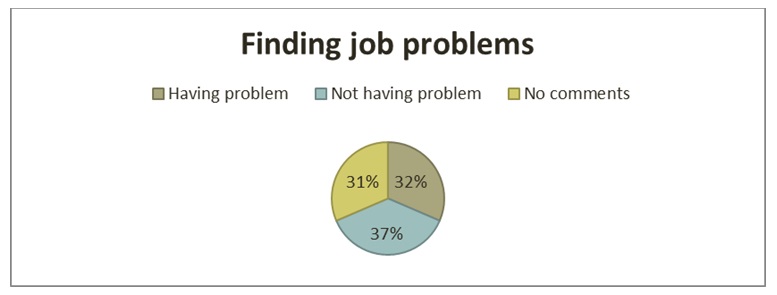 The graph bellow indicate that out of 100 interviewees 73% are in favor of job with an income but 27% also shows interest for volunteer work
The graph bellow indicate that out of 100 interviewees 73% are in favor of job with an income but 27% also shows interest for volunteer work
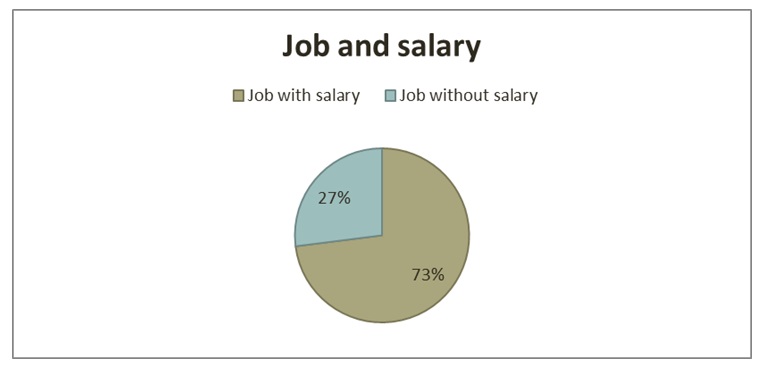 The fourth question theme was to find out about the reasons that why women do not allowed to work outside. The bellow chart shows that out of 100 interviewees 73% are facing family, social and cultural boundaries to have an income
The fourth question theme was to find out about the reasons that why women do not allowed to work outside. The bellow chart shows that out of 100 interviewees 73% are facing family, social and cultural boundaries to have an income
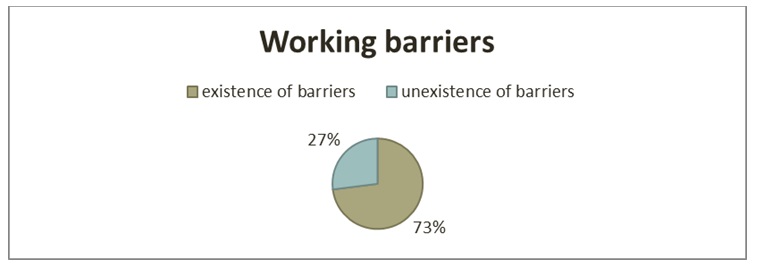 The fifth question were asked about the job nature they like to have:
The fifth question were asked about the job nature they like to have:
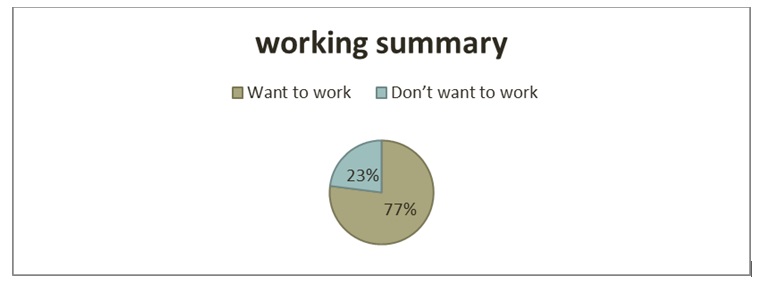 The sixth question was about how frequently they travel? The bellow chart shows that 93% women and men are travelling frequently, which shows the need for more facilities for travellers on the high ways
The sixth question was about how frequently they travel? The bellow chart shows that 93% women and men are travelling frequently, which shows the need for more facilities for travellers on the high ways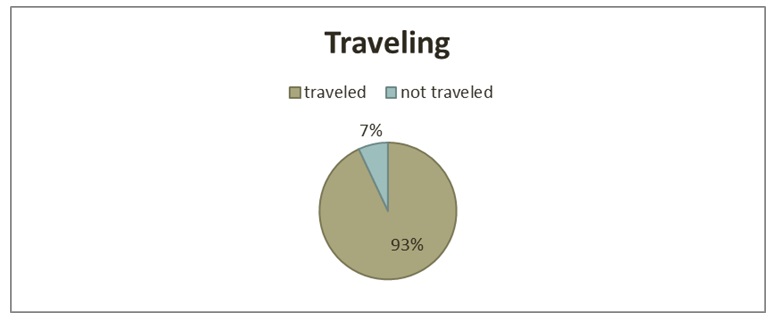 The seventh question was about weather they have a companion while travelling? What is the relation of the companion of the travellers? The bellow chart shows that close family members such as son, uncle, brother, husband are with them. Its also amazing to see that in 38% says they travel alone from Ningrhar to Kabul.
The seventh question was about weather they have a companion while travelling? What is the relation of the companion of the travellers? The bellow chart shows that close family members such as son, uncle, brother, husband are with them. Its also amazing to see that in 38% says they travel alone from Ningrhar to Kabul.
 The eight question were about where do they travel the most, the bellow chart indicate that the travelling to North and West are more frequent
The eight question were about where do they travel the most, the bellow chart indicate that the travelling to North and West are more frequent
 The ninths question were asked about the reasons and purposes that they travel. The chart bellow sows that most of travel are job related, than family issues, treatments to Pakistan and only 17% shows for holidays:
The ninths question were asked about the reasons and purposes that they travel. The chart bellow sows that most of travel are job related, than family issues, treatments to Pakistan and only 17% shows for holidays:
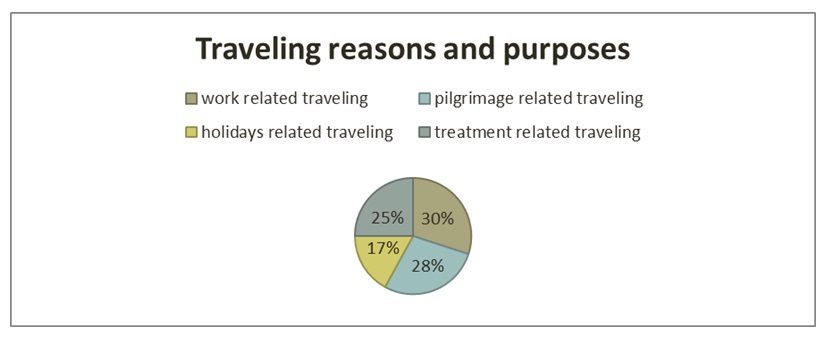 The tenth question was asked about their number of traveling in per year. Its interesting to see 42% has over 10 times of travel and only 10% has travel plan of 2-4 times per year, which shows very common travelling needs:
The tenth question was asked about their number of traveling in per year. Its interesting to see 42% has over 10 times of travel and only 10% has travel plan of 2-4 times per year, which shows very common travelling needs:
 The eleventh question was asked about the distance while they are traveling. The bellow chart indicate that people are travelling in middle distance more frequently:
The eleventh question was asked about the distance while they are traveling. The bellow chart indicate that people are travelling in middle distance more frequently:
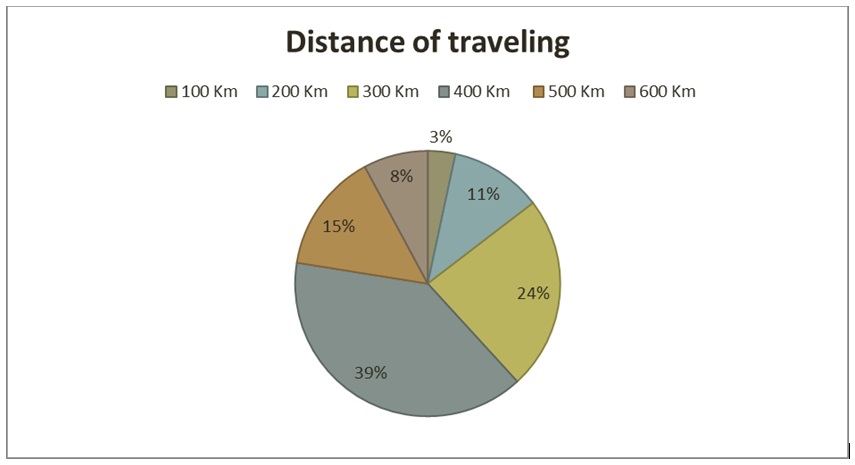 The twelfth question were about how much people travel outside Afghanistan to bordering countries, the below chart shows that travel to Northern & Western parts are very frequently:
The twelfth question were about how much people travel outside Afghanistan to bordering countries, the below chart shows that travel to Northern & Western parts are very frequently:
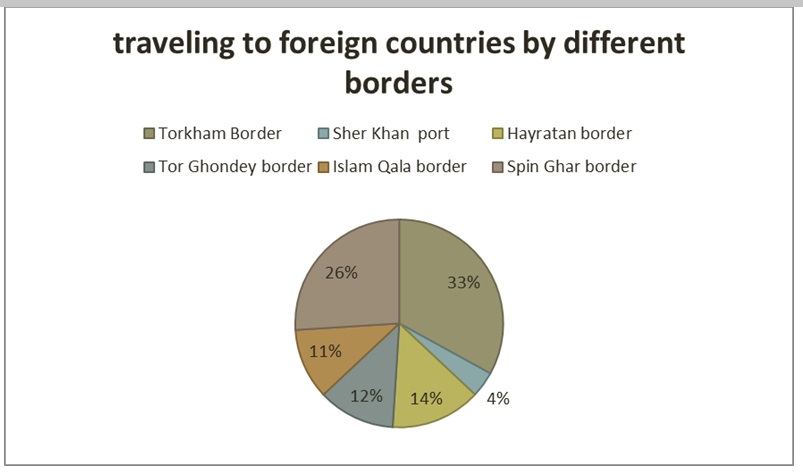 The thirteenth question was asked about gender of their companions while traveling. The chart below shows mostly families are travelling together and some time and its interesting to see that women travel alone percentage shows 13 % which seems high in Afghanistan such a country
The thirteenth question was asked about gender of their companions while traveling. The chart below shows mostly families are travelling together and some time and its interesting to see that women travel alone percentage shows 13 % which seems high in Afghanistan such a country
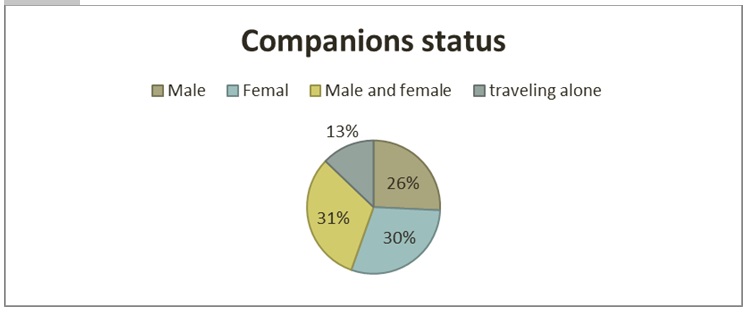 The fourteen question was about the means of transportation using by the passengers are that public buses or private means of transportation. The below chart shows that 73% people use public means of transportation
The fourteen question was about the means of transportation using by the passengers are that public buses or private means of transportation. The below chart shows that 73% people use public means of transportation
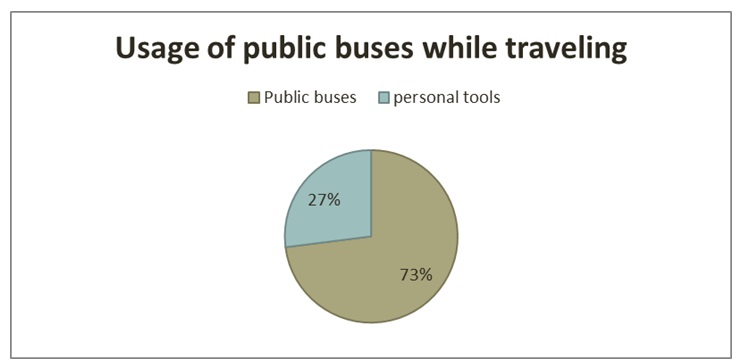 The fifteenth question was about the types of toilets available for the women in the way. The chart below shows that 48% of the people do not have access to toilets, 31% of people has access with very less facilities, and common toilets is available 21%.
The fifteenth question was about the types of toilets available for the women in the way. The chart below shows that 48% of the people do not have access to toilets, 31% of people has access with very less facilities, and common toilets is available 21%.
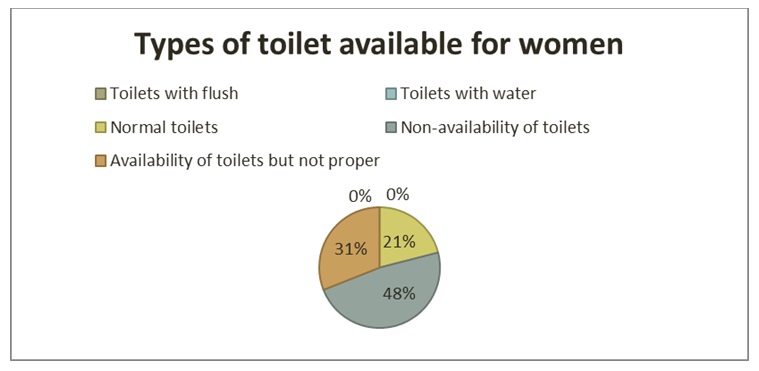 The sixteenth question was about the enough space for the travellers including their companions, the bellow chart shows due to great load on the public transportation families have very limited spaces:
The sixteenth question was about the enough space for the travellers including their companions, the bellow chart shows due to great load on the public transportation families have very limited spaces:
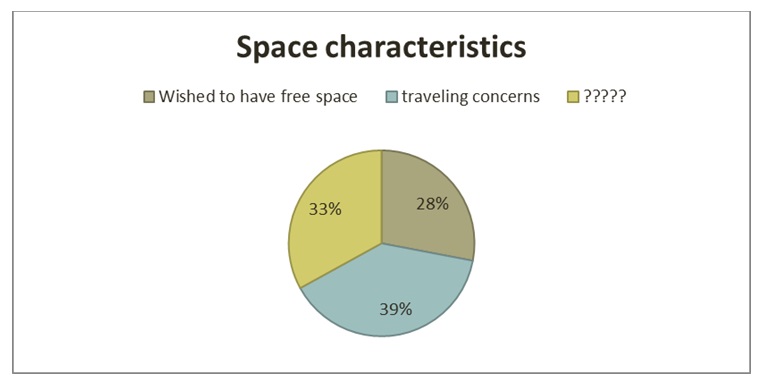 The seventeen questions was about their most important problems while traveling:
The seventeen questions was about their most important problems while traveling:
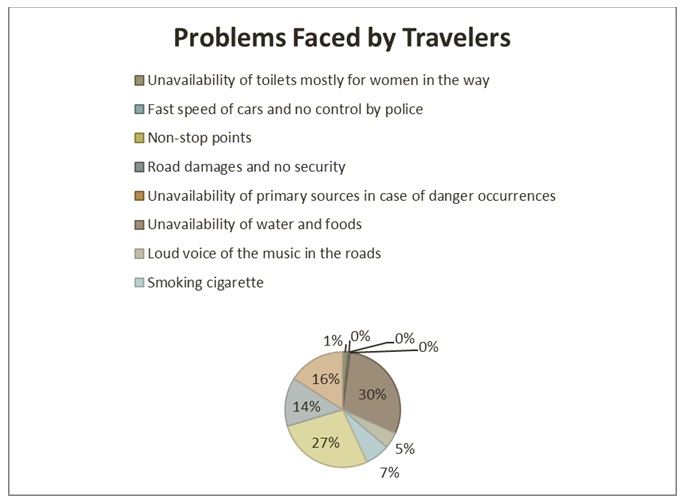 The 18th question was asked whether they need toilets for women while traveling, if yes, why and if not, why:
The 18th question was asked whether they need toilets for women while traveling, if yes, why and if not, why:
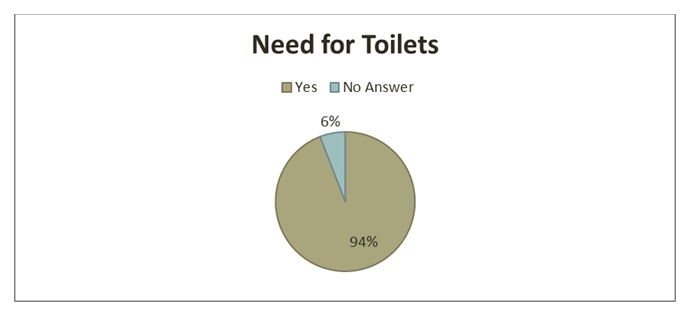 The nineteenth question was asked about the locations of toilets weather it’s easy to access or far from public access. The chart below shows that 77% of:
The nineteenth question was asked about the locations of toilets weather it’s easy to access or far from public access. The chart below shows that 77% of:
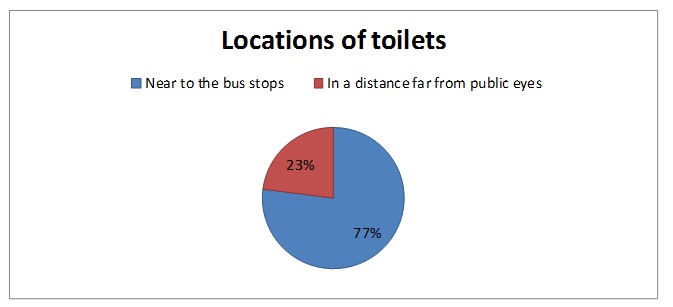 The twentieth question about safety and security to be used and which gendered should be of the women toilets. The chart below shows that 100% men should be out side for security of the outside and women should do cleaning
The twentieth question about safety and security to be used and which gendered should be of the women toilets. The chart below shows that 100% men should be out side for security of the outside and women should do cleaning
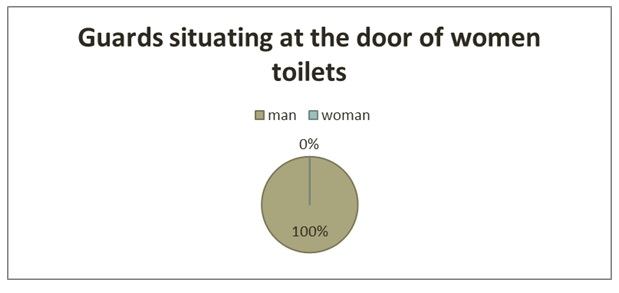 The 21 questions were asked about the types of toilet that they want to utilize. The chart shows that almost 7% of people are in favor of toilets with water, flash and soap:
The 21 questions were asked about the types of toilet that they want to utilize. The chart shows that almost 7% of people are in favor of toilets with water, flash and soap:
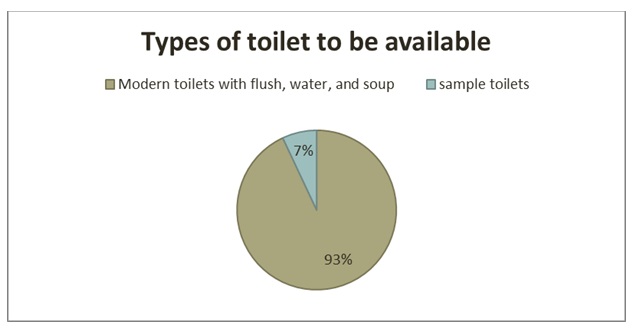 The second part of the question weather you like to pay for using a modern toilet, the chart bellow shows that people want to pay 100% for best services
The second part of the question weather you like to pay for using a modern toilet, the chart bellow shows that people want to pay 100% for best services
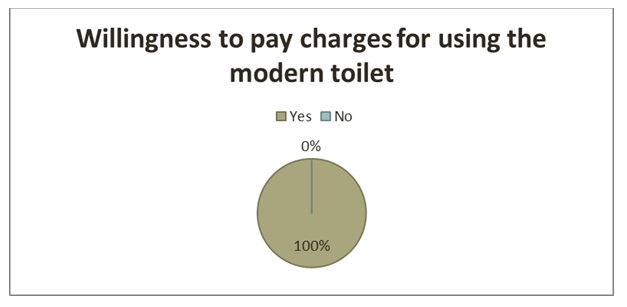 The third part of the question was asked that how much you are willing to pay for using the toilet at each time: the bellow chart shows that people want to pay Afs.5 for each time usage are 56%
The third part of the question was asked that how much you are willing to pay for using the toilet at each time: the bellow chart shows that people want to pay Afs.5 for each time usage are 56%
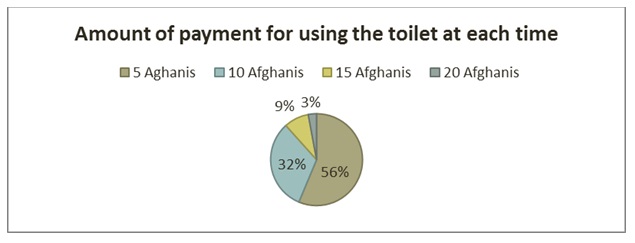 The fourth part of the question was asked if a modern toilet with flash and water is built then how frequently you will use it? The chart shows that 52% shows that when they are on travel will use the toilet and 34% people are welling to use more frequently
The fourth part of the question was asked if a modern toilet with flash and water is built then how frequently you will use it? The chart shows that 52% shows that when they are on travel will use the toilet and 34% people are welling to use more frequently
7. Summation of the findings:
For collecting this data, we have taken every 100 individuals views regarding the questions asked including women and men views in to two locations. From their ideas, suggestions, and recommendations, we have understood that the availability of women toilets is a vital need. Therefore, the availability of toilets in the major city like Kabul and high ways that travellers coming & going to Kabul is great need. It is important to make the people feel comfortable while planning to travel around Kabul and outside. Most importantly, the people those who are suffering from sickness, passengers, youngsters, and mothers who are having children, truly requires a proper type of toilet. Therefore, the availability of a better and modern type of toilet is necessary for every citizens of this country
Solutions: For solving social issues, everyone has to participate in the society. For providing better services to the people in the way to mosques, four doors of the Kabul city and high ways connecting Kabul to other provinces, grounds, and terminals, the access to better toilets are one of the most significant actions which should be taken by the authorities of the government.
Suggestions: After the collection of this Need Assessment and analyzing of it, those who are willing to help the people of Afghanistan in providing better toilets in the country mostly for women who are the very first victims living here.
The places for building the new toilets are suggested as followings:
- In all the doors of the Kabul city which are long, the women toilets should be built and the high ways connecting Kabul to other provinces.
- The toilets should be modern toilets along with having flush, water, and soap.
- In the grounds where the numbers of people are larger, the women toilets should be built.
- Toilets should be built in each 100 Km of the high ways for providing better services to the passengers.
- In every 150 Km there should be the availability of health centers for some unknown incidents in the future.
- People are welling to pay for utilizing the toilets and due to economic condition Afs. 5 are the most welling amount to be paid
- For security of the toilet male guards are necessary and for cleaning women and if they both are from the same family makes things to work out better
8. Glance of the Hygiene situations in Afghan society
- Neither the government nor the people are concerned about the subject of discipline and cleanliness. Through the help of discipline and cleanliness we can have healthy and enjoyable lives. But in our society, like the way that there is no single positive focus taken towards the development of the country, there are also no single consideration regarding the health and safety of the people.
- The responsible authorities like the ministry of health and the ministry of municipality have not taken any significant actions towards them. Most of the restaurants are not having waters, soaps and toilets for its customers.
- Transfers of the garbage are not in the proper way. This garbage is remaining in the roads, pedestrians, streets for more than a day and its smells are affecting every citizen.
8.Importance of cleanliness in Islam
- The Islam religion is one of the religions that focus more towards the discipline and cleanliness and obeying these aspects are the components of faith. The topic of cleanliness is not related to only one individual but it is involved with the whole people socially because human beings are socially connected to each other.
- Allah almighty also has focused more regarding the topic of cleanliness. As Allah almighty has mentioned that”ان الله یحب التوابین و بحب المطهرین”.
- Translation: Allah almighty likes cleanliness and forbidding”. Also prophet Muhammad (PBUH) has mentioned: الطهور شطرالایمان
- Translation: cleanliness is the component of belief.
- Prophet Abuhuraira has declared that Prophet Muhammad (PBUH) has said to his followers that: عن ابی هریره (رض) ان النبی (ص) قال: “اتقوا اللعانین” قالو: و ما اللعنان؟ قال: “الذی یتخلی فی طریق الناس، او ظلهم”.
- Translation: Prophet Abuhuraira has declared that Prophet Muhammad (PBUH) has said: avoid those who are cursed. Asked: who are the cursed people? Said: “those who are ruining other individual’s life”.
- Also in a hadith there is declared that prophet Muhammad (PBUH) has appreciated his followers towards cleanliness and discipline and said that those who obeys them they are having friendship with Allah almighty.
- ان الله طیب، یحب الطیب، نظیف، یحب النظافة، کریم، یحب الکرم، جواد، یحب الجود، فنظیفوا افنیتکم…
- (Termez, chapter first, page No. 154, hadith No. 2791)
- Translation: Allah almighty is clean, he likes cleanliness, he is clean, he is kind and he likes kindness, he is merciful and he likes mercy. Thus, make your intentions and purposes clean.
- In Islamic studies many ways have been declared for protecting the environment and individual’s rights. Hence, it is everyone’s responsibility to respect and obey them. Therefore, in every situation Islam values for two basic things, the health and safety.
9.The challenges
- Pollution is a dangerous: Talking about the pollution is one of the important topics. It is related to every one of us like when we are breathing daily in this dirty environment, it affects our minds badly. Naturally, every human being likes to be clean, disciplined, and beautiful. Thus, every individual works hard according to his/her ability to keep the environment safe and clean. But in social point of view, the governmental organizations have to try its level best in order to protect the environment from pollution.
- Currently, Kabul city is one of the dirtiest cities of the world and also one of the badly disciplined cities too. There is little number of services available for the people living here. For, example, the wastages are kept in the roads for many days and they are not taken somewhere far from the city. By the passing of time, the people have understood that despite receiving big amounts from the international countries still the government has not used them for protecting the environment. We have understood that despite passing thirteen years, we have not gained anything. As it’s said that “good wisdom exists in the sound body”. Therefore, a sound body requires a good health, which should be protected.
- Health threats: Focusing on cleanliness and discipline is the basic principles because it is related to our lives. Every particular individual wishes to have a good health. We can’t found anyone who wishes to suffer from bad health. One of the biggest reasons behind health threats is the unavailability of proper toilets in certain areas.
- Side effects: The unavailability of toilets in certain areas has resulted that the passengers eat or drink less than what they are supposed to use in order to feed their stomachs for the purpose of having a good health. These are the reasons that people living here are suffering from bad health. From the other side, the availability of place for sleeping near to the toilets also affects the health of an individual.
- Personal responsibility: Every individual living in the society is responsible for protecting his/her environment and every citizen if this country is supposed to look after his/her health, and environment because our body has the legal rights toward us to protect it from danger. As it is said in holly Quran: و لا تلقوا بایدیکم الی التهلکه
- Translation: don’t kill yourselves by the hand of yourselves.
- Social responsibility: As said earlier that every person is responsible for protecting his/her society. Thus, every individual has to obey the social rules, and norms. Therefore, the government has to take better decisions towards protecting the environment by providing proper toilets for the people living in Kabul. Proving proper toilets have many advantages. Firstly, it protects the environment. Secondly, it makes the people feel comfortable while living in Kabul.
- Governmental responsibility: Government is the responsible body for providing services to the citizens. Government has to provide the basic services for the people living in a country most especially in the capital. People should feel comfortable while traveling in a city.
- Civil responsibility: The civil is also responsible to work for cleanliness as well as a safe corner for women to access public toilet and security and safety by provision of job opportunity for women
Proposed NECDO Training and Monitoring Plan for My Afghan LibraryDecember 1, 2013 to November 30, 2014
|
Project # 5
My Afghan Library program Funded by the US Embassy in Kabul, Scholastic designed a program in January 2011 to promote literacy in early readers in Afghanistan with translated books and hands-on training in classrooms. After many successful years, the program recently concluded in January 2015. The launch of the program first involved translating 90 fiction and nonfiction titles to the Dari and Pashto languages for readers grades 1-3. These translated books were approved by the Afghan Ministry of Education for classroom use. To translate the titles, Scholastic worked with a Dari and Pashto speaking editor in New York, who also ended up visiting
Afghanistan for insight during the book selection process, Two different book sets were made available for classrooms: the first for larger, primary schools (100+ students) that contained five copies of each title (or, 450 total books), and a smaller set for rural, community schools containing 90 total books. The books arrived in Afghanistan in August 2012, and reached classrooms throughout
the country by September-November 2012. Besides distributing books in key languages, the My Afghan Library program also provided Scholastic-managed teacher training and a follow-up program for educators. The teacher
training was conducted by the Afghan NGO Noor Educational and Capacity Development Organization (NECDO), who also helped Scholastic design the curriculum.
Scholastic worked with two NGOs in Afghanistan to help manage the on-site portion of the program.
In its last quarter alone, the program concluded training and monitoring sessions in 10 provinces/districts across 34 schools. In the Ghazni district alone, program staff successfully concluded training with 30 teachers as well as the Directorate of Education staff. Teachers had nothing but positives to say about the impact of the program, with a number of them mentioning support from parents, notable
improvements from students, and successful integration of the lessons crafted for classrooms.
If you have any questions or would like to learn more about the My Afghan Library program,
| No | Location And No. of SetsReceived | Dates forTraining | Dates for Followup | |
| 1 | Laghman ( 15 Pashto Primary Plus 30 Dari Community ) | June 30-July 1, 2014 | May 12-14, 2014 | |
| 2 | Ningarhar ( 100 Pashto Primary and 101 Pashto community plus 110 Dari Primary Plus 11 Dari ) | August 11-12, 2014 | Mar. 25-27, 2014 | |
| 3 | Kunar ( 225 Pashto Primary and 175 Pashto community , 50 Dari Primary and 50 Dari community) | May 5-6, 2014Nov. 10-11, 2014 | September 1-3, 2014 | |
| 4 | Kandahar ( 100 Pashto primary and 100 Pashto community ) | Jan. 27-28, 2014 | Apr. 7-9, 2014Nov. 17-19, 2014 | |
| 5 | Helmand ( 150 Pashto Primary and 50 Pashto community ) | March 10-12, 2014 | June 16-18, 2014 | |
| 6 | Kundz (12 Pashto Primary Sets, 100 Dari Primary Sets) | March 31-Apr 1, 2014 | September 15-17, 2014 | |
| 7 | Baghlan ( 15 Pashto primary, 5 Community, 85 Dari Primary, 20 Community ) | July 14-16, 2014 | Sept. 22-24, 2013 | |
| 8 | Balkh ( 10 Pashto Primary, 90 Dari Primary ) | May 19-20, 2014 | Feb. 3-5, 2014 | |
| 9 | Herat ( 100 Pashto Primary and 25 Pashto community, 455 Dari Primary and 50 Dari community ) | Feb. 3-4, 2014August 4-5, 2014 | Jan. 1-2, 2014Sept 29-Oct 1, 2014 | |
| 10 | Kabul ( 10 Pashto Primary, 103 Dari Primary, 132 Dari Community ) | July 7-8, 2014 | Jan. 20-22, 2014Nov. 3-5, 2014 | |
| 11 | Wardak ( 280 Pashto Primary and 186 Dari Primary ) | Feb. 10-11, 2014August 25-26, 2014 | June 2-4, 2014October 20-22, 2014 | |
| 12 | Bamyan ( 75 Dari Primary, 25 Dari Community ) | April 14-15, 2014 | Feb 17-29, 2014 | |
| 13 | Panjshir ( 100 Dari Primary, 75 Dari community) | Feb. 24-25, 2014 | April 21-23, 2014 | |
| 14 | Badakhshan ( 50 Dari Class room Sets, 70 Community Sets) | Dec 2-3, 2013 | June 23-25, 2014 | |
| 15 | Ghazni ( 68 Pashto Primary, 45 Pashto community, 200 DariPrimary, 335 Dari community) | Dec. 23-24, 2013Oct 27-28, 2014 | Sept 8-10, 2014 | |
| 16 | Kapisa ( 62 Pashto Primary, 15 Pashto community, 133 Dari Primary, 25 Dari community) | June 9-11, 2014 | Jan. 6-7, 2014 | |
| 17 | Paktya ( 225 Pashto Primary, 100 Pashto community, 10 Dari Primary, 10 Dari community) | Dec. 16-17, 2013Oct 13-15, 2014 | March 3-5, 2014 | |
——————–
| Mohit-e-Salim Project“Enhancement for a Safe Educational Environment (free from Sexual Harassment) for All”2014 |
Project#: 6
Muhit e Salim Project: is a joint venture of women activists representing different national
NGOs, networks, and individual scholars, teachers, professors and parents and students that aims to work for “an educational environment free of sexual harassment” in Afghanistan. NECDO as women and local organization working for empowerment of women through multi dimensional and innovative projects faced a major challenge of Sexual Harassment on the way to carry out its work. In 2004 where we established Youth Committees in Ghazni Province to mobilize youths to play their role for decrease of sexual Harassment in schools and public spaces. Officially, the group (MSP) started its work under leadership of NECDO in 2007 with a research on the issue from one of the Kabul University. The core group of MSP is a dedicated activists who believe that Afghan society as an Islamic and democratic country, where work on prevention of sexual harassment from educational institutions especially higher education is our moral and social obligation
According to the research reports in 2007 & 2014 shows that Sexual Harassment is a major challenge for women empowerment and getting higher Education and become a professional leaders for future of Afghanistan, SH do exist on streets, in public transport, in the markets, in educational institutions and at workplaces, however we have decided to begin our efforts to curb sexual harassment first in the educational institutions. We believe that education is a path to development of Afghanistan and to produce Human Resource and ensure Gender Equality
Strategic Direction of Muhit e Salim Project 2015-2018:
The goals for the next 4 years working through MSP should achieve the following three main Goals:
Goal # 1: 1. Law on sexual harassment with legal status and implemented by all educational institutions of Afghanistan & work place Anti sexual harassment policies will be finalized For MOE, MoHE MOLSA, Ministry of Women Affairs, 3. 4. Establishment of complain committees in every educational institutions and establishment of Complain Center at least in 8 zone of Afghanistan
Goal # 2: Conducting a nation wide research on sexual harassment from higher educational institutions and work place, Writing articles and reports and other relevancies.
Goal # 3: 1.Conducting Awareness raising workshops on sexual harassment and protection of victims for female, male university students, government employee, civil society members, teachers, community influenecial members, Imams. 2. Capacity building of core group on Advocacy & networking. 3. Development of training martial, audio & video for workshops. 4. Media awareness raising program by local Radio & TVs.
Activities have been done so far:
- A research report from the Kabul University in 2007 conducted in which the main findings of the research report on sexual harassment in higher educational institutions are mentioned as two major findings
- All kinds of harassment do exist in educational institutions.
- Women safety and security is at risk inside and outside of educational institutions
- 10,000 Posters, pamphlets, was developed for more public awareness in Universities, public spaces
- Big posters for local bus transports with massages from Islamic perspective
- Development of training material in Dari & Pashto
- Audio and video and training manual was developed and around 1000 youths (700 female & 300 male) in Kabul were trained.
- Building Capacity of Core member on the issue for future advocacy
- Establishment of Youth Committees with Kabul Universities for provide awareness for other youths on the issue
- A code of Conducted as Ethical Policy for Educational institutions has developed
- Conducting awareness workshops for 1500 Ghazni, Badakhshan and Ningrhar youths and establishment of youth Committees
- Conducting Provincial Campaign against sexual harassment by football match in Ghazni province, Mosque campaign in Ghazni, Kabul, Ningrhar and Badakhshan provinces
- Conducting a comprehensive research report from 20 Universities in Kabul, Ningrhar, Harat and Mazar universities in 2014
- Establishment of four Working Committees:
- Media and awareness committee
- Advocacy and lobbying Committee
- Research and analysis committee
- Monitoring and evaluation committee
- A Strategic Plan for 2015-2018
summary:
Sexual Harassment is one of the major challenges that women in Afghanistan constantly face, which affects their progress in the society. According to this report “Muhit-e-Salim Research Report 2015”, one of the major challenges in the way of women empowerment and leadership in the tribal, male dominated and religious society. Family dignity is the top priority and women as representative of family’s dignity are the very first to be victimized. In order to keep family’s honor and dignity, women sacrifices their basic rights such as education, right of social mobility, and the right of employment. The issue of sexual harassment in higher educational institutions not only affects women as individual but it also the whole society. The need of the time is to scientifically find out the magnitude, dynamics, and the context of these social problems and weed them out. This struggle of cleaning our environment is the responsibility of both men and women at all levels. We need to return to our high standards of ethics and make the environment at home, in public, in educational institutions, and at workplace safer for all women and men.
The research report shows the following main points which need immediate attention:
- The research report is indicating that 99.9% of the respondents say that many kinds of Sexual harassment do exist within educational environment.
- There is a greater need for a proper and official complain mechanism that harasser can be careful of his/her attitude and also the victim can seek justice by legal mechanism.
- 87% of the respondents say that any women faced with continuous sexual harassment leave their higher education and accept forced marriages and domestic violence silently.
- The figures are very high and shocking compared to the research report in 2007, policy makers have to take this issue very seriously and any investment in education and empowerment without addressing the issue of sexual Harassment will go in vain.
- There is need of breaking the chains of silence and Public awareness and raising attention among the population are very important. The problem is increasing due to silence of the victims, policy makers and civil society.
The Research report is a situation analysis to see the magnitude, dynamics, and the context of Sexual Harassment found particularly in twenty higher educational institutions (government & private. The research study was designed and conducted during Oct – Nov 2014 addressing the concern about increased level of sexual harassment within educational environment, which has become a hug hurdle abstaining women from continuation of higher education. The main Goal & objectives were as follows:
Goal of the research Report: Understanding the forms of sexual harassment are prevalent in the educational institutions.
Objectives:
- To find out the frequency at which sexual harassment is committed in educational institutions.
- To recognize who the harassers are and the power dynamics associated with them.
- To gather information about the social, psychological and physical effects of sexual harassment.
The research report in hand is a qualitative and quantitative research as a base for advocacy issues as well as a comparative study of sexual harassment in educational environment since 2007. In this report we have targeted four major cities (Kabul, Balkh, Ningarhar & Herat), 20 Universities (private and government) and 1458 male & female. Initially NECDO key managers and survey officer developed a questionnaire, and after approval by the core group of MSP it was shared with surveyors. The questionnaire focusing on the three above mentioned objectives within 4 chapters, with total of 10 questions.
10 surveyors were appointed based on HR Policy of NECDO on transparent and fair selection process. Seven surveyors were from Kabul (5 female & 2 male), one Male from Balkh, and one female from Herat also a female from Ningarhar. The surveyors were given five full days of ToT, which were three days of theory and two days of practical. The field interviews started from 11th Oct to 11th Nov Prior to conducting field interviews, we got support letter from Ministry of Education, Ministry of Women Affairs. In total 1458 interviews were conducted. According to the Morgan theory basically, the data was cleaned up and a percentage of 5% was considered as error and finally the report was developed out of 1385 interview forms.
This research report has a comparative study between Research report in 2007 and the one in 2014 which show gravity of the situation. It also contains a number of real & true Case studies that give a better impression of the situation. The recommendations given are based on nine years of work experience by NECDO and member teams. 20% of the respondents said at least two times in a day they had the experience of harassment. The research report annex also contains a future plan for MSP by NECDO and members and strategy to address the issue from bottom to top and from top to bottom. The repeated acts of sexual harassment many times bring socially bad name to the victims who lose confidence and courage and let themselves be victimized. Fear of disgrace at the highest level of 64.8% and the lowest level of 7.3% were recorded in the victims . This fear of disgrace is the highest element of psychosocial illness.
NECDO cordially thanks Counter Part International/USAID and working Core Group (KANRAH members) to make this research report possible.
2.0 Muhit e Salim Project Background:
Muhit-e-Salim is a joint venture of women activists representing different national NGOs that aims to work for “an educational environment free of sexual harassment” in Afghanistan. The group is lead by a core team of dedicated activists who believe that Afghan society should and will take care of this problem. Though they acknowledge the problem at every level within homes, on streets, in public transport, in the markets, in educational institutions and at workplaces, however they have decided to begin their efforts to curb sexual harassment first in the educational institutions. They believe that education is a path to development of Afghanistan and they need to begin with removing the big hurdles that women face on this journey.
Through the leadership of NECDO, a group of women activists came together in 2007 to start working on a joint venture under title of “ Muhit-e-Salim Project” where posters, pamphlets, audio and video and training manual was developed and around 1000 youths (700 female & 300 male) in Kabul were trained. In order to find the gravity of the problem a research was conducted from 1150 individuals (800 female students, 200 male students, 150 professors and support workers). The main findings of the research report on sexual harassment in higher educational institutions are mentioned as under:
- All kinds of harassment do exist in educational institutions.
- Women safety and security is at risk inside and outside of educational institutions.
- The threats are not only from the class fellows, but also major threats from the teachers & professors.
- Street harassment is an act of violence and discrimination. In addition to making women feel endangered and vulnerable in public, harassment also discourages them from leaving their houses, and feeds the sadistic and discriminatory motivations of the assaulter by objectifying women, which leads to rape and sexual assault.
The group of Muhit-e-Salim was pressurized by concerned government departments, Kabul university Professors, and some of the civil society members who believed that silence is better than to address the problem. Since 2009 to 2014 NECDO with the help of a group of committed members continued the work with notion of “ Think Globally and Act locally” to address the issue. Therefore, awareness among youths within different Universities in Kabul, Ningarhar and Balkh was addressed by provision of series of workshop to mobilize youths. The workshops had the standard training manual including audio and video Materials. NECDO worked for establishment of youth Committees in Ghazni province and Kabul provinces which latter on got more structured by the name of “ Committee Inzbat and Insijam”[1] under university structure. We also paved the way for having a simple code of conduct by Kabul University through the pressure of youth committees. We also organized social campaigns for youth moral mobilization in Ghazni province and also convinced the NECDO’s Imams Network to condemn act of sexual harassment from Islamic perspective. The youth committees in Ghazni Province established a local Radio station, which on daily basis addresses the issue. The whole Ghazni city Friday Campaign through mosques was another successful movement of youth committees to address the issue of sexual harassment in public and schools. During 2014 the complains by youth committees in Kabul and Balkh convinced us to conduct another research report and address this issue with the new government and policy makers in order to have a systematic and legal complain mechanism within Government and Public Universities.
THE MAIN FINDINGS OF THE Research in 2014:
Women and girls are subduing their suffering from sexual harassment in educational environment to safeguard their family dignity and honor. The research report shows that the victims of sexual harassment suffer from different kinds of Psychosocial illnesses. Beside that they silently accept forced marriages and stop continuation of their higher education. Any investment in the field of higher education for women without advocacy or addressing the issue of sexual harassment, will not produce the desired results. One of the most significant and shocking fact is that 99.9% of the respondents said they had heard many cases of SH within their educational environment. 87.1% of the respondents mentioned that victims of SH stop continuation of higher education to save their family honor. The victims of SH suffer from the fear of disagreement up to 64.8%. The domestic violence is increased against the victims within families up to 56.2%. The percentage of victims who were compelled to enter into forced marriages in order to save their families honor was up to 47.6%. The increased limitation on mobility of the victims was up to 41.5%. The victims who lost their trust on surroundings, their percentage was up to 41.1%.
To the dismay, the above mentioned figures and percentages were taken out of the research report conducted from 20 Universities from Kabul, Herat, Ningrahar and Balkh from 1385 including students (female, male) teacher, administrative staff. The gravity of the problem was very deep which need very urgent and abrupt attention by policy makers, civil society activists and parents and students for having a safe educational environment for all especially for women.
Comparing the current report with the report of 2007 another type of Sexual harassment is highly indicated. The 25% of the total of respondents mentioned about kidnapping of the victims and raping them. This was the way to compel families to marry their daughters to the harasser, and such a harassment type was not indicated in 2007 research report. 50% of the women that were surveyed mentioned about another type of harassment that was being followed by a car or motorbike by the perpetuator.
In response to the question, if there was any reaction by victims towards the perpetuator, out of 1385 respondents, 66% said mostly victims and their families subdue their feelings and keep silence fearing consequences of disgrace within the society. 87.1% of the respondents mentioned that families compel their daughter to enter into forced marriages in order to escape from societal disgrace. The last destination for Afghan women is marriage, as women are not considered breadwinners of the families and they are depending on the male family members and this condition makes them vulnerable to compromise on their education and public participation. In response to the question that there was any complain mechanism system within your university to deal with such issues, 98% of the respondents had no idea if there was any such department or unit within Universities to deal with such issues. Only 2% of the respondents said there was complain to administrations of the Universities, but there was no follow up on the cases. When the same questions were asked from the teachers and administration of the universities 65% of the respondents said there was no need of such a department as no women would be ready to share the cases of disgrace in front of others. Usually, women were keeping silent in such circumstances. 35% were in favor of a special department with a specific policy to deal with the SH issues. In response to the question why there was no way to stop all this, 99% of the respondents said, corrupt educational system and involvement of lecturers and professors in the harassment were huge hurdles which did not allow them to get a solution. The third chapter of the questionnaire was about the psychosocial impact of the harassment on the victims, which had the following amazing figures that 64.1% of the victims got psychosocial illnesses without a proper treatment of resiliency. Around 32% of women victims lost a normal daily life.
2.1. Comparative Studies between 2007 & 2014 Research Report:
Women and girls are subduing their suffering from sexual harassment in educational environment to safeguard their families’ dignity and honor. The research data shows that the victims of sexual harassment suffering from different kinds of Psychosocial illnesses. Beside that they silently accept forced marriages or stop continuation of their higher education. Any investment in higher education for women without advocacy or addressing the issue of sexual harassment in the higher education will be not fruitful. One of the most significant and shocking fact was that 99.9% of the respondents said they had heard and witnessed many cases of SH within their educational environment. 87.1% of the respondents mentioned that victims of SH stop continuation of higher education to save their family honor. The percentage of victims of SH who suffer from the fear of disgrace was up to 64.8%. The percentage of victims suffering from increased level of domestic violence within the families was up to 56.2%. The 47.6% of the victims were compelled to enter into forced marriages in order to save their families honor. The increased limitation on mobility of the victims was up to 41.5%. 41.1% of the victims lost trust on the surroundings.
To dismay of the above mentioned figures and percentage out of the research report conducted from 20 Universities from Kabul, Herat, Ningrahar and Balkh from 1385 students (female, male) teachers, administrative staff. The gravity of the problem was very deep which needs urgent and prompt attention by policy makers, civil society activists and parents and students for having a safe educational environment for all especially for women.
Comparing the current report with the report of 2007 another type of Sexual Harassment is highly indicated. 25% of the total of respondents mentioned about kidnapping of the victims and raping them. This was the way to compel their families to marry their daughters to the harasser, and such a kind of phenomena was not indicated in 2007 research report. 50% of the women who were surveyed mentioned about another type of harassment that was being followed by a car or motorbike by the perpetuator. In response to the question if there was any reaction by victims towards the perpetuator?
Out of 1385 respondents, 66% said mostly victims and their families subdue their feelings and keep silence fearing consequences of disgrace within society. 87.1% of the respondents mentioned that families compel their daughter into forced marriages with the harasser in order to escape from societal disgrace. The last destination for Afghan women is marriage, as women are not considered breadwinners of the families and they are depending on the male family members and this condition makes them vulnerable to compromise their education and public participation. In response to the question that there was any complain mechanism system within your university to deal with such issues the 98% of the respondents had no idea if there was any such a department or unit within Universities to deal with such issues. Only 2% of the respondents said that a complaint was made to administration of the Universities, but no follow up was done on the cases. When the same question was asked from the teachers and administration of the universities 65% of the respondents said there was no need of such a department as no women will be ready to share the cases of disgrace in front of others. Usually, women were keeping silent in these circumstances. 35% were in favor of a special department with a specific policy to deal with the SH issues.
In response to the question why there was no way to stop all this, 99% of the respondents said, corrupt educational system and involvement of lecturers and professors in the harassment were huge hurdles which did not allow them to get a solution. The third chapter of the questionnaire was about the psychosocial impact of the harassment on the victims, which had the following amazing figures that 64.1% of the victims got psychosocial illnesses without a proper treatment of resiliency. Around 32% of women victims lost a normal daily life.
Historical background:
2.1. SEXUAL HARASSMENT IN EDUCATIONAL INSTITUTIONS
Education is both a cornerstone for building Afghan women human capital and a sine qua non for their equal enjoyment of rights and participation in national development. However, their access to a safer academic environment that can guarantee this is often infested with numerous constraints. Sexual harassment and violence in educational institutions is an abuse of power by teachers and lecturers and the corrupt education system. It has other severe consequences such as leading to girls and women dropping out of educational institutions, according to Transparency International’s Global Corruption Report, which was published in October 2013.
Sexual violence in education has been largely ignored by policy-makers, education leaders and law enforcement agencies around the world. It is likely to be greatest in countries with poorly resourced education systems, low levels of accountability and high levels of poverty and gender inequality. It is also high in regions experiencing conflict, with young people in refugee camps particularly vulnerable. We don’t have very many accurate data because this is a sensitive topic especially for the women and girls that have been harassed, and a culture of denial among many of those in positions of authority. There is also considerable under-reporting by students who fear victimization, including being failed in tests and exams, stigmatization or ridicule; or because they believe that no action will be taken against the perpetrator if they report the incidents.
Families have often restrained their daughters from going to schools and universities when they learnt that their daughters’ safety, dignity and integrity were in question at these institutions. This kind of family attitude has left less communication space for younger women to negotiate support from their families in dealing with the challenges they face in public. In public life women often deal with sexual harassment by suppressing her feelings and being silent about it. They also at times quit their jobs to escape the situation. There are hardly any professional ways to acknowledge or deal with this issue. Street mugging, touching and teasing of women, especially verbally, are generally exercised as right of men by birth. They use this attitude to suppress the women and keep their position of authority in the society. This leaves the women afraid, dependent, fatigued, uncomfortable, frustrated, hurt and sucks away her self-confidence throughout her life.
The magnitude of the issue has unfortunately been worsened in the years of war. Although harassment, especially sexual harassment, had never been clearly defined in the law before, the prevalence of impunity and absence of rule of law for years has made it to flourish more widely. Even larger universities in Kabul and other provinces have reputation of sexual harassment by the university professors[2] and teachers, in addition to harassment experienced by women from their fellow male students.
After the fall of Taliban, impressive progress has been made since 2001 with 6.2 million students enrolled in general education in 2008 in comparison with 2.3 million enrolled in 2002 much still needs to be done to increase the enrolment rate of female students. Of the 6.2 million children enrolled in general education, 36 percent were female. A major obstacle to the increased enrolment rate of girls, however, is the shortage of female teachers. In 2008, only 29 percent of all teachers were female. Similarly, the higher education system also faces disparities between male and female student enrolment rates. In 2009, for instance, 62,000 students were enrolled in higher education institutes in Afghanistan, 21 percent of which were women. While this percentage has risen considerably in comparison to the end of the Taliban period when no women were enrolled in higher educational institutes in Afghanistan, enrolment rates of male and female students are still far from equal. In technical and vocational education, only 16 percent of all students were female in 2008. The Ministry of Higher Education, however, aims to address this disparity by setting a goal of having at least 30 percent female students in higher education by the end of 2014. The report gave a succinct overview of the prevalence of GBV as well as recommendations that their purpose was to reduce its occurrence. Gender based violence, and in particular sexual violence, is a serious, life-threatening protection issue, primarily affecting women and children.
UNESCO guided by the three fundamental principles of Universality, Diversity and Dignity is working to promote gender equality in Afghanistan. In order to pave the way toward sustainable development, the broader goal of gender equality is a societal one in which education and all other social institutions, must contribute. In the framework of the ANDS, the NAPWA, the Constitutional guarantee to equality, the MDGs, the EFA goals as well as the CEDAW, UNESCO[3] is supporting the Government of Afghanistan to mainstream gender issues throughout educational planning and reform. The full and equal engagement of women in all aspects of society is crucial to ensuring the sustainable development of Afghanistan. The report, which the United Nations has circulated only among senior Afghan officials at the Interior Ministry, found that about 90 percent of the policewomen interviewed described sexual harassment and sexual violence as a serious problem, and that about 70 percent of the policewomen said that they had personally experienced sexual harassment or sexual violence themselves, according to people who saw the report or had it described to them
3.1 Other Studies on Sexual Harassment in Afghanistan:
Another Study of Three Universities in Afghanistan[4]” jointly undertaken by UNESCO and the UNDP in March 2010 in conjunction with the universities of Kabul, Herat and Balkh. It is timely affecting Afghan women today: their human capital development and their security which can ensure their living free from intimidation, fear, threats and violence in both the public and private spheres of life and pursue activities that will develop their capacity and help to lead a full and satisfying life.
The Afghan constitution, endorsement of international treaties such as CEDAW and lately the Afghanistan National Development Strategy (ANDS) has put the Afghan state under firm obligation towards fulfillment of its commitment for improving women public participation. The ANDS benchmark requires 30% increase in public position in all level for women which perquisites development of new opportunities, and enabling environment where women can pursue their education and build their careers on equal bases as that of men and even further steps as [5]affirmative action policy of the government.
3.2. Afghanistan Laws on Sexual Harassment:
Afghan civil law has not been updated or modified since the socialist period of the 1970s. As in many Muslim countries, Afghan civil law co-exists with Islamic Sharia law, as well as tribal and customary law, which are often used to resolve many conflicts in Afghan society. Understanding the proper balance between these varied bodies of law is highly complex.
Chapter two of the Constitution seeks to implement the Preamble’s declaration into practice. Article 22 holds that “the citizens of Afghanistan, man and woman, have equal rights and duties before the law.” Article 43 guarantees education to all Afghans and Article 44 imposes a positive duty on the government to “devise and implement effective programs to create and foster balanced education for women.” Article 54 recognizes the family as the “fundamental pillar of the society” and requires the government to adopt “necessary measures to attain the physical and spiritual health of the family, especially of the child and mother, upbringing of children, as well as the elimination of related traditions contrary to the principles of the sacred religion of Islam.”
To ensure that the rights provisions of the Constitution are properly implemented, Article 58 requires the state to establish and maintain the Afghanistan Independent Human Rights Commission (AIHRC), which is to preside over claims of human rights abuses and refer cases to the legal authorities, as it deems appropriate
The AIHRC[6] was created pursuant to the Bonn Agreement of December 5th 2001, and it currently operates outside the formal governmental structure. The AIHRC clearly states that one of its primary goals is “to promote, ensure women’s rights and monitoring the situation of Women in Afghanistan and also make efforts to eliminate/reduce the discriminatory attitudes towards women in Afghan society.” The Commission aims to promote women’s rights through advocacy, training and education, and investigation of rights violations.
The penal Code, which is a mixture of socialist jurisprudence and ancient Islamic practice, did not contain any explicit prohibitions against rape, sexual harassment, or any other crimes against women until the enactment of the Elimination of Violence Against Women (EVAW) law in August 2009. The purpose of EVAW is to end “customs, traditions and practices that cause violence against women contrary to the religion of Islam”. It strengthens many areas of women’s rights and for the first time, various forms of violence against women are criminalized, including rape. However, there remain challenges to its incorporation and many perpetrators continue to go unpunished.
Afghanistan’s recent history, continued state of political unrest, and relative isolation from central authority make it difficult to determine how, or if, codified laws are implemented in practice. There is still not a clear defined law article in Afghan Civil Code to define harassment or clarify punishment for perpetuators. However the post conflict situation in Afghanistan opens space for law reforms, which also comes as one of priority of National[7] Development Strategy (ANDS).
3.3.AFGHANISTAN’S CURRENT LEGAL POLICY FRAMEWORK:
Sexual harassment is a major problem in Afghanistan and a major obstacle on the way of women getting higher education, where women and girls have had to struggle to regain their rights after being completely shut out of education and employment during Taliban rule until their ouster in 2001. There has been significant progress in improving girls’ access to education and integrating women into the Afghan parliament and civil service but unchecked sexual harassment has been a significant obstacle to women’s employment and participation in public life. Sexual harassment within the workplace, including in government, is an especially serious problem, Human Rights Watch said. Government institutions have made almost no effort to prohibit harassment and assist victims. Only one government agency, the Independent Directorate of Local Governance, has developed anything resembling an anti-sexual harassment policy. The directorate’s “anti-harassment policy guideline” cites a commitment in the government’s 2007-2017 National Action Plan for the Women of Afghanistan to adopt and implement “a policy against sexual harassment” as the basis for the guideline.
This sets out a detailed description of harassment and measures a victim can take, including anonymously seeking the assistance of a Conflict Resolution Committee. Although, the Afghan Constitution in it’s preamble stresses on human rights and personal dignity of citizen (women and men), equality and For creation of a civil society free of oppression, atrocity, discrimination, and violence, based on rule of law, social justice, protection of human rights, and dignity, and ensuring fundamental rights and freedoms of the people, (constitution, 2004)
The efforts by women’s rights activists and parliamentarians to ensure the 2009 EAW law – signed as a decree by president Hamed Karzai but not yet ratified by parliament – is passed were thwarted by conservatives objecting that it was “un-Islamic”. Criticism of the law was so strong that, on 18 May 2013, the speaker stopped the parliamentary debate after 15 minutes and sent the law back to the joint commission of parliament, which prepares draft laws for further scrutiny. While the law can still be implemented, because the president has signed it, it must be passed by parliament to give it legitimacy. The EVAW Law is a step forward for addressing the issue of sexual harassment in the article 30th of the law it is clearly mentioned that under the title of Harassment/ persecution (If a person harasses/persecutes a woman, considering the circumstances he/she shall be sentenced to short term imprisonment of not less than 3 months. 2. If the crime mentioned in paragraph 1 of this Article has been committed by using authority and position, the offender considering the circumstances shall be sentenced to short term imprisonment of not less than 6 months)
According to the Human Rights Watch (New York) – Afghanistan’s new government should take urgent steps to combat sexual harassment of women in education, employment, and public life. There are no laws in Afghanistan that specifically prohibit sexual harassment or protect victims. Government institutions lack effective policies to prevent and punish sexual harassment, Human Rights Watch said. On October 5, 2014, President Ashraf Ghani described levels of sexual harassment in schools as “shocking.” He ordered the Ministry of Education to report every incident of sexual harassment in schools to enable action against harassers, and directed relevant ministries to develop a plan to counter sexual harassment in educational institutions.
The Afghan government should promptly enact a law against sexual harassment and ensure that every government institution develops and implements an anti-sexual harassment policy.” This is the responsibility of Afghan government to support this joint venture of civil society to fight against sexual harassment to pave the way for women leadership and empowerment. We since 2007 face many challenges and obstacle for the MSP due to corrupt educational system and men domination as well as systematic corruption in judiciary system of Afghanistan. Thus, so far the civil society could not work as active as it should, for law reforms and taking support of stakeholders.
METHODOLOGY
5.1. Details of Methods:
Desk Research: NEDCO conducted desk research of the laws, regulations, provisions and the pre- established reports on sexual harassment, including the methods by which they are nominated or selected. Research reports, academic journals, newspapers, and other relevant sources were consulted. A special emphasis was placed on reports related to Ministry of higher education code of conduct, the united nation sexual harassment report, ministry of women affairs and AIHRC reports. The goal was to identify opinions and concerns that have been silenced. In fact, through the literature review, NECDO research report undertook a mapping of the contributions that women have been able to make to such negotiations and the conditions under which this have occurred. Contributions will be observed through voting records, public statements, and the prevalence of gender sensitive discussions and policies.
Development of Research Framework: NECDO developed the research framework including analytical framework of analysis to lay down the theoretical foundation for the organization of findings, development of questionnaire to conduct qualitative research for the sexual harassment in higher educational institutions.
Consultations with Partners: The sampling methodology was established to ensure that research results are representative of the views of the target groups. Partners were consulted, including KNAHR, SAF, AEWC, AWPEI and (donor), and government officials for feedback.
Training for surveyors and researchers: After the approval of questionnaire of FGD and In-depth interviews had been finalized, NECDO conducted training on research methodologies for the researchers and surveyors. The goal was to ensure that the two organizations capture similar information and that all findings are relevant, congruent, and representative of the views of the population.
In-depth Interviews and Focus Groups: After the research questions and training were finalized, NECDO deployed their team of researchers to conduct five in-depth interviews and three women in the targeted universities in each province
Follow up in-depth interviews and Focus Groups: It is important to mention that given the relevance of Kabul in regards to laying down the foundations for policy amendments. The research team interviewed female and male members of parliament, local CSO and university heads or lecturers who are supportive of elimination of sexual harassment against women’s issues.
Data Analysis: Upon the conclusion of the qualitative research, NECDO processed and analyzed the data in which 5% of the data were separated and out of 1458 interviews we could extract solid information from 1385 forms. Findings was triangulated, used both primary and secondary sources – desk research – to ensure that they reflect the barriers that prevent women from becoming actively involved in the higher education and empowerment process.
Report Writing: After the data had been processed in a general database, a final research report was developed. The barriers that prevented women from becoming actively involved were discussed.
5.3. Sample or Target Population:
Initially, educational administration and government agencies were interviewed to gain insight into current and possible policies regarding sexual harassment, the reporting mechanisms and the accountability procedures. After an overall understanding within the educational institution’s context, 20 higher educational institutions were selected to get a close up on the dynamics. A survey tool was developed in the form of a questionnaire for quantitative data gathering and a question guide was developed for qualitative information gathering through case studies. Acknowledging the silence that envelops the issue of sexual harassment and the stigma it has within the social context, the questionnaire started with observed sexual harassment in the universities. This made the respondents more comfortable to answer the second part, which focused on their own experience of sexual harassment. In this way the sensitivity of the issue was kept in mind and more accurate data was collected.
[1] Committees for discipline and regulation within University environment
[2] A video report of sexual increase by a university professor from Balkh university has been shown in Tolo TV, as eye opening of heinous act pursued at university level (Tolo TV is one of the widely viewed private television channel, 2007)
[3] http://en.unesco.org/countries/afghanistan
[4] http://www.af.undp.org/
[5] Article Forty-Four Ch. 2, Art. 23, Constitution (2004
[6] http://www.aihrc.org.af/media/files/VAW_Final%20Draft-20.12.pdf
[7] Five year macro economic plan of Afghanistan for increase of growth and poverty reduction, same as PRSP else where
Experienced researchers from the Core Group members monitored the student interviewers. After their first ten interviews they were debriefed to clear up problems faced or clarify use of the survey and surveying techniques. Researchers continued to be present at the research site to follow up with the student interviewers and clarify any questions until all questionnaires were submitted. The total interviewees from administration were 21% and the rest 79% were students
6.0. KEY FINDINGS:
6.1 Definition of sexual Harassment: Sexual Harassment is a form of gender based violence most commonly defined as “any unwelcome behavior, comment or action of a sexual nature that interferes with a person’s, comfort, performance or creates an intimidating, hostile, or offensive environment”[1]. It includes a range of behavior, leering, touching, colored, jokes to sexual assault. At times it is the peers whom with such behavior think they are having fun but create an intimidating environment for women to be outside in the public or in an educational institution. This can be one of the most crucial factors why women are not comfortable coming out of homes, go to public institutions by themselves, get education or take up a job. Many times, a person in authority may also demand sexual favors in order for the victim to keep or obtain certain benefits, or make personal decisions about the recipient based on whether the sexual demands have been met.
[1] As defined by the Equal Employment Opportunity Commission (EEOC) in 1980,
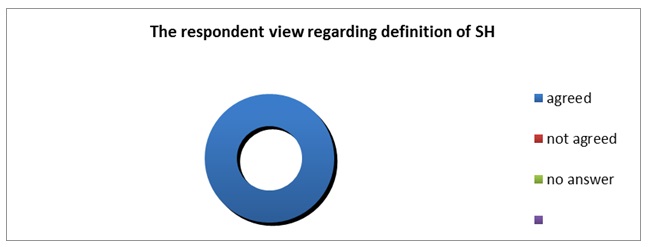 6.1.1. Experience of Sexual Harassment existence: In response to the question whether they have heard about any issue of sexual harassment incidents in your university or if they have encountered any problem?” All the response mentioned that they had heard many cases of sexual harassment 99% of the interviewees said they had many stories of harassment, which was shocking. In comparison with the research report of 2007, we had 34% interviewees responding positively, which shows the gravity of the problem.
6.1.1. Experience of Sexual Harassment existence: In response to the question whether they have heard about any issue of sexual harassment incidents in your university or if they have encountered any problem?” All the response mentioned that they had heard many cases of sexual harassment 99% of the interviewees said they had many stories of harassment, which was shocking. In comparison with the research report of 2007, we had 34% interviewees responding positively, which shows the gravity of the problem.
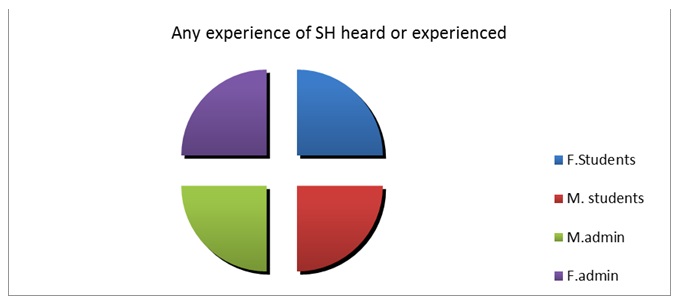 6.1.2. Identity of the Haressor and the identity of the victims: In response to who were the harassers and who were the victim, out of 1385 respondents it seems that almost 99% the interviewee’s said “men” were the perpetuators and 99% women were the victims. Only 1% females were harassers and 1% of males were the victims.
6.1.2. Identity of the Haressor and the identity of the victims: In response to who were the harassers and who were the victim, out of 1385 respondents it seems that almost 99% the interviewee’s said “men” were the perpetuators and 99% women were the victims. Only 1% females were harassers and 1% of males were the victims.
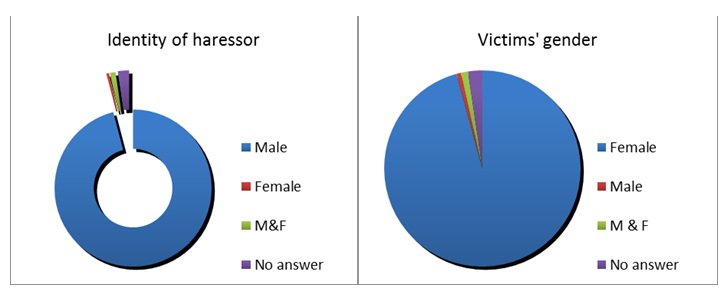 6.1.3. Kinds of Sexual Harassment (physical attack and physical touch): In response to physical attack, out of 1385, 21.7% said they had experienced of physical attack. The physical touch response was up to 43.4% which was very high as compared to the 2007 research report according to which this parcentage was only 29%.
6.1.3. Kinds of Sexual Harassment (physical attack and physical touch): In response to physical attack, out of 1385, 21.7% said they had experienced of physical attack. The physical touch response was up to 43.4% which was very high as compared to the 2007 research report according to which this parcentage was only 29%.
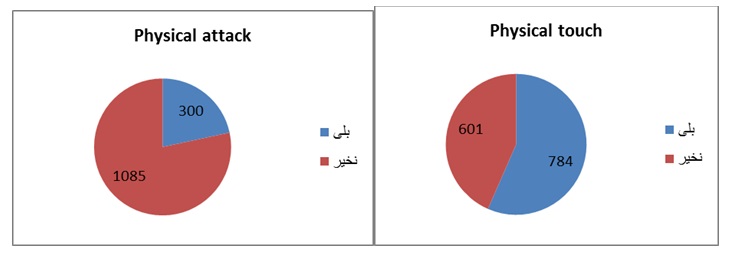 6.1.4. Sexual gesture & sexy Pictures: In response to sexual gestures, 51.1% respondents said yes, they had experience sexual gestures in the university environment. 20.4% out of the total respondents, said yes to the question and it means this is also a common way of harrassment within the University environment.
6.1.4. Sexual gesture & sexy Pictures: In response to sexual gestures, 51.1% respondents said yes, they had experience sexual gestures in the university environment. 20.4% out of the total respondents, said yes to the question and it means this is also a common way of harrassment within the University environment. 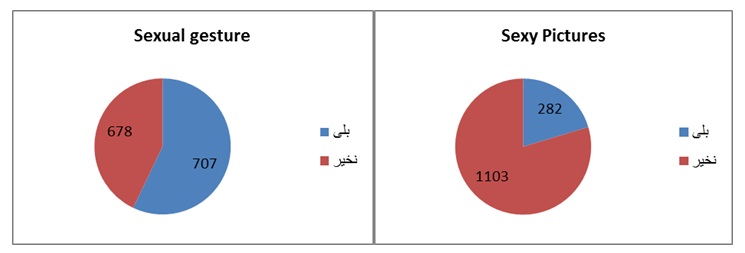 6.1.5. Sexy joks and written massages on walls: In response to the sexy joks which is another common practice out of the total, 33.2% respondants said yes it was a common practice. The writing on wall was a common practice according to 30.6 % of respondents.The practice of writing on the wall was also common in 2007 research report.
6.1.5. Sexy joks and written massages on walls: In response to the sexy joks which is another common practice out of the total, 33.2% respondants said yes it was a common practice. The writing on wall was a common practice according to 30.6 % of respondents.The practice of writing on the wall was also common in 2007 research report.
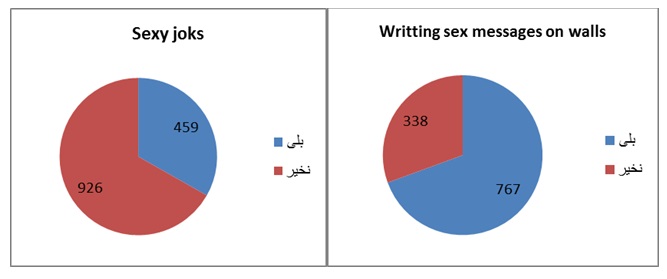 6.1.6. Staring at body parts and sexy songs: Out of total respondents, when asked about being stired by males within the university environment,68.3% said yes which was shocking and 53% said they had experience of sexy songs within the univesity environment. In the report of 2007 the parcentage was up to 49%.
6.1.6. Staring at body parts and sexy songs: Out of total respondents, when asked about being stired by males within the university environment,68.3% said yes which was shocking and 53% said they had experience of sexy songs within the univesity environment. In the report of 2007 the parcentage was up to 49%.
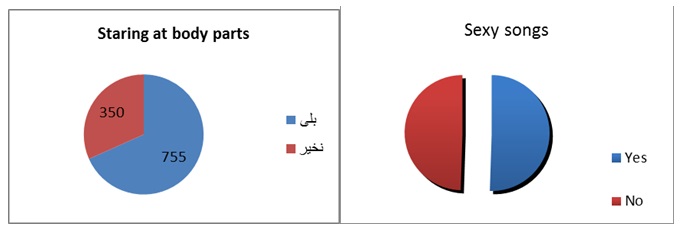 6.1.7. Invitation to sex, promising promotion or threats of punishment if favors not given: Referring to point above, demanding sexual favors. 23.3% women said that sexual favors were demanded with threats of punishment. 65% out of these said it was not just a one-time occurrence but also a frequent happening. 68% of those who confirmed this form of harassment said that students did it, while 23% said teachers did it. The threat for disgrace forced 35.5% of females respondents, which was shocking. In the report of 2007 the parcentage was only 15%.
6.1.7. Invitation to sex, promising promotion or threats of punishment if favors not given: Referring to point above, demanding sexual favors. 23.3% women said that sexual favors were demanded with threats of punishment. 65% out of these said it was not just a one-time occurrence but also a frequent happening. 68% of those who confirmed this form of harassment said that students did it, while 23% said teachers did it. The threat for disgrace forced 35.5% of females respondents, which was shocking. In the report of 2007 the parcentage was only 15%.
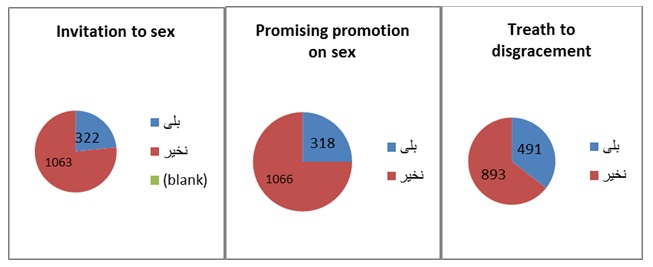 6.1.7. Tools of sexual harassment: Haressment through letter was experienced by 76%, through social media 38.4% and through mobile by 24% of the respondents.
6.1.7. Tools of sexual harassment: Haressment through letter was experienced by 76%, through social media 38.4% and through mobile by 24% of the respondents.
 6.1.8. Following the victims by the haressor: In response to halting the way of a female student going to University, 56.5% of respondents said yes to it. On the question of a female student being followed by a male student, 55.7% out of total respondents accepted that these were very common.
6.1.8. Following the victims by the haressor: In response to halting the way of a female student going to University, 56.5% of respondents said yes to it. On the question of a female student being followed by a male student, 55.7% out of total respondents accepted that these were very common.
6.2.0. Psycho Social impacts on the victims of Sexual Harassment:
6.2.1. Depression and fear:
According to the questions format, it shows that depression was the highest level of psychological illness prevalent among victims of Sexual Harassment. 51.4% was the highest and 7.1% was the lowest percentage recorded among the victims. The levels of Fear among them was recorded as 48.1%as the highest and 7.2% as the lowest level.
6.2.2. Feeling guilty & feeling irresponsibility by the victims:
Out of total of the respondents who mentioned about feeling of guilt by the victims of sexual harassment, 18% was lowest and 32.8 %as the highest level observed. Figures show that the victims exhibit irresponsible behavior. Their levels were recorded as such: lowest 22.9% and the highest is 26.4%.
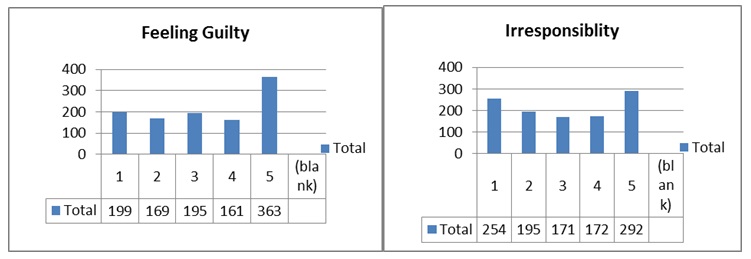 6.2.3 Obsessive and psychosocial illness of the victims: The range of loneliness among the victims was observed as 11.1% as the lowest, and 43.6% as the highest. The psychosocial illness’s lowest percentage was 8.4% and highest one was 45% among the victims of the sexual harassment. The figures were shocking and it showed that every woman facing SH, remained a patient of psychosocial illness.
6.2.3 Obsessive and psychosocial illness of the victims: The range of loneliness among the victims was observed as 11.1% as the lowest, and 43.6% as the highest. The psychosocial illness’s lowest percentage was 8.4% and highest one was 45% among the victims of the sexual harassment. The figures were shocking and it showed that every woman facing SH, remained a patient of psychosocial illness.
6.2.4. Fear of disgrace:
Fear of disgrace had the highest level of 64.8% and the lowest was 7.3% among those taking part in the survey. This fear of disgrace was the highest element of psychosocial illness.
6.3.0 Physical impacts:
6.3.1. Face color and increased palpitation in victims:
Change in face color,
38.2% highest, lowest 10.3%.
And increase in heart palpitation
Highest level 41.1% and the lowest level 6.1%.
The figures show that the Sexual Harassment had very quick effect on body and mind.
6.3. 2. Headache and shivering of body and tongue in victims:
The elements such as headache were observed in the range of 26.7% as the highest, and 6.9% as the lowest level, stammering was found in 31.8% as the highest and 12.5% as the lowest level in the total number of people who responded to the survey.
6.3.3. Physical wound and Nausea:
Total respondents had expressed that 28.7 % is the highest level of physical wounds whereas 22.2% was the lowest level recorded. The percentage of nausea and vomiting having highest level of 16.9% was observed in the victims. This shows a significant impacts of repeated sexual harassment.
6.3.4. less appetite and less sleep:
The victims of Sexual Harassment with repeated sexual harassment got very less appetite the percentage showed that lowest level was 19.2 %. The highest level of less sleep among victims was 22.8% while the lowest level stood at 11.2%
6.4.0. Social bad Impacts on the victims:
6.4.1.Disgrace among people & lack of interest:
According to the total number of the respondents, the fear of disgrace was having the highest level of 64.1% and the lowest level observed was 7%. The lack of interest, maintained a highest degree of 47.3% and the lowest one was around 6.3%. The indicated figures show gravity of the impact of psychosocial illnesses on the victims of SH.
6.4.2. Sexual transmitted diseases and limitation in movement:
The highest number of respondents agreeing to Sexually transmitted diseases stood at 36.1% while lowest percentage was 15.2%. Limitation to movement of the victims by family had a highest level at 41.5%, and lowest one at 8.3%.
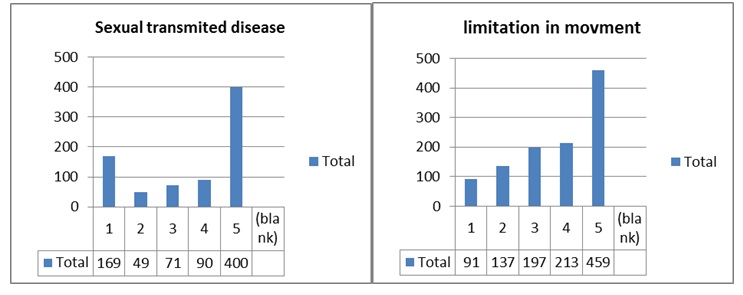 6.4.4. Bad temper and lack of trust by victims: Highest ratio of bad temper observed in the victims was 39.5% as against the lowest level of 9.4%. Lack of trust, the highest percentage observed was 41.1% and the lowest one was 10.9%.
6.4.4. Bad temper and lack of trust by victims: Highest ratio of bad temper observed in the victims was 39.5% as against the lowest level of 9.4%. Lack of trust, the highest percentage observed was 41.1% and the lowest one was 10.9%.
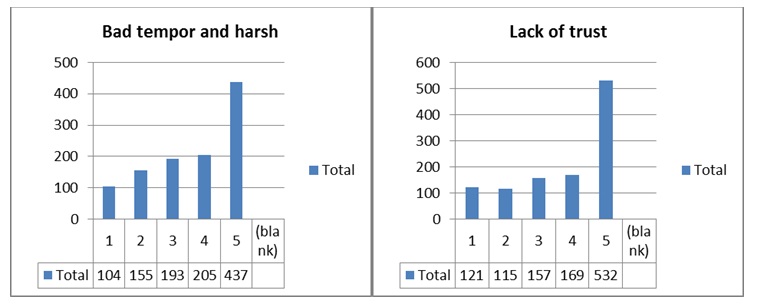 6.4.5. Forced marriages & not continue the higher education: the victims were pressurized to enter forced marriages and the respondent’s showed that as much as 47.6% women were forced to marry by the family to avoid public disgrace which is the highest level and the lowest percentage recorded was 6.1%. To stop higher education of the victims of SH, the highest percentage was 87.1% and lowest was 6.1%.
6.4.5. Forced marriages & not continue the higher education: the victims were pressurized to enter forced marriages and the respondent’s showed that as much as 47.6% women were forced to marry by the family to avoid public disgrace which is the highest level and the lowest percentage recorded was 6.1%. To stop higher education of the victims of SH, the highest percentage was 87.1% and lowest was 6.1%.
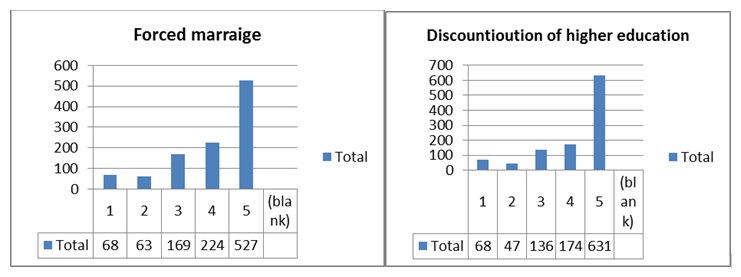 6.4.6. Bad impact on daily work and increase in family violence: Highest of impact on daily work of victims was 32% and lowest was 12.4%. The increase in violence within families had a highest level of 56.2% and the lowest level as 6.1%, which means that one of the major cause of increase in domestic violence is harassment.
6.4.6. Bad impact on daily work and increase in family violence: Highest of impact on daily work of victims was 32% and lowest was 12.4%. The increase in violence within families had a highest level of 56.2% and the lowest level as 6.1%, which means that one of the major cause of increase in domestic violence is harassment.
6.4.7. Kidnapping & Rape
Though rape is one of the most violent forms of sexual harassment, the study found out that 19% of the women had heard of rape being committed on campus. 51% out of them said it was a one-time occurrence while 27% said that the victim experienced it over and over.
 6.4.8. Repetition of the harassment during a day within University Environment:
6.4.8. Repetition of the harassment during a day within University Environment:
The below chart shows that most of the respondents 20% hadd mentioned at least 2 times in a day they experience harassment and 18% said that they faced the phenomena one time on daily basis within University Environment.
7.0 WOMEN’S OWN EXPERIENCE OF SEXUAL HARASSMENT
Women were first asked to state behaviors of sexual harassment that they had seen or heard about. Later they were asked to mention incidents that they had experienced themselves. There obviously was a slight difference in the two sets of data. We assume that because of the sensitivity of the topic, the stigma attached socially to the victim and the issue of honor and reputation that make it all more complex were factors that caused lower rating in this set of data.
This information might not reflect the actual numbers, which from our in-depth interviews seem to be much higher. However these figures become an indicator of the fact that sexual harassment does occur. It also gives us an insight into the various forms of sexual harassment they experience, including the lighter versions and the more violent forms.
8.0 CASE STUDIES:
8.1 Case study of Mariam: The very new and current which is on the desk of MoHE at the moment it’s the case of Mariam. She is an intelligent and she had done very good paper but when she was failed, she was shocked and she asked her teacher to review her paper. The teacher says that I can do this only when you come to my room all alone. She knew from the past experiences of other girls and she says that she cannot come alone but with a group of other girls. The teacher does not except and Maryam is telling her teacher that she will commit suicide in order to save her family honor and her honor in the eyes of her family and get rid of the teacher. The teacher does not pay attention to her request and she commits suicide but thank God she is alive but the case is going on …..
8.2. Case Study Suray’s : Suraya was in second year of her collage and she was one of the brilliant students. She was followed by a male class fellow and she tried to ignore him but the boy was getting extreme even he was reaching near her home’s door. When she saw that the boy was not listening she complained to her mother and another day her mother brought a bottle of oil and put fire on the face of the boy and there was a big clash between two families. The Suray’s family decided to marry her with an old man from their village and she had to stop her education and went to live with her husband in Badakhshan. Almost two years have passed but still, her family is upset with her for putting family honor at to risk.
8.3. Case study of Nasima: Was an intelligent student of law, she was beautiful as well; a gang of 5 boys were harassing her again and again. She did not mention any thing to the family, as she knew the family would have only one solution to stop her higher education. She continued to suffer with silence and it affected her daily routine and her number went down. The depression on her was increasing day by day and her dream to become an advocate and fight for women’s right was becoming a dream day by day. She started to give the Gang 5 harsh words and insult them in front of other class fellows. The Gang 5 kidnapped her and raped her and than dropped her on the corner of street. Her family begged the gang 5 to marry her but they ignore and Nasima remained without any support with a bad psychosocial problem.
8.4. Case study of Gul Rukh: Gul Rukh was very intelligent and a treat for male class fellows. A gang of 3 boys kidnaped her and raped her to punish her for being more intelligent than them in the University.
8.5. Case Study Zarmina punished for a crime she did not commit
Zarmina was a student in one of the universities in Afghanistan. She was very enthusiastic about her studies. She experienced a very uncomfortable and scary incident. A young man who was also a student but was from a different town started following her when she finished her classes and came back home. This incident turned into a routine where this man would follow her from home to her university and back. She was very afraid of this intimidation.
Zarmina wanted to share the issue with her mother but could not find the courage. She was too afraid of her father and could not even imagine telling him. She was sure that he would get very angry and would stop her from going to the university. She somehow wanted to handle the issue to make sure that she could continue her higher education. She thought she needed to be brave and stop this intimidation her self. She repeatedly told the boy to stop following her because this could damage her reputation. With all her efforts she could not shake the man off.
Her fears came true! The neighbors started gossiping about the situation and soon her character was being questioned. Her brother came to know about this talk and became furious. One day her brother followed her from the university to verify what he had heard. He saw this young man following her. He also saw his sister turning around and saying something to him a few times. She as usual was trying to convince the man to stop doing it. When she reached home her brother beat her up badly. He blamed her for bringing such shame to their family. He also told his family that the tales of her bad characters were all over the neighborhood. Her father immediately declared that her studies should be stopped and she should be married right away. They forced her to marry an old man, who had quickly offered to help out despite her shady reputation. He was rich but not educated. Zarmina tried to protest but found herself helpless. Her family totally blamed her for attracting the man and ruining the family reputation. She was punished for a crime, which was not hers.
Aziz was a student of University was searching for one of the professor for getting some advise on the assignment which was handed over to her. By entering the professor’s room he saw that Ruqia was in the arms of the professor They both were shocked and Aziz too. The professor with anger said, “what was the matter?” with harsh sound Aziz replied with anger “I don’t know? But what was the matter with you both???” Ruqia was crying rushed towards Aziz and said (protect me) and she was shivering badly. She started begging that he should not share this with anyone and she said the professor compelled her for doing so as he would not allow her passing marks and her family was also pressurizing her on getting high scores. When the professor heard this he came near Aziz with a meaningful smiling face said, “Dear Aziz if you keep the secret you will be one of the top students in my class. Ruqia was from a poor family and her mother wanted her to complete her education so she could be the breadwinner of her family and therefore the professor was taking advantage of her weakness in life.
Hassina was beautiful and a charming student of University. A boy loved her and wanted to harass her, she never liked him and she was treating him badly. When Zubair was disappointed with her negligence he decided to take revenge from her. Zubair through some of his bad friends kidnapped Hassina and passed rumors about her affairs with him and that she had escaped with him by her own will. When the boy forcefully sexually abused her and after that he let her free to go back, she had no choice but marring him because such girls would never be accepted in the society. In order to save her honor and her family’s honor, she unwillingly accepted that marriage proposal. Though, Hassina had told her family several times, she didn’t like him and it happened forcefully, but her family never believed her. Besides, she could not complete her education, by such a violation of Zubair she lost her family and beside that she had no respect in Dubai family as they thought she had escaped with their son. She had a miserable life and many times she tried to commit suicide but she was worried about her young daughter.
Somaya, an orphan belonging to a poor family wanted to get admission in Kabul University and she dreamt of becoming a doctor as her father wished her to be one. She had dedicated her time only to education she was one of the high scorers during conquers exams. When she applied in the department of higher education for getting her graduation records one of the employees found that not only Somaya was beautiful but also she had no male member in her family to support her as her father was killed during the civil war. The employee always postponed her work for the other day and finally one day he found the chance to tell her that he loved her and wanted to date her. She could not accept his will. After many struggles when he was sure that Somaya would not fulfill his wish, then he destroyed all her documents and now she is sitting home and cannot go to fulfill her dream to be a doctor.
9.0 Complexities in devising a Proper Mechanism for SH
In order to understand policies, reporting mechanisms and accountability procedures interviews were conducted with policy makers, administrators and activists. Information was gathered from deputies of relevant ministries including MOE, MOHE, and MOWA. Chancellors and administrators of universities and schools were also approached and interviewed. Interviews also included parliamentarians, religious leaders, judges, and women’s activists to understand the challenges surrounding anti-sexual harassment policies.
The Afghan constitution and overall polices of institutions do have potential mechanisms for dealing with sexual harassment however none of these have been explicitly developed. Furthermore, there is a lack of knowledge about these potentials resulting in a lack of accessibility and awareness needed to develop such mechanisms by cases and precedence. As mentioned previously in this document, Article 3, 22, 29 and 44 of the constitution establish the foundations for under which a sexual harassment policy can be developed.
There is no direct policy dealing specifically with sexual harassment in government employment policies, education institution policies, and health policies. Various words dealing with appropriate conduct in Afghan law are not clearly defined in relation to sexual harassment. The challenge arises due to the lack of definition of sexual harassment as a crime, which in turn means it cannot have punishment or accountability procedures as Article 27, c of the constitution states:
“No person can be punished but in accordance with the decision of an authorized court and in conformity with the law adopted before the date of offense.”
In Afghan society, security is linked to honor and sexual harassment is a direct assault on honor. Sexual Harassment establishes spaces where women and men are dishonored and can result in shame, guilt and restriction of mobility. For this reason women and especially men are hesitant to express sexual harassment they have seen or experienced. Sexual harassment goes against Islamic code of conduct in Sharia and the Afghan customary code of conduct. However the effect of shame on the victim and their own and family’s honor causes their experiences to be suppressed and offenders to get away with their sexual harassment actions. This is compounded by the lack of social mechanisms to hold the harassers accountable for their actions.
Civil Society organizations have set up various mechanisms to deal with more violent forms of sexual harassment. Interventions range from legal aid, family clinics, shelters and family courts. However these are not backed with strong government policies and specifically developed legal frameworks. Where the MOWA has contracts with such organizations they are still undermined by the police, the courts and the legal system. Police sometimes escort women to shelters but it is not enough support. In addition, the lack of coordination between these civil society organizations leads to a challenge in efficient coverage to deal with the problem.
There is no one to follow through with the conventions that Afghanistan has ratified that include clauses to ensure mechanisms to combat sexual harassment.
The lack of security for both Afghan individuals as well as Afghan society establishes spheres where sexual harassment can perpetuate unbound.
10.0 SuggestionS:
Based on the suggestions from the people surveyed we had the following points:
- A code of conduct should be developed and enforced by the concerned departments in the universities and educational institutions and the violators must be punished
- The issue of Sexual Harassment should be addressed from the point of view of The Quran and Sunnah and must be included in the curriculum
- The media awareness should be designed which should be educational and informative
- A joint committee among MoWA, MoRA, MoCI and civil society should be developed and work for betterment of educational environment
- Imams must be involved to address the issue on regular basis from their stages on Friday Khutbas
- Prevention of the provocative TV shows which cause immorality among the youths
- Parents should pay special attention to the education and discipline of their sons and daughters.
- The girls and women should come out of their homes in proper and modest dress and must be careful of their attitude, which may aggravate the situation.
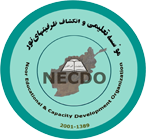
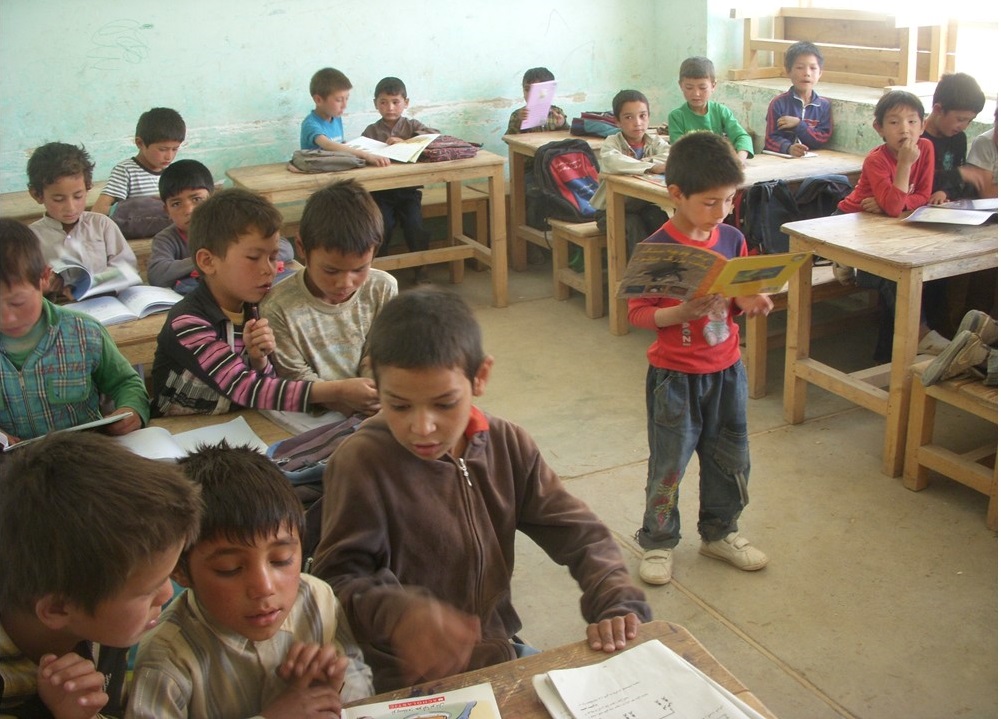
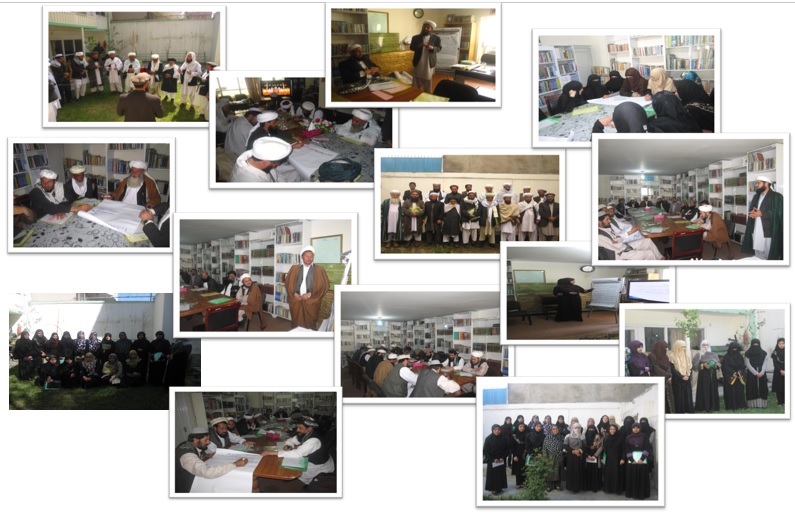
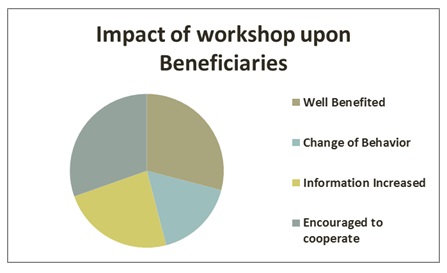
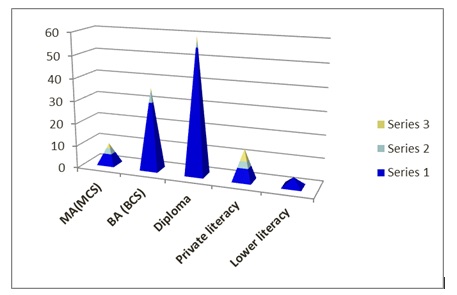
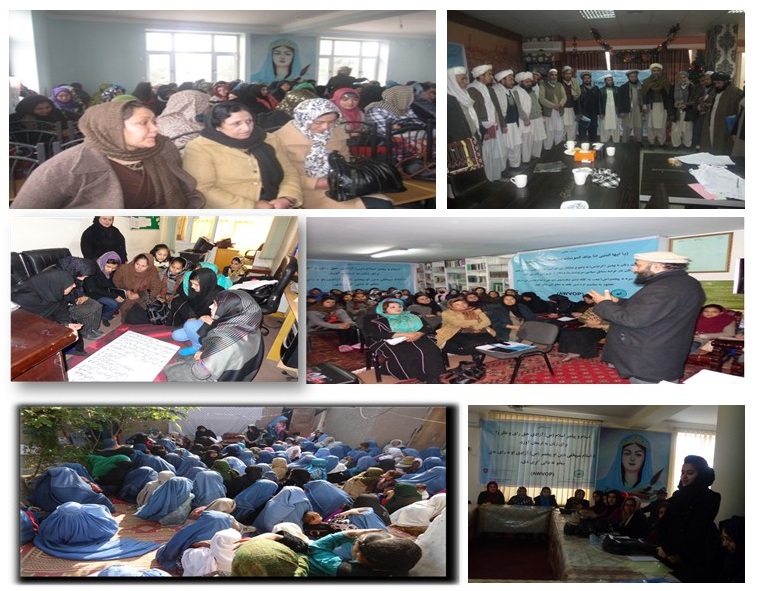
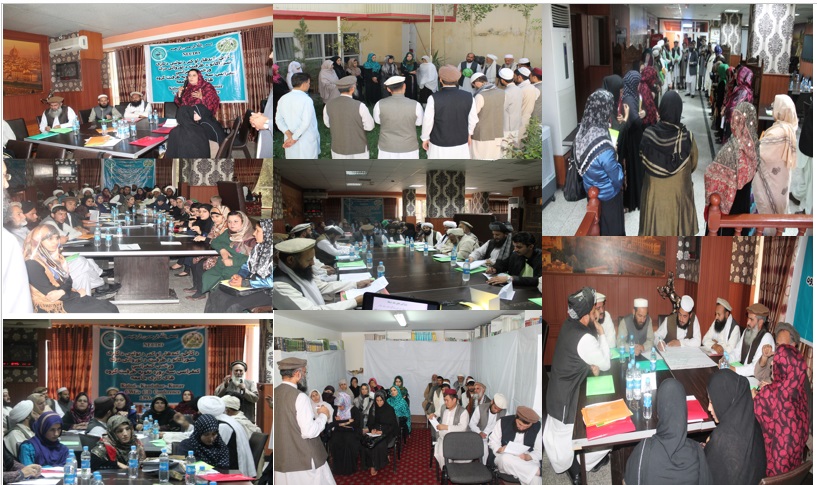
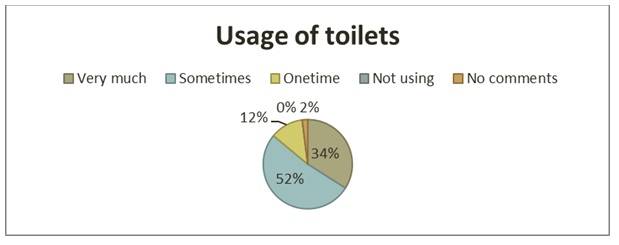
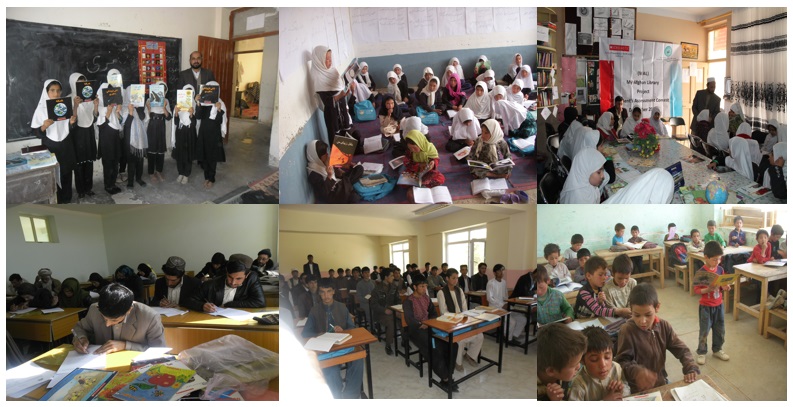
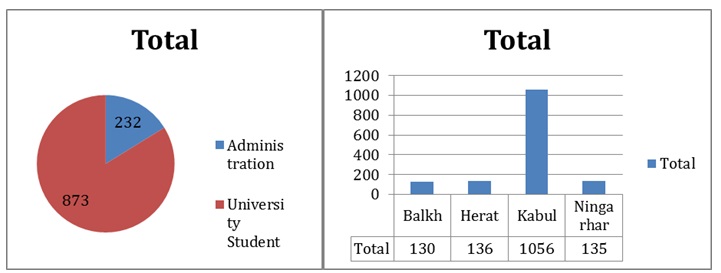
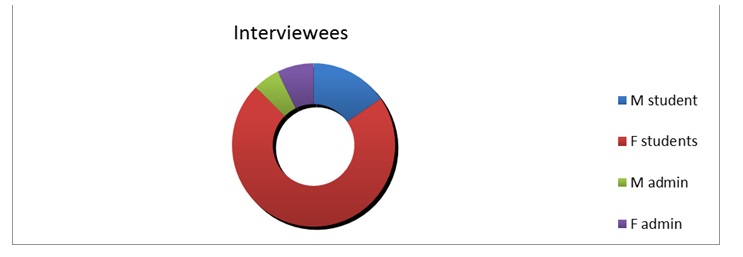
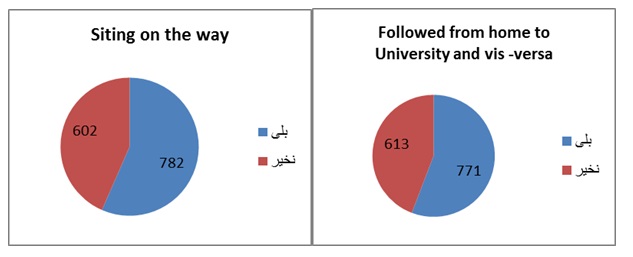
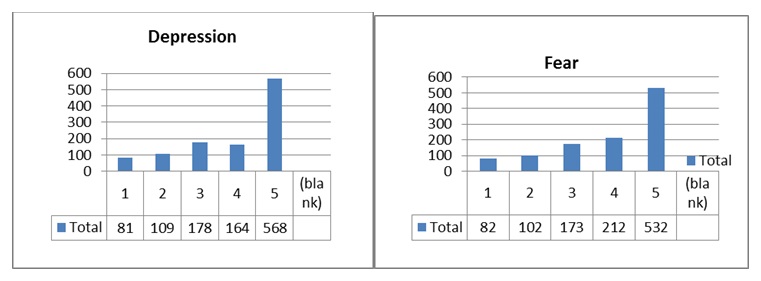
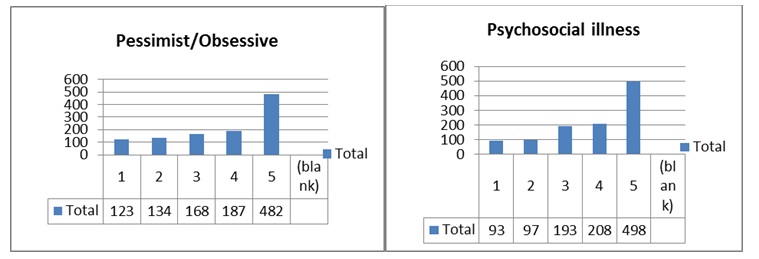

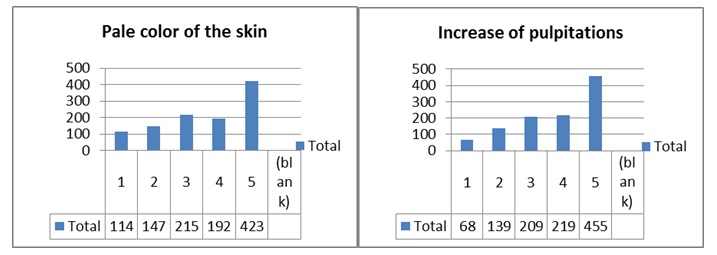
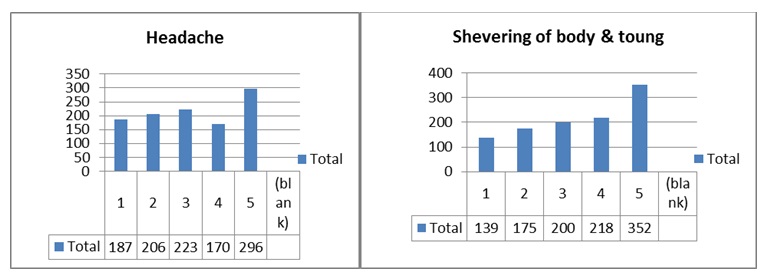

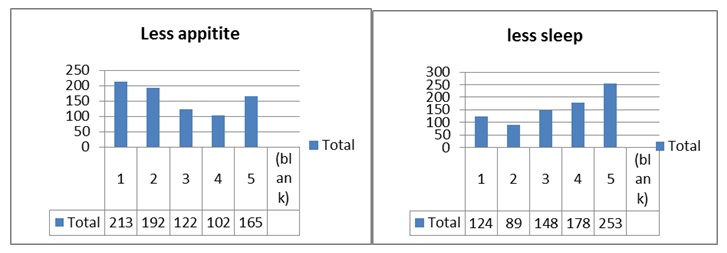
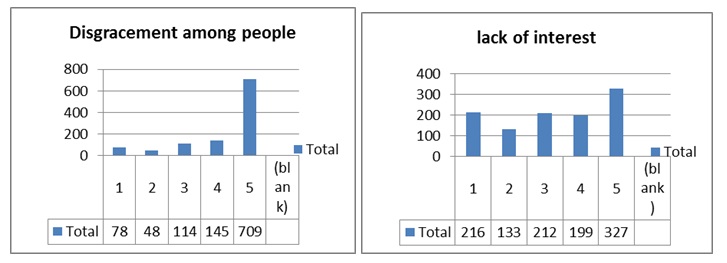

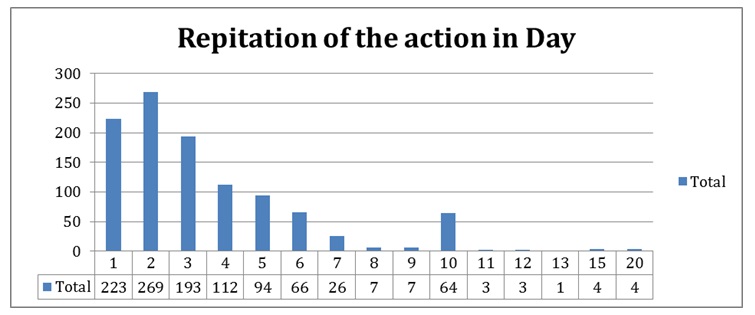
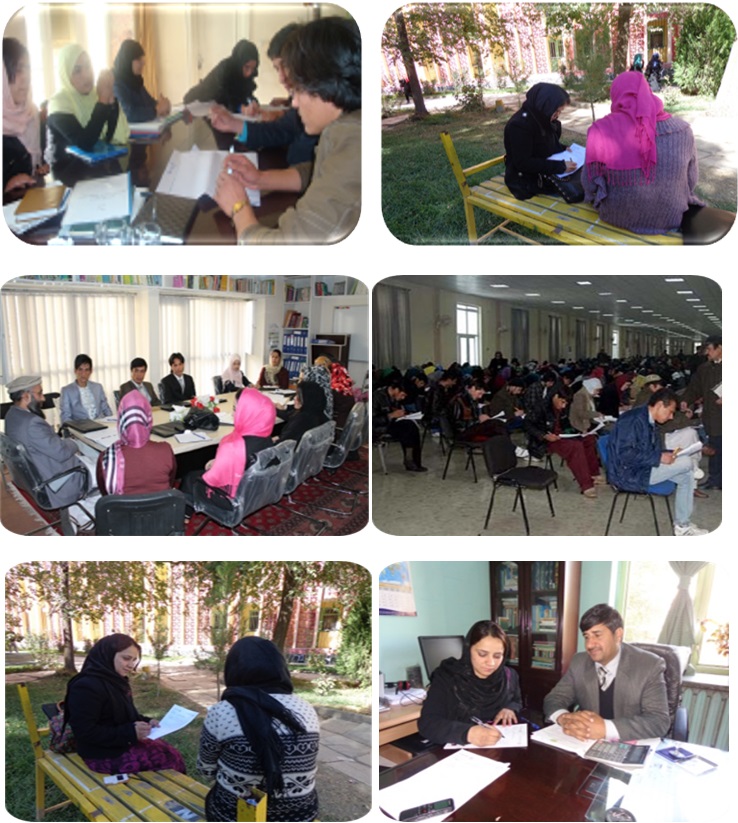
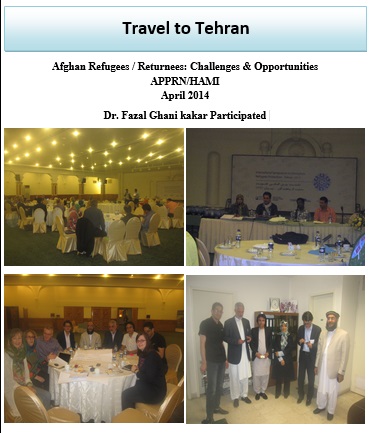
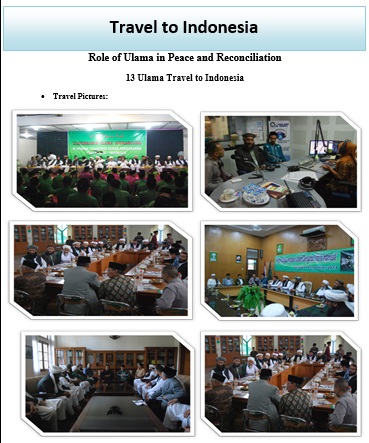
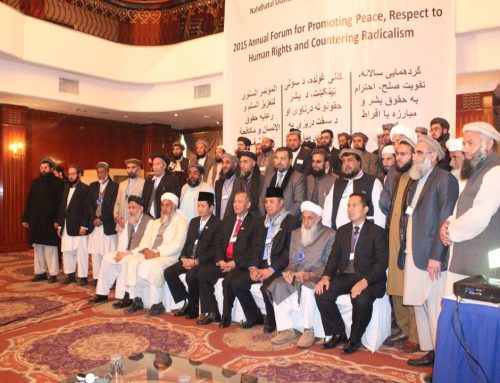
[…] [i] “Annual Report 2014: 6.7 Post-test findings”. Noor Educational and Capacity Development Organization . 2014. Accessed August 17, 2015. […]